WELCOME
Thank you for purchasing Grandstream GWN7000 Enterprise Multi-WAN Gigabit VPN Router.
The GWN7000 is a powerful enterprise-grade multi-WAN Gigabit VPN router. Ideal for the enterprise, small-to-medium business, retail, education, hospitality and medical markets, the GWN7000 supports comprehensive Wi-Fi network management software and VPN solutions that can be shared across one or many different physical locations. It features high-performance routing and switching power and a hardware-accelerated VPN client/server for secure inter-office connectivity. To maximize network reliability, the GWN7000 supports traffic load balancing and failover. The GWN7000 features an integrated controller and automated provisioning master that can setup and manage up to 300+ in-network GWN series Wi-Fi Access Points. This can be easily operated through the product’s intuitive web browser user interface, which also offers a central panel to monitor and control the entire network.
PRODUCT OVERVIEW
Technical Specifications
Table 1: GWN7000 Technical Specifications
|
Network Interfaces |
|
|
WAN |
|
|
LAN |
|
|
Auxiliary Ports |
|
|
Routing Performance |
|
|
USB |
|
|
Network Protocols |
|
|
VPN |
|
|
LED |
|
|
Mounting |
|
|
QoS |
|
|
Firewall |
|
|
Auto Provisioning Capability |
|
|
Management |
|
|
Power |
|
|
Environmental |
|
|
Physical |
|
|
Package Content |
|
|
Compliance |
|
INSTALLATION
Before deploying and configuring the GWN7000, the device needs to be properly powered up and connected to the network. This section describes detailed information on installation, connection and warranty policy of the GWN7000.
Equipment Packaging
Table 2: GWN7000 Equipment Packaging
|
Main Case |
Yes (1) |
|
Power adaptor |
Yes (1) |
|
Quick Installation Guide |
Yes (1) |
|
GPL License |
Yes (1) |
Connect your GWN7000
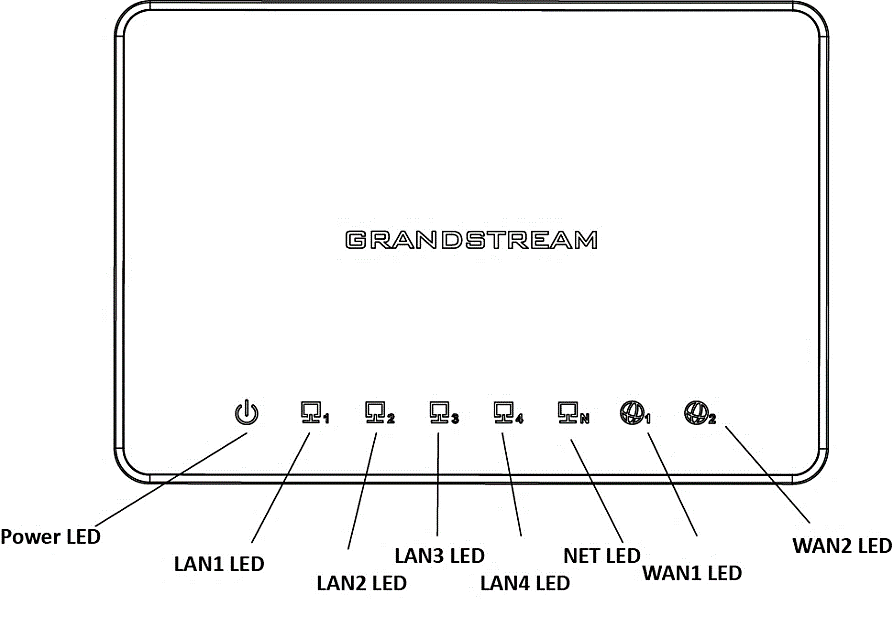

To set up the GWN7000, follow the steps below:
- Connect one end of an RJ-45 Ethernet cable into the WAN1 or/and WAN2 port(s) of the GWN7000.
- Connect the other end of the Ethernet cable(s) into a DSL modem or router(s) as an uplink to ISP.
- Connect the 12V DC power adapter into the power jack on the back of the GWN7000. Insert the main plug of the power adapter into a surge-protected power outlet.
- Wait for the GWN7000 to boot up and connect to internet/network. In the front of the GWN7000 the Power LED will be in solid green, and the WAN LED will flash in green indicating data transmission.
- Connect one of the LAN ports to your computer, the associated LED ports will flash in green.
- (Optional) Connect LAN port(s) to your LAN, including GWN76XX access points and other devices, the associated LED port(s) will flash in green.
Safety Compliances
The GWN7000 Enterprise Router complies with FCC/CE and various safety standards. The GWN7000 power adapter is compliant with the UL standard. Use the universal power adapter provided with the GWN7000 package only. The manufacturer’s warranty does not cover damages to the device caused by unsupported power adapters.
Warranty
If the GWN7000 Enterprise Router was purchased from a reseller, please contact the company where the device was purchased for replacement, repair or refund. If the device was purchased directly from Grandstream, contact our Technical Support Team for an RMA (Return Materials Authorization) number before the product is returned. Grandstream reserves the right to remedy warranty policy without prior notification.
GETTING STARTED
The GWN7000 Enterprise Router provides an intuitive web GUI configuration interface for easy management to give users access to all the configurations and options for the GWN7000’s setup.
This section provides step-by-step instructions on how to read LED indicators and use Web GUI interface of the GWN7000.
LED Indicators
The front panel of the GWN7000 has LED indicators for power and interfaces activities, the table below describes the LED indicators status.
LED | Status | Indication |
POWER | OFF | GWN7000 is powered off or abnormal power supply. |
Solid green | GWN7000 is powered on correctly. | |
WAN (1,2) | Flashing green | GWN7000 is connected as a client to another network and data is transferring. |
Solid green | GWN7000 is connected as a client to another network and there is no activity. | |
LAN (1,2,3,4,5) | Flashing green | A device is connected to the corresponding LAN port and data is transferring. |
Solid green | A device is connected to the corresponding LAN port and there is no activity. |
Use the WEB GUI
Access WEB GUI
The GWN7000 embedded Web server responds to HTTPS GET/POST requests. Embedded HTML pages allow users to configure the device through a Web browser such as Microsoft IE, Mozilla Firefox, Google Chrome.

To access the Web GUI:
- Connect a computer to a LAN Port of the GWN7000.
- Ensure the device is properly powered up, and the Power, LAN port LEDs light up in green.
- Open a Web browser on the computer and enter the web GUI URL in the following format:
https://192.168.1.1 (Default IP address). - Enter the administrator’s login and password to access the Web Configuration Menu. The default administrator’s username and password are “admin” and “admin”.
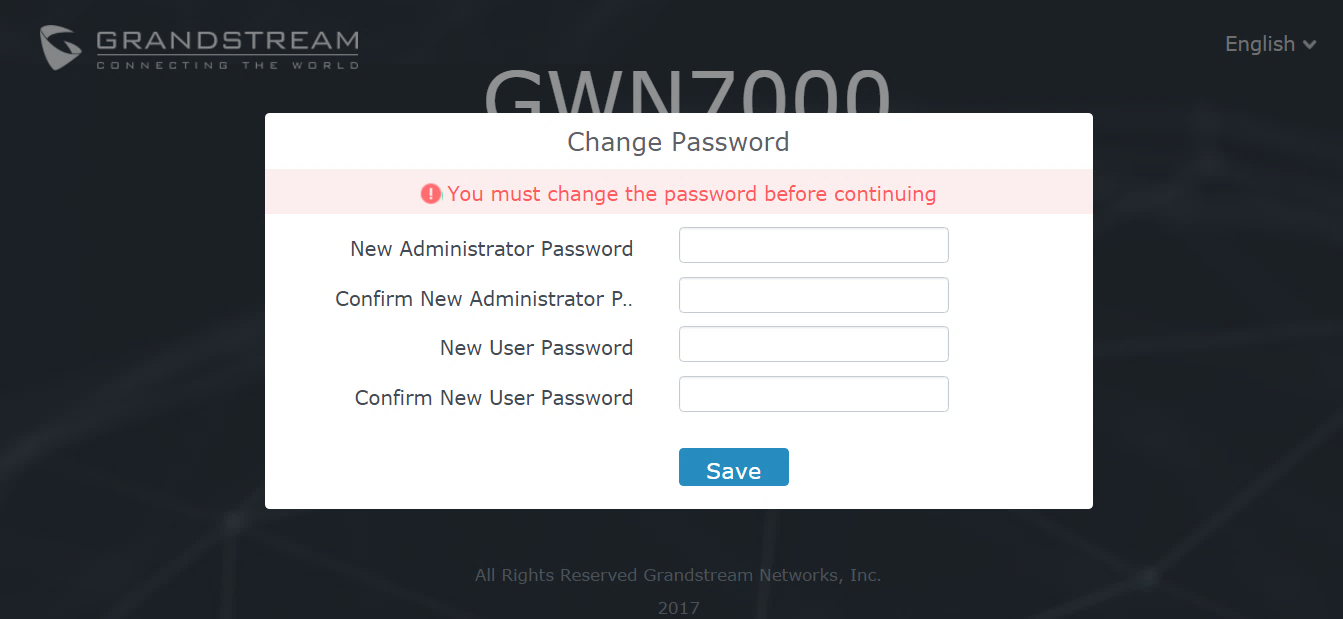
At first login, a Setup Wizard tool will pop up to help going through the configuration setup, or exit to configure manually. Setup Wizard can be accessed anytime by clicking on while on the web interface.
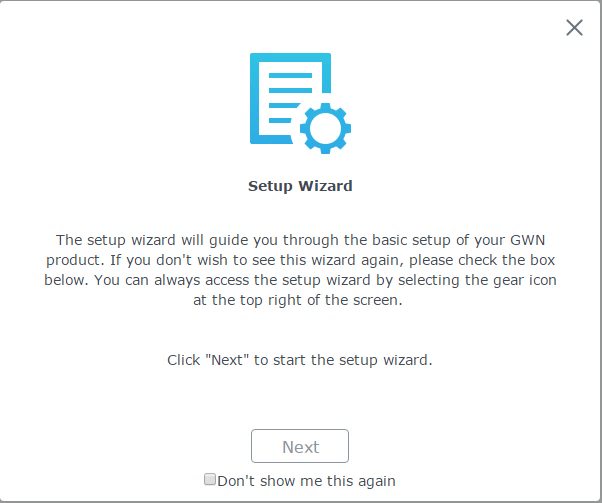
WEB GUI Languages
Currently the GWN7000 series web GUI supports English and Simplified Chinese.
To change default language, select the displayed language at the upper right of the web GUI either before or after logging in.
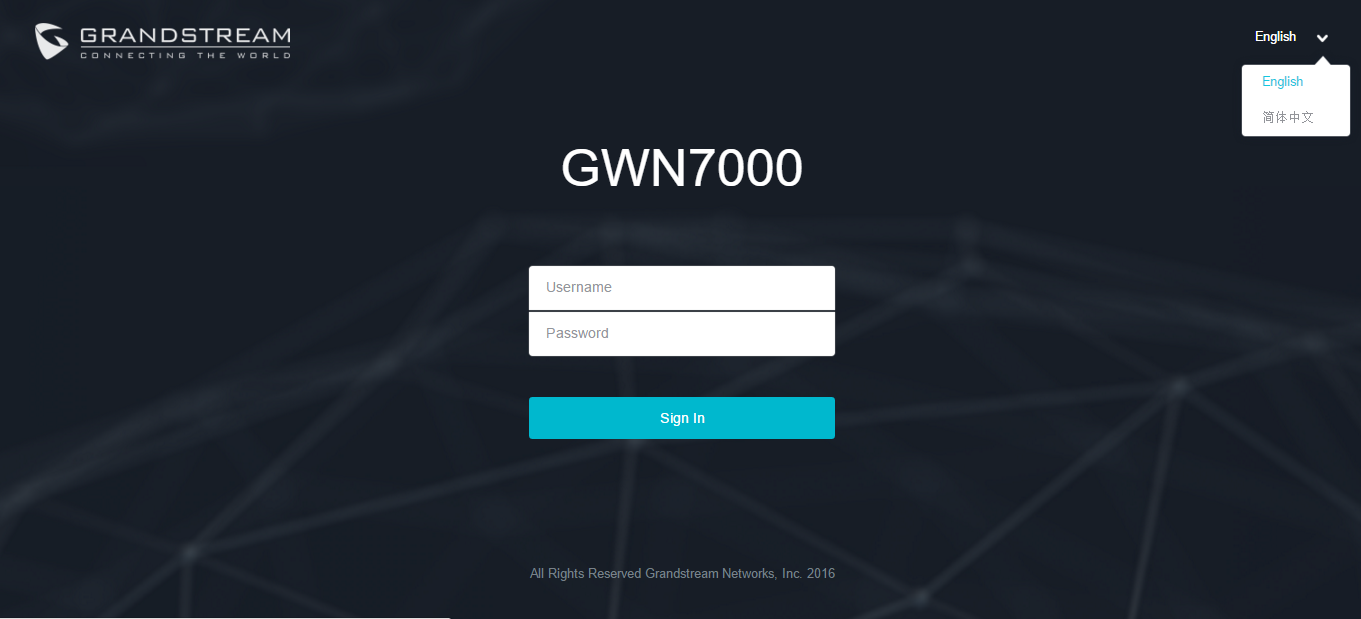

WEB GUI Configuration
GWN7000 web GUI includes 8 main sections to configure and manage the router and check connection status.
- Overview: Provides an overall view of the GWN7000’s information presented in a Dashboard style for easy monitoring.
- Router: Displays device’s status and used to configure ports settings such as IP configuration for WAN ports, load balancing, failover, static routes, switch port mirroring, QoS and DDNS.
- Routing: Gives the admin the possibility to configure static routing and policy-based routing.
- Access Points: To add, pair and manage discovered access points.
- SSIDs: To add and manage wireless network SSIDs using paired access points via VLANs.
- Clients: Shows and manages the list of the clients connected to LAN ports of the GWN7000 and wireless clients connected via GWN76xx access points.
- VPN: Configures OpenVPN® Client/Server, PPTP, IPSec and L2TP/IPSec client tunnels.
- Firewall: Basic and advanced Firewall configuration to securely manage router’s incoming/outgoing traffic.
- Captive Portal: Configuration settings for the captive portal feature.
- Bandwidth Rules: Configures the bandwidths rules that allows users to limit bandwidth utilization per SSID or client (MAC address or IP address).
- System Settings: For Maintenance and debugging features, as well as generating certificates and file sharing.
Overview Page
Overview is the first page shown after successful login to the GWN7000’s Web Interface. It provides an overall view of the GWN7000’s information presented in a Dashboard style for easy monitoring.
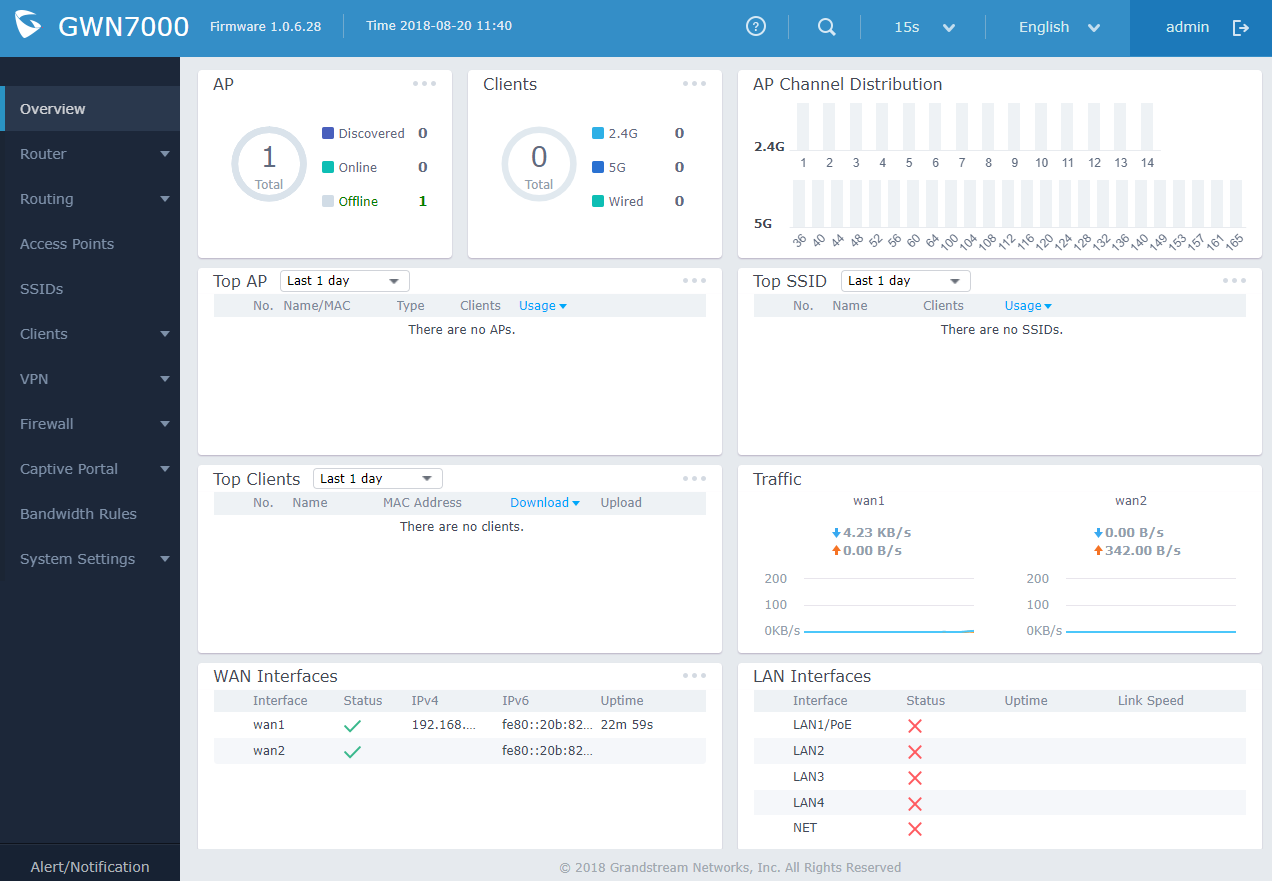
It is used to show the status of the GWN7000 for different items, please refer to the following table for each item:
|
AP |
Shows the number of Access Points that are Discovered, Paired (Online) and Offline. Click on |
|
Clients |
Shows the total number of connected clients, and a count for clients connected to each Channel. Click on |
|
AP Channel Distribution |
Shows the Channel used for all APs that are paired with this Access Point. |
|
Top AP |
Shows the Top APs list, assort the list by number of clients connected to each AP or data usage combining upload and download. Click on |
|
Top SSID |
Shows the Top SSIDs list, assort the list by number of clients connected to each SSID or data usage combining upload and download. Click on |
|
Top Clients |
Shows the Top Clients list, assort the list of clients by their upload or download. Click on |
|
Traffic |
Shows the sent/received traffic data speeds on both WAN ports. |
|
WAN Interfaces |
Shows the status of the wan interfaces (IP, Uptime, status …etc). |
|
LAN Interfaces |
Displays the status of the LAN interfaces, which includes also the NET port. This will display the connection status, the uptime, and the link speeds. |
Note that Overview page in addition to other tabs can be updated each 15s, 1min, 2min, 5min or Never by clicking in the upper bar menu (Default is 15s).
Save and Apply Changes
When clicking on “Save” button after configuring or changing any option on the web GUI pages. A message mentioning the number of changes will appear on the upper menu.

Click on button to apply changes, or
to undo the changes.
The router will reload all necessary services in order to for the changes to take effect.
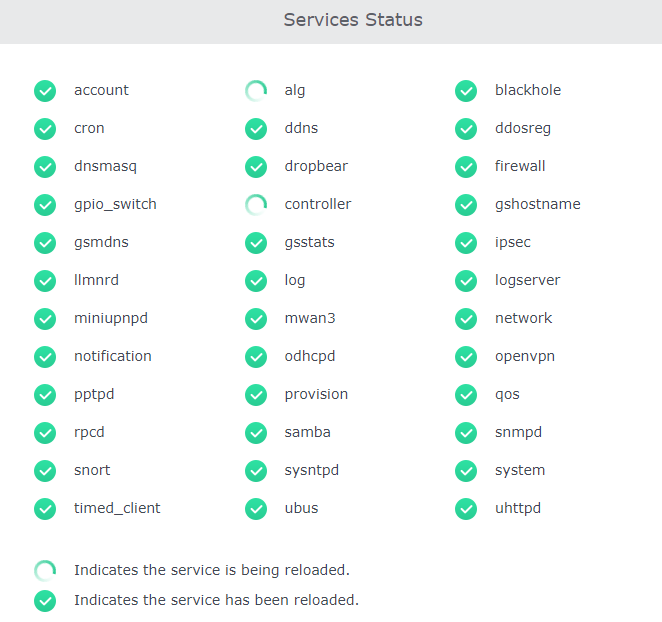
ROUTER CONFIGURATION
This section includes configuration pages for network WAN ports, LAN ports, QoS, DDNS, DPI and shows also the router status.
Status
Status page displays Device Status to check MAC address, Part Number, Firmware related information and Uptime for the GWN7000; and WAN Status showing general information about WAN Ports such as uptime, current throughput, aggregate usage, and IP address and also the application traffic.
Router’s Status page can be accessed from Web GUI 🡪 Router 🡪 Status.
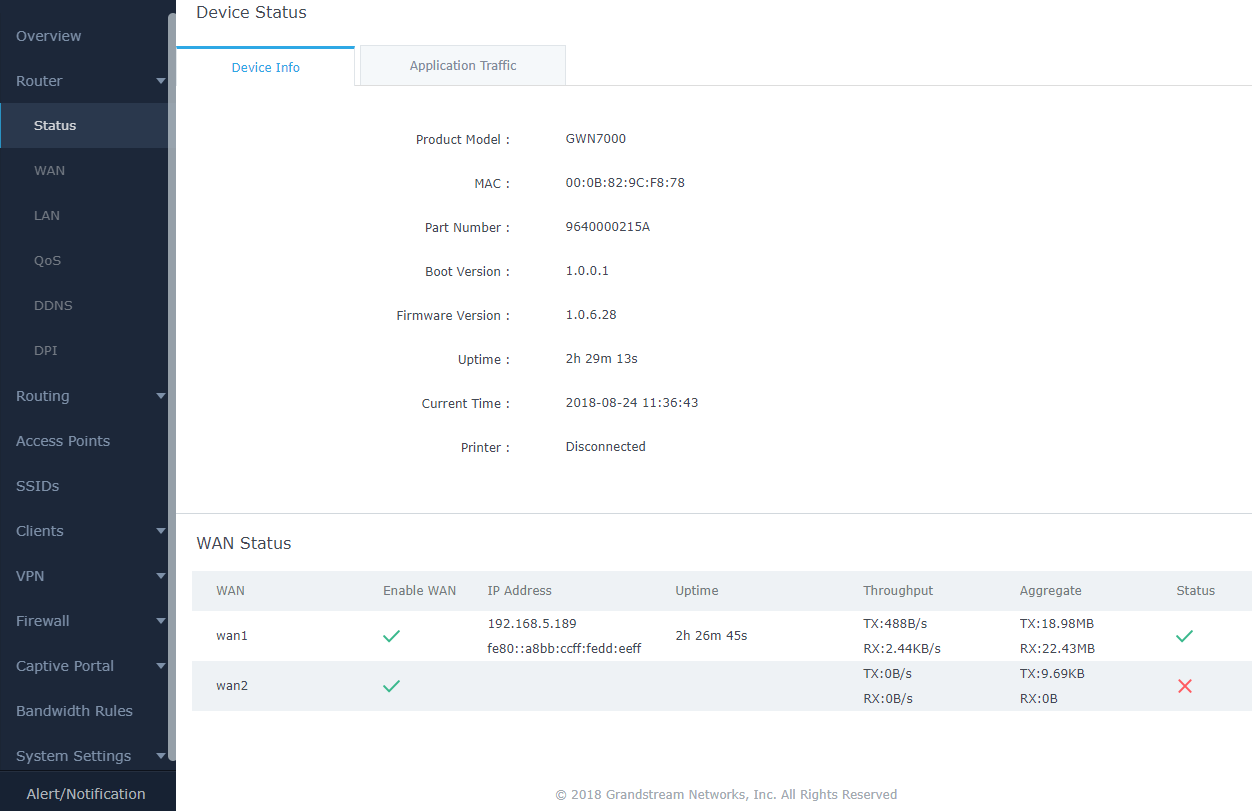
Router Configuration
Connect to GWN7000’s Web GUI from a computer connected to a LAN port and go to Router🡪WAN page for Port configuration.
WAN Ports Settings
The GWN7000 has 2 WAN ports configured as DHCP clients by default. Each port can be connected with DSL modem or routers. WAN ports support also setting static IPv4/IPv6 addresses and configure PPPoE for each WAN port. Please refer to the following table for basic network configuration parameters on WAN ports for GWN7000.
Table 5: GWN7000 WEB GUI🡪Router🡪WAN🡪WAN Port (1,2)
Additional WAN Port
Users have the ability to create virtual wan interfaces that would be mapped with a specific physical wan port (either WAN1 or 2 or NET port when configured as WAN port) and use VLAN tags for each additional wan port.
NET Port
This page allows for the configuration of NET port, which can be used either as LAN port or WAN port. Below are the available options to configure the NET port.
|
Enable LAN1 (NET Port) |
Enable the NET port as a normal LAN port. |
|
Enable WAN (Net Port) |
Enable the NET port as a WAN port, and set the required configuration as WAN1 and 2. See Table 5: GWN7000 WEB GUI🡪Router🡪WAN🡪WAN Port (1,2) |
Tunnel
Tunnel page is used to set IPv6 tunnels on WAN ports via IPv6 tunnel brokers service providers, this serves the purpose of transferring IPv6 packets over IPv4 Network. It supports creating 6in4, 6rd, AICCU and GRE tunnels. Please refer to below tables for each tunnel type.
|
WAN Interface |
Choose the WAN port on which to setup the 6in4 tunnel. |
|
MTU |
Set the Maximum Transmission Unit value. The valid range is 64-9000. Default value is 1500. |
|
6in4 IPv4 Peer Address |
Enter the IPv4 tunnel endpoint at the tunnel’s provider. |
|
6in4 Tunnel Endpoint IPv6 Address |
Enter the local IPv6 address delegated to the tunnel endpoint. Example: 2001:db8:2222::2/64 |
|
6in4 Routed Prefix |
Set the routable prefix given by the tunnel provider to allow LAN clients to get addresses from that prefix. |
|
Tunnel ID |
Specifies the tunnel’s ID. |
|
Username |
Set the username used to login into the tunnel broker. |
|
Password |
Set the password (used for endpoint update). |
|
Update Key |
Set the update key, it overrides the password used for endpoint update. |
|
WAN Interface |
Choose the WAN port on which to setup the 6rd tunnel. |
|
MTU |
Set the Maximum Transmission Unit value. The valid range is 64-9000 and default value is 1500. |
|
6rd IPv4 Peer Address |
Enter the IPv4 Peer address. |
|
6rd IPv6 Address Prefix |
Specifies the IPv6 prefix given by the provider. |
|
IPv6 Prefix Length |
Specifies the IPv6 prefix length (Value between 1 and 128). |
|
IPv4 Prefix Length |
Specifies the prefix length of the IPv4 transport address. (Value between 1 and 32). |
|
WAN Interface |
Choose the WAN port on which to setup the aiccu tunnel. |
|
Username |
Enter the Username (Provided by signing up with SixXS Tunnel Broker) |
|
Password |
Enter the Username’s password |
|
WAN Interface |
Specifies the WAN interface to bind the tunnel to. |
|
Name |
Set a name for the tunnel connection. |
|
Enabled |
Enabled/Disable the tunnel connection. |
|
GRE Peer IP Address |
Specifies the tunnel destination address (public IP). |
|
GRE Tunnel IP Address |
Specify the local GRE tunnel interface. (ex: 10.1.1.2) |
|
GRE Tunnel Netmask |
Set the Tunnel interface netmask. (ex: 255.255.255.0) |
|
MTU |
Configures the maximum transmission unit. The valid range is 64-9000 and the default is 1500. |
|
Subnet |
Set the destination subnet that is reachable though GRE tunnel. |
|
IP Masquerading |
Enable/Disable IP masquerading. Users could configure this option under the “General” tab of Firewall 🡪 Advanced as well. |
|
Tunnel Input Key |
Specifies the key that would be added to the incoming packets. |
|
Tunnel Output Key |
Specifies the key that would be added to the outgoing packets. |
Global Settings
This section specifies operating mode for multi-WAN that will be used for enabling/disabling Failover and Load Balancing on WAN ports and using MAC override address.
The following table shows the configuration parameters for global WAN settings
Table 11: GWN7000 WEB GUI🡪Router🡪Port🡪Global Settings
|
Local Routing Policy |
Specifies the routing policy that would be applied on locally generated traffic from the GWN7000 router. See [Policy Routing] section. |
|
MAC Override Address |
This option is used to override the MAC address of the GWN7000 Router. MAC Address octets (in hex) are separated by “:” in English input condition. The characters here must be lowercase. Note: Reboot the router to take effect. |
Switch Configuration
LAN
GWN7000 supports creating up to 16 different LAN groups separated as VLANs with the possibility to add and pair GWN76xx Access Points to each LAN which is mapped to an SSID by VLAN tagging.
To access LAN configuration page, log in to the GWN7000 WebGUI and go to Router 🡪 LAN.

The GWN7000 will have a default group named group0, click on to edit it, or click on “Add” to add a new LAN subnet.
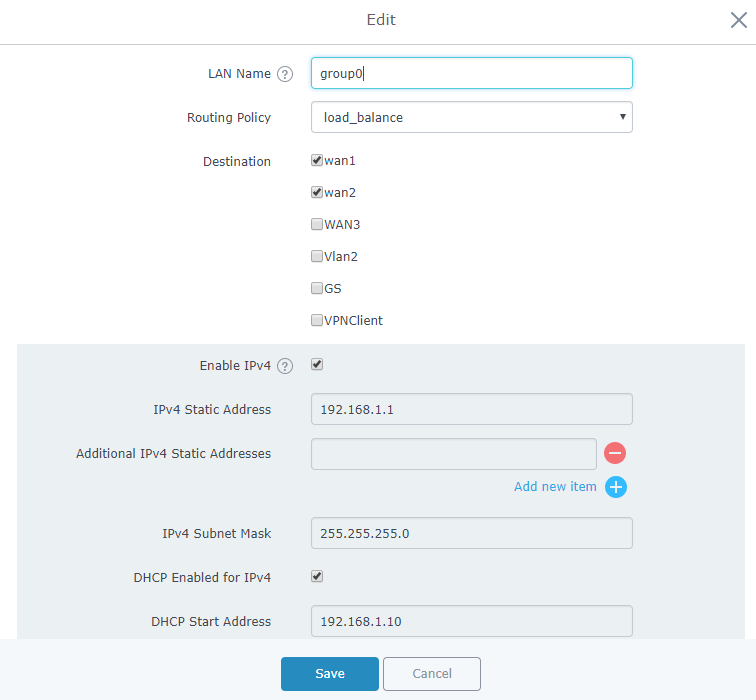
Following table gives description for the parameters available to configure LAN groups:
|
LAN Name |
Specifies the name for the LAN group. |
|
Enabled |
Check to activate the newly created LAN group. |
|
Routing Policy |
Select which routing to use for this LAN network. See Policy Routing section for more details. |
|
Destination |
If enabled, choose which groups you want to forward, if not, you can manually configure the forward rules under firewall settings. |
|
Configure the LAN port membership. If choose lan1 (NET Port), please make sure you have enabled lan1 under Router🡪 WAN🡪 NET port Tab. | |
|
VLAN |
Check to enable VLAN. This field is appearing only when having more than one LAN subnet. |
|
VLAN ID |
Set a VLAN ID. Valid range is between 2 and 4093. |
|
Enable IPv4 |
Check to enable IPv4 addressing for this LAN. |
|
Ipv4 Static Address |
Set a static Ipv4 address for the LAN subnet when enabling Ipv4. |
|
Set an additional static Ipv4 address for the LAN subnet when enabling IPv4. | |
|
Ipv4 Subnet Mask |
Set the Subnet Mask. |
|
DHCP Enabled for Ipv4 |
Check to enable DHCP using Ipv4. This will allow clients connected to this LAN subnet to get Ipv4 addresses automatically from GWN7000 acting as DHCP server. |
|
DHCP Start Address |
Set the starting Ipv4 address for this LAN’s clients. |
|
DHCP End Address |
Set the ending Ipv4 address for this LAN’s clients |
|
DHCP Lease Time |
Set the lease time for DHCP clients, the value can be defined in hours, minutes, or as “infinite”. Default lease time is “12h”. |
|
DHCP Options |
Set the DHCP options. Click on |
|
DHCP Gateway |
Defines the IP address of the DHCP gateway. |
|
DHCP Preferred DNS |
Set the preferred DNS Servers via DHCP. |
|
DHCP Alternate DNS |
Set the alternate DNS Servers via DHCP. |
|
DHCPv4 Relay Enabled |
Enable this option, if you want the GWN7000 relays the DHCP requests from clients to another DHCP server(s). Once checked, click |
|
Enable IPv6 |
Check to enable IPv6 addressing for this LAN subnet. |
|
IPv6 Relay from WAN |
Check to allow GWN7000 to relay IPv6 DHCP request from LAN’s clients to WAN port. |
|
DHCP Enabled for IPv6 | Check to enable IPv6 DHCP server for this LAN. |
|
IPv6 Prefix for Assignment |
Set the prefix value to be assigned to the LAN. Valid range is between 1 to 64. Example: 64 will assign /64 prefixes. |
|
IPv6 Subnet Hint |
Set the subnet mask value. |
|
IPv6 Uplink |
Select the WAN port. |
Static DHCP
Users can use the feature in order to set static DHCP binding to certain clients, to whom you do not want the IP address to change.
In order to configure Static DHCP, please follow below steps:
- Go under the menu “Router 🡪 LAN 🡪 Static DHCP”.
- Click
button to create a new entry.
- Enter the name of the device, along with its MAC address and IP address.
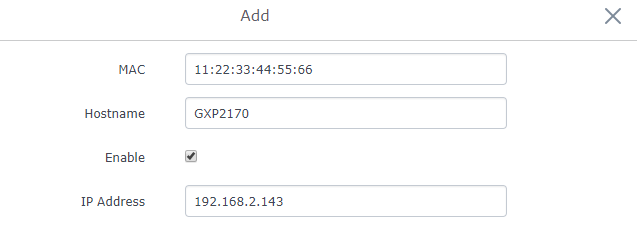
4. Press Save and Apply to submit the changes.

Switch
Under switch configuration menu, admin users can enable port mirroring and the GWN7000 will send a copy of all network packets seen on one LAN port to another port, where the packet can be analyzed. Refer to the below table for the available fields to configure.
Also, users can have flexibility in configuring the mapping for each LAN port to have 802.1q VLAN tags included or excluded from Ethernet frames sent out by the port, in case the tag is needed users can simply enable it by editing the option custom port mapping.
|
Enable Outgoing Mirroring |
Check to enable outgoing mirroring for a LAN port. Default is “Disabled” |
|
Enable Incoming Mirroring |
Check to enable incoming mirroring for a LAN port. Default is “Disabled” |
|
Mirroring Port |
Select which LAN port that will be mirroring traffic. Default is “Disabled” |
|
Mirrored Port |
Select which LAN port that will act as mirrored port. Default is “Disabled” |
|
Use Custom Port Mapping |
Use this option in order to enable VLAN tagging on the ports or disable it or block the port from participating in the selected VLAN, click on Three options are available for each port:
|

QoS
The GWN7000 offers the possibility to enable and configure QoS on WAN interfaces, this will help to manage in more depth the network traffic to define priority and classify different services and protocols in an efficient manner.
Also, the GWN provides the capabilities to configure advanced QoS features such as Active Congestion Control (ACC) in order to avoid bottleneck on the network, especially when using VoIP.
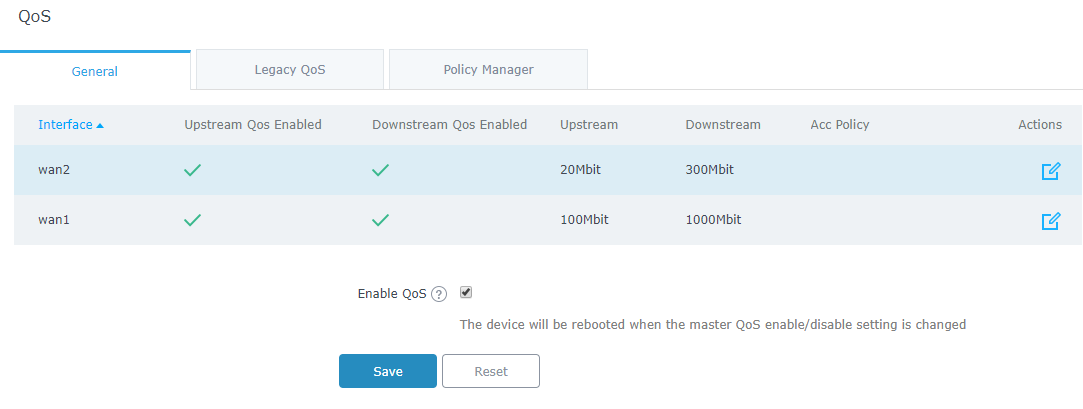
To activate QoS, check “Enable QoS” option. Three tabs are available for configuration:
- General: Download and upload bandwidth speeds settings on each WAN interface as well as setting the smart queue parameters which will allow to select the queuing mode on each wan interface. The smart queue is an integrated network system that performs better per-packet/per flow network scheduling, reduces the buffer bloat and keeps latency at acceptable levels. The users can from this menu select which QoS mode to use on each WAN interface (either ACC, SQM or Legacy QoS).
- Legacy QoS: Legacy QoS allows creating Traffic Classes to prioritize traffic for specific resources on the network by controlling transmission/upload rate. Note that different classes can be created and assigned as Traffic filters by respecting following conditions:
- The total of Upstream bandwidth values of each created class should not exceed the upstream bandwidth value configured in General.
- The remaining bandwidth will be lent to the next priority level of class.
- All filter options are summed together.
- While Upstream QoS is dealing with traffic transmission, Policer is controlling the incoming traffic. Thus, allowing to create rules to specific targets to set priority and received traffic rate, giving the GWN the ability to drop the exceeding traffic when reaching the max rate.
- Policy Manager: On this menu the user can configure multiple QoS policies in order to apply them on the WAN interface when selecting QoS type as ACC (Adaptive Congestion Control), this feature combines the power of the original legacy class based QoS, while adding true ingress shaping, and reducing the configuration difficulty. Traditional QoS systems rely on the actual bandwidth provided by the ISP to remain constant, they also require you to set the link rate below what the ISP provisions your link, which leaves the link underutilized. The ACC QoS solves this problem. The ACC QoS also features the anti-buffer bloat and flow fairness of the Smart Queue QoS. Beyond that, the new QoS allows for defining classes so that flows that are latency sensitive and/or need a minimum amount of bandwidth can be placed int, this is extremely useful for VoIP traffic.
Refer to the following tables for each tab option:
|
Up/Down Stream QoS Enabled |
Check to enable upstream and downstream bandwidth speeds for the selected WAN interface. |
|
Upstream |
Set the Upstream value to specify the upload bandwidth for selected interface, the value should end with Mbit. Note that the set value will affect and limit the bandwidth values on created classes on QoS Upstream. 100Kbit |
|
Downstream |
Set the Downstream value to specify the download bandwidth speed for selected interface, the value should end with “Mbit”, “Kbit” or with no unit if the set value is referring to “bit” unit. |
|
Type |
Select which QoS method to apply on select WAN interface:
|
|
Qdisc |
Select which Queuing discipline method to use for QoS:
|
|
Manager |
Choose the type of the smart queue management:
|
|
Link-layer Adaptation |
Select the link-layer type for the WAN connection. This can be used to compensate for the link-layer overhead of certain types of WAN connections.
|
|
Overhead |
If the link-layer is set to something other than “none”, then the link-layer overhead setting can be used to specify how many bytes of overhead there are. Defaults are 8 for Ethernet, and 44 for ATM. |
|
Advanced Qdisc Options |
Check this option in order to show advanced Qdisc options to be used. |
|
Squash DSCP on ingress |
Select whether to squash or not the DSCP on ingress packets. By default, this option is disabled. |
|
Ignore DSCP on ingress |
Select whether to ignore DSCP on ingress packets or not. By default, this option is disabled. |
|
ECN Status on Inbound packets |
Select whether to set or not ECN status on inbound packets. |
|
ECN Status on outbound packets |
Select whether to set or not ECN status on bound packets. |
|
ACC Policy |
Select from the drop-down list the acc policy to apply, policies can be managed from the Policy Manager tab. This field appears only when Type is set to “acc”. |
|
Use Active Congestion Controller |
This Option must be enabled when using ACC (Adaptive Congestion Control) QoS type under the selected wan interface. This field appears only when Type is set to “acc”. |
|
Use Custom ping target |
Enter the IPv4 address of the target where the router will send ICM echo messages to track the health of the link (RTT measurements…etc). This field appears only when Type is set to “acc”. |
|
Target ping time limit (ms) |
Value that indicates the congestion on the ISP link, this is automatically calculated on the back end of the router, but users can override it. This field appears only when Type is set to “acc”. |
|
Traffic Class | |
|
Name |
Define a name for the traffic class. |
|
Priority |
Set the priority of the traffic class, the lower the value, the highest the priority. Valid range is between 1 and 64. |
|
Interface |
Select the WAN interface from which the traffic will be classified, make sure to enable the desired interface it from in order to appear. |
|
Upstream |
Set Upstream bandwidth value. The value should end with “Mbit”, “Kbit”. Note that the sum of created classes should have upstream bandwidth speeds lower than the Upstream bandwidth value configured on QoS Basic. |
|
Traffic Filter | |
|
Class |
Select a class from created traffic classes using drop-down menu. |
|
Name |
Define a Name for the traffic filter rule. |
|
DSCP |
Choose the Differentiated Services Code Point (DSCP) value from drop-down list. Default is 0. |
|
IP Source Address |
Specify the Source IP address from which the traffic filter rule will be applied. |
|
IP Destination Address |
Specify the Destination IP address to which the traffic filter rule will be applied. |
|
TCP Source Port |
Specify the TCP Source port from which the traffic filter rule will be applied. |
|
TCP Destination Port |
Specify the TCP Source port to which the traffic filter rule will be applied. |
|
UDP Source Port |
Specify the UDP Source port from which the traffic filter rule will be applied. |
|
UDP Destination Port |
Specify the UDP Source port to which the traffic filter rule will be applied. |
|
Group Source |
Choose the LAN group of the specified Source IP address. If no Source IP address has been defined, the rule will be applied to all members of that LAN group. |
|
Policer | |
|
Name |
Define a Name for the Policer rule. |
|
Interface |
Select an interface from which the traffic will be policed, make sure to enable the desired interface from General QoS in order to appear. |
|
Priority |
Set the priority of the traffic class, the lower the value, the highest the priority. Valid range is between 1 and 64. |
|
Rate |
Set a Rate value for download bandwidth when applying policer rule. |
|
DSCP |
Choose the Differentiated Services Code Point (DSCP) value from drop-down list. Default is 0. |
|
IP Source Address |
Specify the Source IP address from which the policer rule will be applied. |
|
IP Destination Address |
Specify the Destination IP address to which the policer rule will be applied. |
|
TCP Source Port |
Specify the TCP Source port from which the policer rule will be applied. |
|
TCP Destination Port |
Specify the TCP Source port to which the policer rule will be applied. |
|
UDP Source Port |
Specify the UDP Source port from which the policer rule will be applied. |
|
UDP Destination Port |
Specify the UDP Source port to which the policer rule will be applied. |
|
Group Source |
Choose the LAN group of the specified Source IP address. If no Source IP address has been defined, the rule will be applied to all members of that LAN group. |
Table 16: QoS Policy Manager (acc)
|
General | |
|
Name |
Define a name for the traffic policy which can be then select on general tab settings if settings the QoS type for a wan interface to acc (adaptive congestion control). |
|
Upload/Download 🡪 Policy Class | |
|
Name |
Set a name for the traffic class. |
|
Bandwidth share % |
Configure the bandwidth share percentage for this class of traffic, the acc mechanism will dynamically borrow bandwidth from other classes if one class needs more, thus using efficiently the available bandwidth. |
|
Set minimum bandwidth |
Enable this option to set the Minimum bandwidth for this traffic class. |
|
Min bandwidth |
Configure the minimum bandwidth reserved for this traffic class in Mbps or Kbps. |
|
Set maximum bandwidth |
Enable this option to set the Maximum bandwidth for this traffic class. |
|
Max bandwidth |
Configure the maximum bandwidth allowed for this traffic class in Mbps or Kbps. |
|
Minimize RTT (Only for Download Class) |
Enable this option in order to minimize traffic latency/delay 🡪 Useful for VoIP. |
|
Upload/Download 🡪 Policy Rule | |
|
Name |
Enter a name for the traffic rule 🡺 rules are used to put a traffic into a class. |
|
Enabled |
Used to enable/disable the traffic rule. |
|
Protocol |
Select the protocol for the traffic rule (TCP, UDP, TCP/UDP or ICMP). |
|
Src IP |
Set the source IP of the traffic to be matched. |
|
Src Port |
Set the source port number of the traffic to be matched. |
|
Dest IP |
Set the destination IP of the traffic to be matched. |
|
Dest Port |
Set the destination port number of the traffic to be matched. |
|
Min Pkt Size |
Configures the minimum packet size of the traffic that will be matched. |
|
Max Pkt Size |
Configures the minimum packet size of the traffic that will be matched. |
|
Class |
Select from the drop-down list the class where this traffic will be put, thus making all necessary bandwidth reservations for this traffic in respect of the configurations set under the class settings. |
DDNS
DDNS allows accessing GWN7000 via domain name instead of IP address, the GWN7000 supports following DDNS providers:
- Dyndns.org
- Changeip.com
- Zoneedit.com
- Freedns.afraid.org
- He.Net
- Dnsomatic.Com
- No-ip.pl
- Myonlineportal.net
- No-ip.com
Before configuring DDNS settings on the GWN7000, make sure first to create and confirm the DDNS account via supported providers.
Following steps illustrates how to configure the DDNS settings on your GWN7000:
- Access to GWN7000 web GUI, and navigate to Router🡪DDNS, and enable DDNS service.
- Fill in the domain name created with DDNS provider under Domain Name field.
- Enter your account username and password under Username and Password fields.
- Specify the WAN interface to which DDNS is applied under Network interface field.
- (Optional) For advanced configuration, it is also possible log to Syslog and modify the values of refreshing fields so to check periodically the updated IP address.
DPI
DPI stands for Deep Packet Inspection which is an option that allows the GWN7000 to analyze the core of the packet to collect and report information at the Application-layer, such as traffic volume of an application used by the host.
Snort OpenApp ID allows the System Administrator to view the internet traffic of users. The GUI displays traffic data in a human-readable format, such as ‘Streaming MP4 & Netflix – 31% of total traffic usage.’ The data is accompanied by a graph.
GWN7000 is using Snort for packet inspection and displays traffic status under Status🡪Application Traffic as shown on the figure below.
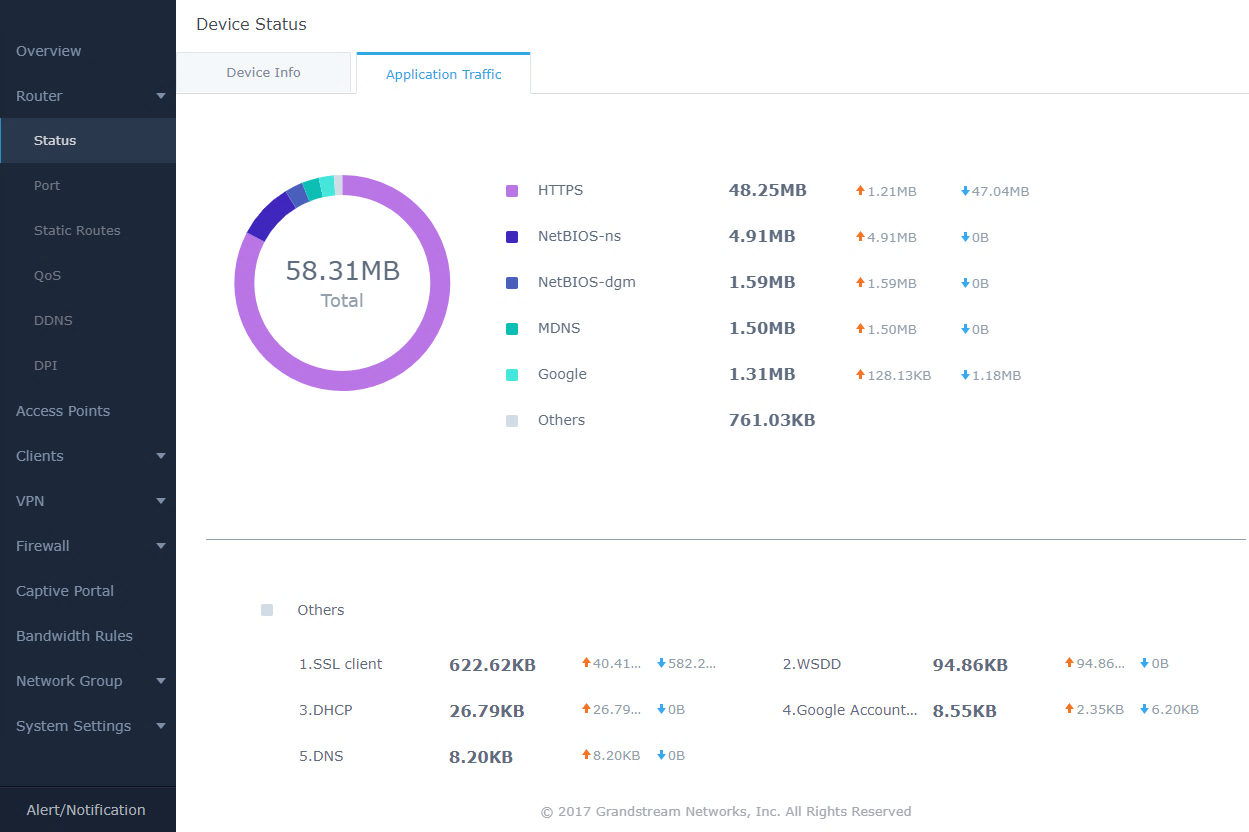
The following table contains the description of the DPI configuration settings.
|
Enable Application Tracking |
Enables the application tracking. By default, it’s disabled. |
|
Interface |
Select the interface on which the application tracking will be performed. By default, it’s WAN Port 1. |
Note: A reboot is required after enabling Depp packet inspection in order for the feature to take effect.
ROUTING
Static Routes
GWN7000 supports setting manually static IPv4 and IPv6 routes as well as displaying routing table entries.
Static routes configuration page can be accessed from GWN7000 WebGUI🡪Router🡪Static Routes:
Three tabs are available:
- Routes to view routing table entries.
- IPv4 to create, edit or delete static IPv4 static routes.
- IPv6 to create, edit or delete static IPv6 static routes.
Following actions are available in both IPv4 and IPv6 tabs:
- To add a new static route, click on
- To edit a static route, click on
- To delete a static route, click on
Refer to the following tables when editing or creating IPv4/IPv6 static routes:
|
Name |
Enter the Name of the static route to be configured. |
|
Enabled |
Select whether to enable or disable this static route. |
|
Interface |
Choose the LAN network or WAN port, which will be using this static route. |
|
Target Network/Host |
Enter the Network/Host IP address on which to route the traffic to. |
|
Netmask |
Enter the Network/Host Netmask. |
|
NextHop |
Enter the NextHop IP address. |
|
Metric |
Set the metric value. The valid range is 0-255. Default value is 0. |
|
Name |
Enter the Name of the static route to be configured. |
|
Enable |
Select whether to enable or disable this static route. |
|
Interface |
Choose the LAN network or WAN port, which will be using this static route. |
|
Target Network/Host |
Enter the Network/Host IP address on which to route the traffic to. |
|
NextHop |
Enter the Gateway’s IP address. |
|
Metric |
Set the metric value. The valid range is 0-255. Default value is 1. |
To check the routing table of the router, go under the Routes tab which displays all routes learned by the router.
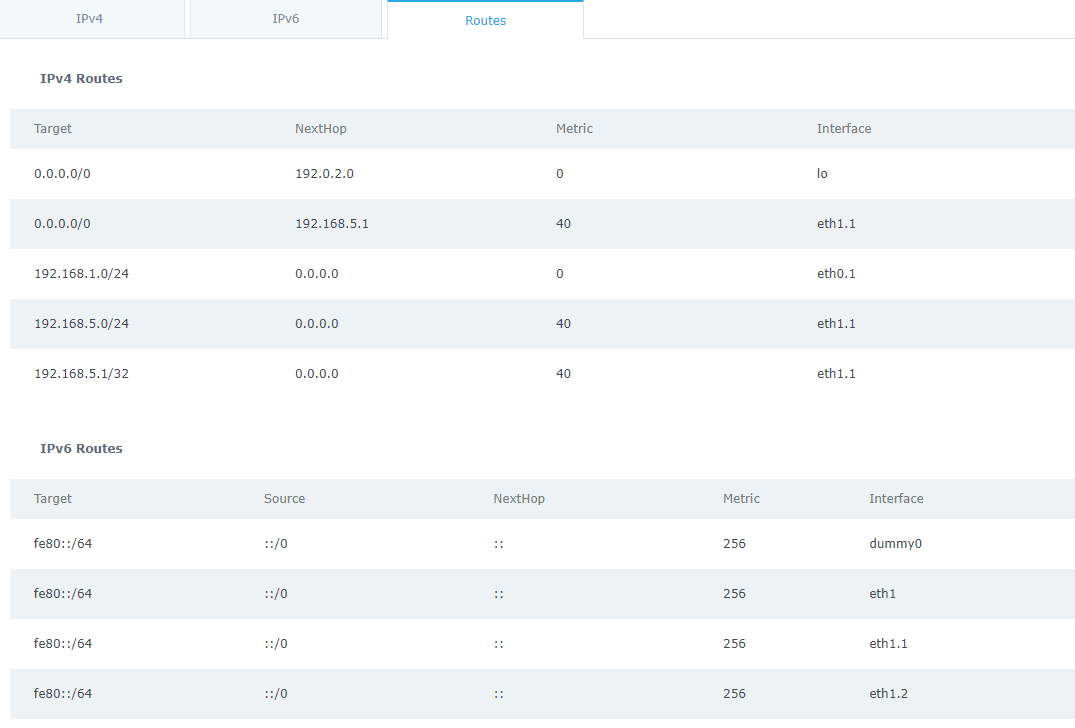
Policy Routing
Feature Overview
The Policy-based Routing feature allows a network administrator to make advanced routing decisions for traffic passing through the router. This feature allows for high granularity control over policies that dictate what WAN port, and even VPN tunnel, traffic should use. Traffic controlled this way can be balanced across multiple WANs or VPNs or to have complex failover designs.
Locally generated traffic can be globally routed via the policy selected under the menu “Router 🡪 WAN 🡪 Global Settings” in order to dictate to the router either to use failover or load-balancing for locally generated packets.
Creating/Configuring Routing Policies
The basic flow for traffic handled by policy-based routing in GWN7000 is as follows:
- Traffic matched with a specific iptables rule is marked to be used with a Policy.
- The policy contains a list of members that can be used by the policy.
- These members point to a specific interface and define a metric or weight assigned to them which can be used for determining load balancing and failover behavior.
- The interface can be any outgoing interface (WAN or VPN) and must be assigned a metric.
- The router then handles the routing of matched traffic to the appropriate routing tables for each member interface for that Policy.
In order to properly implement this feature, the old per-zone and per-wan routing table design has been removed and reworked to only use the main table. In addition, the Inter-group Traffic Forwarding is being removed in favor of automatically creating more configurable Firewall Forwarding rules.
In order to configure a new routing policy, first users need to create members under the menu Routing 🡪 Policy Routing 🡪 Members.
Click on button to create a new member, and configure its related metric and weight:
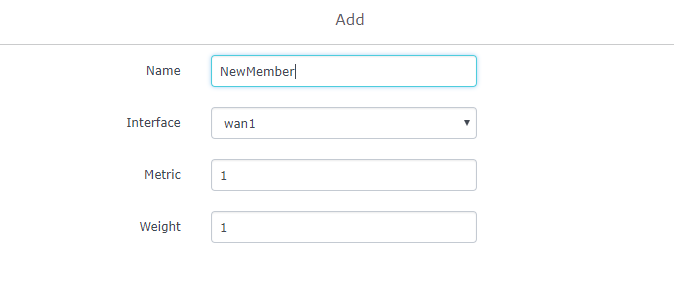
Table 20: Create Policy Members
|
Name |
Enter the Name for the member. |
|
Interface |
Select the interface to which the member points. |
|
Metric |
Enter the value of the metric related to the member (default is 1). |
|
Weight |
Enter the weight that will be attributed to the member, in case load balancing is used, this will indicate how much traffic will be routed via this member through the specified interface. Default value is 1. |
Note: By default, GWN7000 router will generate automatically members for each created/configured WAN interface and VPN client tunnel interface.
After this, users need to create policies which lists the members that will be used by each policy from the menu Routing 🡪 Policy Routing 🡪 Policy.
Click on button in order to create a new routing policy then choose the members that would be listed (included) on the policy.
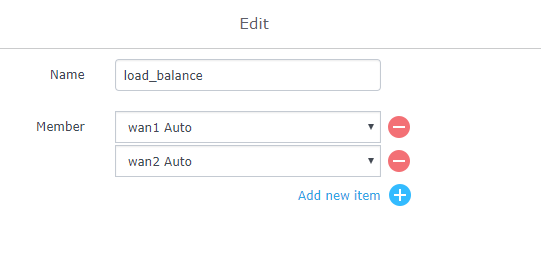
Give a name to the policy, then click on to add a new member to the list of members included on the policy.
If two members have the same metric, then the policy will do load balancing through the interfaces while taking into account the configured weight on each member to determine how much traffic can be sent through each interface. Otherwise the member with lower metric will have priority.
Click on Save and Apply changes to save the policy and it will be displayed along the other policies on the routers.

Using Routing Policies
In order to illustrate how policy-based routing can be used, let’s imagine an SMB who has a GWN7000 router running their network with two WAN (WAN1 and WAN2) ports for normal data traffic and a third WAN port (NET port used as wan) for VoIP service since this link has QoS support. The administrator wants to send normal data traffic through WAN 1 and WAN 2 in a load balanced way and the VoIP traffic via WAN 3 traffic.
We consider that the administrator has already configured the three wan ports and their IP and running which can be under the “Router 🡪 Status” page.
As explained above, the GWN7000 router will automatically generate members for the three wan ports under “Routing 🡪 Policy Routing 🡪 Members”

Users can set different weights for WAN1 and WAN2 in order to set how the router will distribute the data traffic over the two WAN ports.
Next the we will see that the router will have already created automatically the load balancing policy and WAN3 only auto policy under Policy tab as shown on the following figure.

The next step would be to assign the routing policy in order to send normal data traffic in a load-balanced way over wan1 and wan2 and send the traffic for VoIP over wan3.
For the network group LAN data traffic, users need to navigate to Router 🡪 LAN and edit the created network group then assign load balance routing policy and select wan1 and wan2 port as destinations.
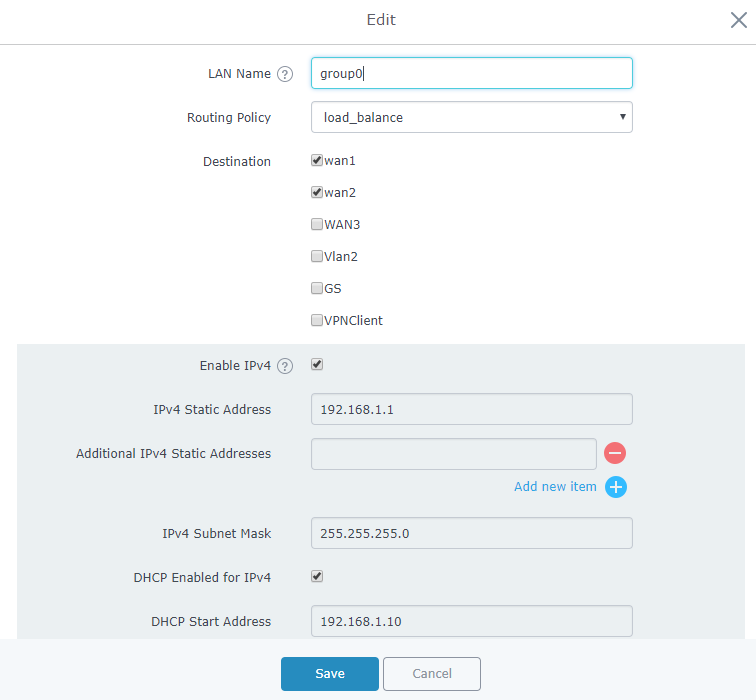
This will generate the firewall forward rule automatically to allow traffic to pass from LAN to WAN while respecting the load balance policy.

For the VoIP traffic and in order to route it via the WAN3, users need to go under “Firewall 🡪 Traffic Rules 🡪 Forward” and add a new rule as follow.
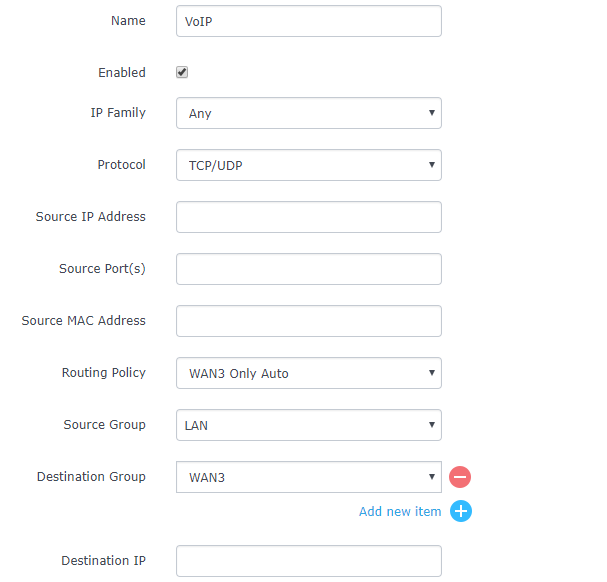

This way the VoIP traffic which uses the TCP or UDP ports 5060 through 5068 will be routed over WAN3.
SETTING UP A WIRELESS NETWORK
The GWN7000 Enterprise Router provides the user with the capability to create a wireless network by adding multiple GWN76xx series access points, with connectivity over the most common wireless standards (802.11b/g/n) operating in both 2.4GHz and 5GHz range.
The GWN7000 integrates multiple layers of security including the IEEE 802.1x port-based authentication protocol, Wired Equivalent Privacy (WEP), Wi-Fi Protected Access (WPA and WPA2) and firewall and VPN tunnels.
This chapter will introduce how to discover, add the GWN76xx access points, create and manage Wi-Fi Networks.
For more details about Grandstream GWN76xx Access points, refer to
https://www.grandstream.com/products/networking-solutions/wifi-access-points
Discover and Pair GWN76xx Access Points
The GWN76xx are powerful access points, which are fully compatible with the GWN7000 and can be added with one click, provisioned and managed in an easy and intuitive way. Once a GWN76xx is successfully connected and has an IP from the GWN7000 router, user can then pair it to the GWN7000 and associate it with an SSID.
To Pair a GWN76xx access point connected as LAN client to the GWN7000, follow the below steps:
- Connect to the GWN7000 Web GUI and go to Access Points.

- Click on
to discover access points within GWN7000’s LAN Network, the following page will appear.

- Click on Pair
under Actions, to pair the discovered Access Point with the GWN7000.
- The paired GWN76xx will appear Online, Click on
to unpair it.

- Click on
next to paired access point to check device configuration for its status, users connected to it and configuration, or select multiple GWN76xx APs from the same model, and click on
to apply same configuration on selected units.
- Click on
to configure client bridge on the selected access point. For more details about the client bridge feature, please refer to Client Bridge.
Refer to below table for Device Configuration tabs.
Table 21: Device Configuration
Access Point Location
GWN7000 router has an interesting feature to help users to locate different access points using blinking LED, to do so go under the access points page then click on button as shown on the below figure and the corresponding LED will start blinking its LEDs. This can help ease locating the Access points on a multi-deployment site.

Client Bridge
The Client Bridge feature allows an access point to be configured as a client for bridging wired only clients wirelessly to the network. When an access point is configured in this way, it will share the WiFi connection to the LAN ports transparently. This is not to be confused with a mesh setup. The client will not accept wireless clients in this mode.
Once LAN network has a Client Bridge Support enabled, the AP adopted in this LAN network can be turned in to Bridge Client mode by click the Bridge button .
Please be noted that once an AP it turned into Client Bridge mode, it cannot be controlled by a Master anymore, and a factory reset is required to turn it back into normal AP mode.

Transfer AP
Users can easily transfer the AP from local master to the Cloud based Controller account by clicking on . When you already have Network/WIFI configurations on your cloud account, using this feature will let you choose existing Network/SSID to adopt your local AP. Note: Local configurations will not be transferred. For more details, please refer to https://documentation.grandstream.com/knowledge-base/gwn-management-platforms-user-guide/.
SSIDs
When using GWN7000 as Master Access Point, users have the ability to create different SSIDs and adding GWN76XX Slave Access Points to each SSID depending on the needs of the customer.
Log in as Master to the GWN7000 WebGUI and go to SSIDs.

The GWN7000 can support the management of up to 16 SSIDs, click on to add a new SSID.
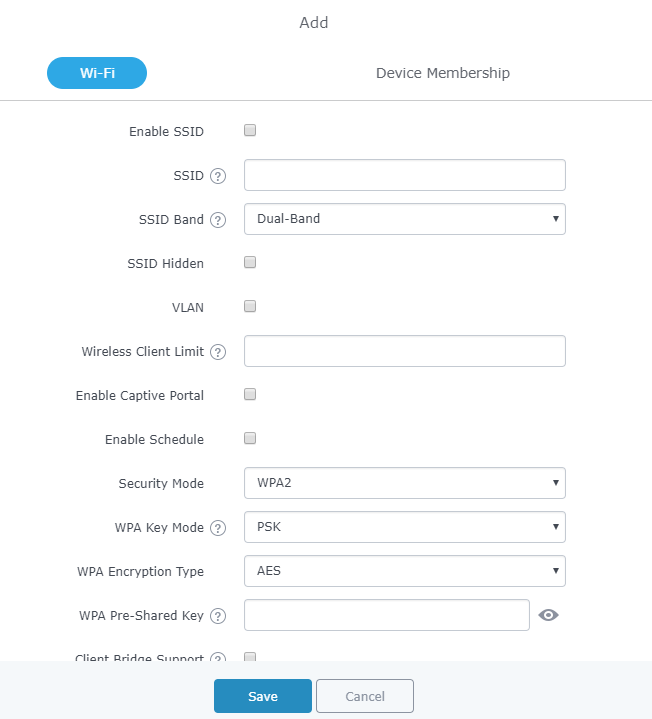
When editing or adding a new SSID, users will have two tabs to configure:
- Wi-Fi: Please refer to the below table for Wi-Fi tab options
|
Description | |
|
Enable SSID |
Check to enable Wi-Fi for the SSID. |
|
SSID |
Set or modify the SSID name. |
|
Select the Wi-Fi band the GWN will use, three options are available:
| |
|
SSID Hidden |
Select to hide SSID. SSID will not be visible when scanning for Wi-Fi, to connect a device to hidden SSID, users need to specify SSID name and authentication password manually. |
|
VLAN |
Enter the VLAN ID corresponding to the SSID. |
|
Configure the limit for wireless client. If there’s an SSID per-radio on a SSID, each SSID will have the same limit. So, setting a limit of 50 will limit each SSID to 50 users independently. If set to 0 the limit is disabled. | |
|
Enable Captive Portal |
Click on the checkbox to enable the captive portal feature. |
|
Captive Portal Policy |
Select the captive portal policy already created on the “CAPTIVE PORTAL” web page to be used in the created SSID. |
|
Enable Schedule |
Check the box and choose a schedule to apply for the selected SSID. |
|
Security Mode |
Set the security mode for encryption, 5 options are available:
|
|
WEP Key |
Enter the password key for WEP protection mode. |
|
WPA Key Mode |
Two modes are available:
|
|
WPA Encryption Type |
Two modes are available:
|
|
WPA Pre – Shared Key |
Set the access key for the clients, and the input range should be: 8-63 ASCII characters or 8-64 hex characters. |
|
Configures the client bridge support to allow the access point to be configured as a client for bridging wired only clients wirelessly to the network. When an access point is configured in this way, it will share the WiFi connection to the LAN ports transparently. Once a SSID has a Client Bridge Support enabled, the AP adopted in this SSID can be turned in to Bridge Client mode by click the Bridge button. | |
|
RADIUS Sever Address |
Configures RADIUS authentication server address. |
|
RADIUS Server Port |
Configures RADIUS Server Listening port. Default is: 1812. |
|
RADIUS Server Secret |
Enter the secret password for client authentication with RADIUS server. |
|
RADIUS Accounting Server |
Configures the address for the RADIUS accounting server. |
|
RADIUS Accounting Server Port |
Configures RADIUS accounting server listening port (defaults to 1813). |
|
RADIUS Accounting Server Secret |
Enter the secret password for client authentication with RADIUS accounting server. |
|
Client Time Policy |
Select a time policy to be applied to all clients connected to this SSID. |
|
Use MAC Filtering |
Choose Blacklist/Whitelist to specify MAC addresses to be excluded/included from connecting to the zone’s Wi-Fi. Default is Disabled. |
|
When enabled, clients will be assigned IP address from corresponding VLAN configured on the RADIUS user profile. This field is available only when “WPA Key Mode” is set to “802.1x”. | |
|
Client Isolation |
Client isolation feature blocks any TCP/IP connection between connected clients to GWN76XX’s Wi-Fi access point. Client isolation can be helpful to increase security for Guest networks/Public Wi-Fi. Three modes are available:
|
|
Client isolation feature blocks any TCP/IP connection between connected clients to GWN76XX’s Wi-Fi access point. Client isolation can be helpful to increase security for Guest networks/Public Wi-Fi. Three modes are available:
| |
|
Gateway MAC Address |
This field is required when using Client Isolation set to Gateway MAC, so users will not lose access to the Network (usually Internet). Type in the default LAN Gateway’s MAC address (router’s MAC address for instance) in hexadecimal separated by “:”. Example: 00:0B:82:8B:4D:D8 |
|
Enable Minimum RSSI |
Check to enable RSSI function, this will lead the AP to disconnect users below the configured threshold in Minimum RSSI (dBm). |
|
Minimum RSSI (dBm) |
Enter the minimum RSSI value in dBm. If the signal value is lower than the configured minimum value, the client will be disconnected. The input range is from “-94” or “-1”. |
|
Configures interval between beacon transmissions/broadcasts. The Beacon signals help to keep the network synchronized and provide main information about the network such as SSID, Timestamp…
This will help to get better throughput, thus better speed/performance. It also helps to save WiFi clients energy consumption.
Notes:
Default value is 100ms. Valid range: 40 – 500 ms. | |
|
Configures the frequency of DTIM (Delivery Traffic Indication Message) transmission per each beacon broadcast. Clients will check the AP for buffered data at every configured DTIM Period. You may set a high value for power saving consideration. Default value is 1, meaning that AP will have DTIM broadcast every beacon. If set to 10, AP will have DTIM broadcast every 10 beacons. Valid range: 1 – 10. | |
|
Once selected, AP will convert multicast streams into unicast streams over the wireless link. Which helps to enhance the quality and reliability of video/audio stream and preserve the bandwidth available to the non-video/audio clients. | |
|
Check to enable/disable Voice Enterprise. The roaming time will be reduced once enable voice enterprise.
When the signal strength of the current AP weakens, your device will scan for target APs from this list.
Note: 11R is required for enterprise audio feature, 11V and 11K are optional. This field is available only when “Security Mode” is set to “WPA/WPA2” or “WPA2”. | |
|
Enable 11R |
Check to enable 802.11r |
|
Enable 11K |
Check to enable 802.11k |
|
Enable 11V |
Check to enable 802.11v |
|
This option will enable GWN AP to answer the ARP requests from its LAN for its connected WiFi clients. This is mainly to reduce the airtime consumed by ARP Packets |
- Device Membership: Used to add or remove paired access points to the SSID.
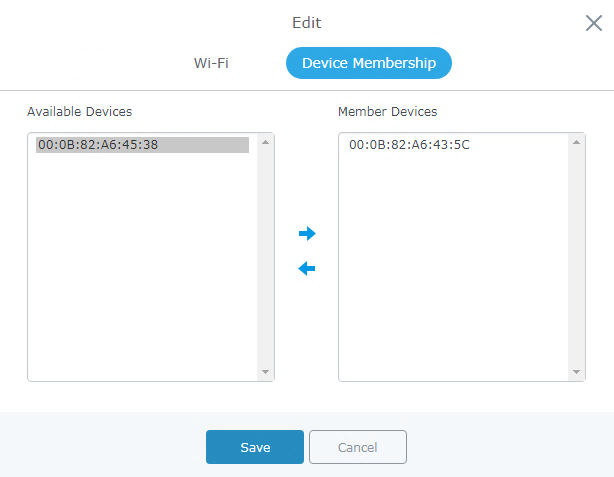
Click on to add the GWN7600/GWN7600LR to the SSID or click on
to remove it.
Mesh Network
In Mesh Network, wireless connection is established between multiple Aps, which is used to passthrough data traffic rather than client association. Each AP will evaluate the performance of wireless channel based on several factors and choose one or multiple appropriate APs to setup connection.
In a mesh network, access points are categorized to two types:
- CAP (Central Access Point): this is an access point that has an uplink connection to the wired network.
- RE (Range Extender): This is an access point that participate on the mesh network topology and has a wireless uplink connection to the central network.
In order to deploy mesh access points (RE), users/installers can follow below steps:
- Make sure to have the master and CAP access points already deployed (sometimes the CAP access points can be the master controller of the network).
- Next, we need to pair the RE access points to the master. This can be done in two ways:
- Connect all REs to the same wired LAN as the master then perform the normal process of discovery/pairing process, and after successfully pairing the APs they can be deployed on the field.
- REs can also be discovered wirelessly when powered via PSU or PoE Injector, and admin can configure them after discovery. This requires that the REs must be within the range of the Master or CAP Slave’s signals coverage.
- After that all slave access points have been deployed and paired to the master, you can directly manage them to operate the mesh network. Mesh service configuration is the same as transitional GWN WLAN.
- Log into the master page, and under Access Points page you can see the information, for example the AP in the “Online Wireless” state is the RE (Range Extender) with a wireless uplink to the CAP. The APs showing “Online” state are either a wired master or CAP.

For Global mesh network settings, navigate to the menu “System Settings 🡪 Mesh” for setting up the following parameters described below:
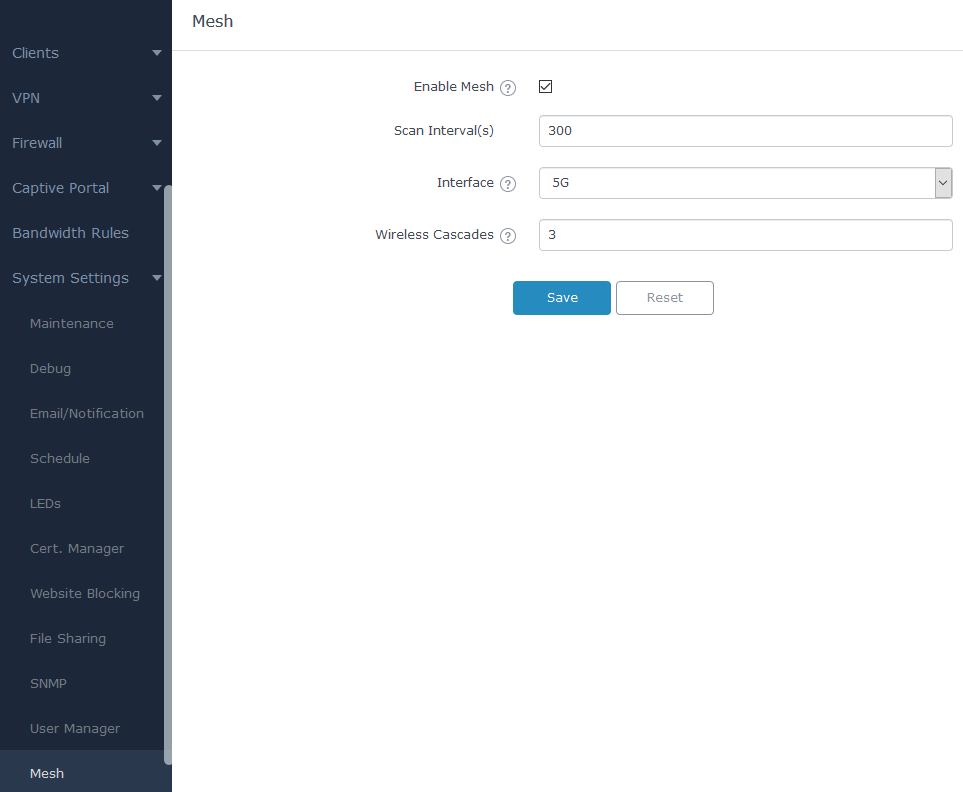
The following table describes the Mesh configuration settings.
|
Filed |
Description |
|
Enable Mesh |
When checked the Mesh feature will be activated. |
|
Scan Interval |
Interval in seconds to scan for available Mesh neighbors. Must be less than or equal to 300 seconds. |
|
Interface |
Select either 2.4GHz or 5GHz band. |
|
Wireless cascades |
Define how many AP can be cascaded wirelessly with the AP. The minimum value is 1 and maximum value is 3. |
For more detailed information about GWN Mesh network feature, you may refer to the following technical document: Mesh Network Guide.
Upgrading Access Points
Single Access Point upgrade
If you want to upgrade a single access point, users need to select the AP then simply click on the button to launch the upgrade process, the AP will use the same parameters configured for the router under the menu System Settings 🡪 Maintenance 🡪 Upgrade.
Otherwise, is users want to upgrade many devices at the same time, make sure to select all desired access points, then press the button, the router will give the option to choose between upgrading all access points at once which will result in all the devices downloading the firmware at the same time and consuming bandwidth or making sequential upgrade which is the recommended option described below.
Sequential Upgrade
If you choose multiple slave devices to upgrade their firmware, two options are available: “All-at-Once” and “Sequential”. “All-at-Once” will use the default method, all checked slaves will upgrade their firmware at the same time, while using “Sequential” upgrade method, the slaves will upgrade their firmware one by one in order to:
- Avoid entire Wi-Fi service interruption by full system firmware upgrade.
- Reduce network bandwidth consumption caused by firmware downloading.
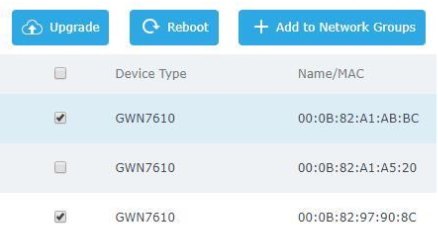
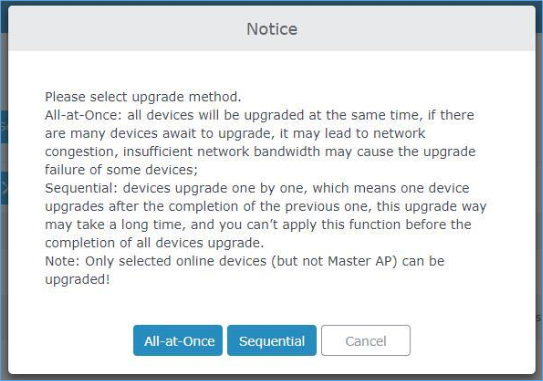
Once you choose sequential upgrade, the following icon will update you about the number of upgraded slaves out of the selected slaves.
CLIENTS CONFIGURATION
Clients
Connected clients to different LAN subnets can be shown and managed from a single interface.
Clients list can be accessed from GWN7000’s Web GUI🡪Clients to perform different actions to wired and wireless clients.
GWN7000 Enterprise Router with its DHCP server enabled on LAN ports level, will assign automatically an IP address to the devices connected to its LAN ports like a computer or GWN76xx access points and to wireless clients connected to paired GWN76xx access points.

- Click on
under Actions to check client’s status and modify basic settings such Device’s Name.
- Click on
to block a client’s MAC address from connecting to the zone’s SSID.
- Click on
to release Wi-Fi offline client IP lease.
Users can press button to customize items to display on the page. Following items are supported:

Status
Used to check user’s basic information such as MAC address, IP address, which Network group does it belong to, and to which access point if it is a wireless client, as well as Throughput and Aggregate usage.

Edit IP and Name
Configuration tab allowing to set a name for a client and set a static IP.
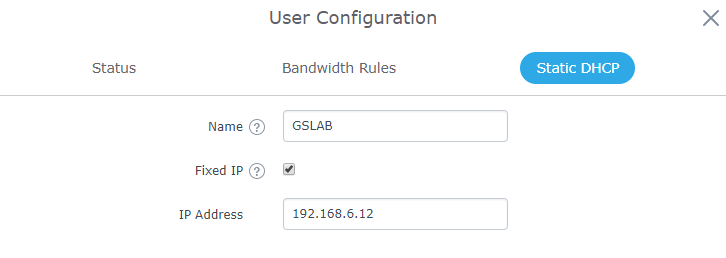
Bandwidth Rules
As mentioned on the BANDWIDTH RULES section, users can set bandwidth rules for upstream and downstream links per SSID, or per Client. For Clients users can set bandwidth rules by navigating to the menu Client🡪Edit🡪Bandwidth Rules then click add new item.
The following figure shows the settings:
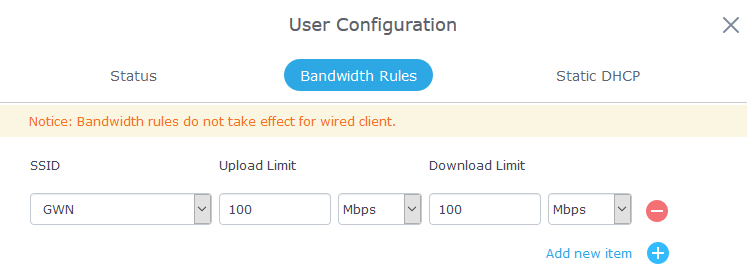
Block a Client
To block a client, click on under actions, this will add automatically the blocked client to Banned Client MAC list under Router🡪Port🡪Global Settings.

To unban a client, go to Router🡪Clients🡪Client Access. The banned client will be to “Global Blacklist”; you will need to click on “Edit” then Click on to remove it from the banned list.

Clients Access
From this menu, users can manage in global and way the blacklist of clients that will be blocked from accessing the WiFi network, click on to add or remove MAC addresses of client from global blacklist.

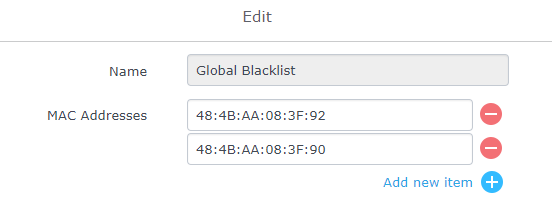
A second option is to add custom access lists that will be used as matching mechanism for MAC address filtering option under SSIDs to allow (whitelist) or disallow (blacklist) clients access to the WiFi network.
Click on in order to create new access list, then fill it with all MAC addresses to be matched and assign to it a schedule. Once this is done, this access list can be used under SSID WiFi settings to filter clients either using whitelist or blacklist mode.

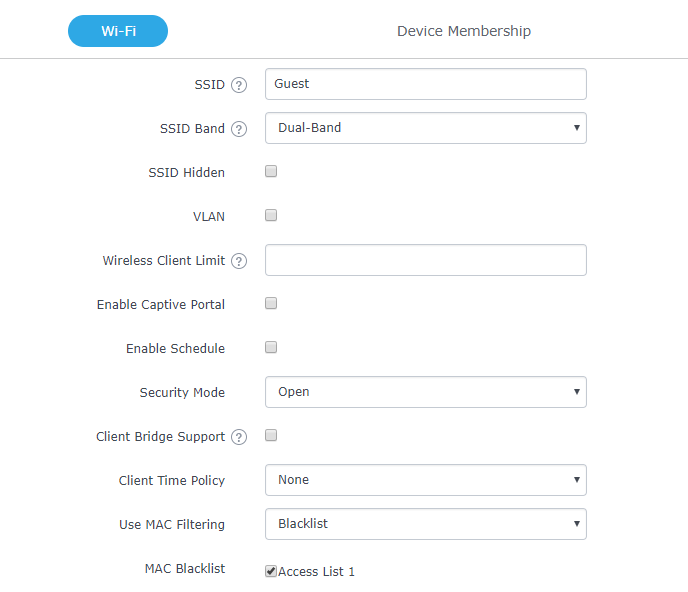
Time Policy
The timed client disconnect feature allows the system administrator to set a fixed time for which clients should be allowed to connect to the access point, after which the client will no longer be allowed to connect for a user configurable cool-down period. The configuration is based on a policy where the administrator can set the amount of time for which clients are allowed to connect to the WiFi and reconnect type and value after which they will be allowed to connect back after they have been disconnected.
In order to create a new policy, go under Clients🡪Time Policy and add new one, then the following parameters:
Table 24: Time Policy Parameters
|
Option |
Description |
|
Name |
Enter the name of the policy |
|
Enabled |
Check the box to enable the policy |
|
Limit Client Connection Time |
Sets amount of time a client may be connected. |
|
Client Reconnect Timeout Type |
Select the method with which we will reset a client’s connection timer, so they may reconnect again. Options are:
|
|
Client Reconnect Timeout |
If ‘Timed Reset’ is selected, this is the period for which the client will have to wait before reconnecting. |
|
Hour of the Day |
If Reset Daily is selected, this is the hour the reset will be applied. |
|
Day of the Week |
If Reset Weekly is selected, this is the day the reset will be applied. |
|
Hour of the Week |
If Reset Weekly is selected, this is the hour the reset will be applied. |
|
Reset Hour |
If Reset Weekly or Reset Daily is select, this is the hour and day the reset will be applied. |
Note: Time tracking shall be accounted for on a per-policy basis, such that a client connected to any SSID assigned the time tracking policy will accrue a common counter, regardless of which SSID they are connected to (as long as those SSIDs all share the same time tracking policy).
Banned Clients
Click on to view the list of the clients that have been banned after time disconnect feature has taken effect, these clients will not be allowed to connect back until timeout reset or you can unblock a client by clicking on the icon
.

VPN (VIRTUAL PRIVATE NETWORK)
Overview
VPN allows the GWN7000 to be connected to a remote VPN server using PPTP, IPSec, L2TP/IPSec and OpenVPN® protocols, or configure an OpenVPN® server and generate certificates and keys for clients, VPN page can be accessed from the GWN7000 Web GUI🡪VPN.
OpenVPN® Server Configuration
To use the GWN7000 as an OpenVPN® server, you will need to start creating user account, OpenVPN® server certificates and client certificates. Before generating server/client certificates, it is requested to generate first the Certificate Authority (CA), which will help to issue server/clients certificates.
GWN7000 certificates can be managed from WebGUI🡪System Settings🡪Cert. Manager.
Generate Self-Issued Certificate Authority (CA)
A certificate authority (CA) is a trusted entity that issues electronic documents that verify a digital entity’s identity on the Internet. The electronic documents (a.k.a. digital certificates) are an essential part of secure communication and play an important part in the public key infrastructure (PKI).
To create a Certification Authority (CA), follow below steps:
- Navigate to “System Settings🡪Cert. Manager🡪CAs” on the GWN7000 web GUI.
- Click on
button. A popup window will appear.
- Enter the CA values including CN, Key Length, and Digest algorithm… depending on your needs.
Refer to below figure showing an example of configuration and below table showing all available options with their respective description.
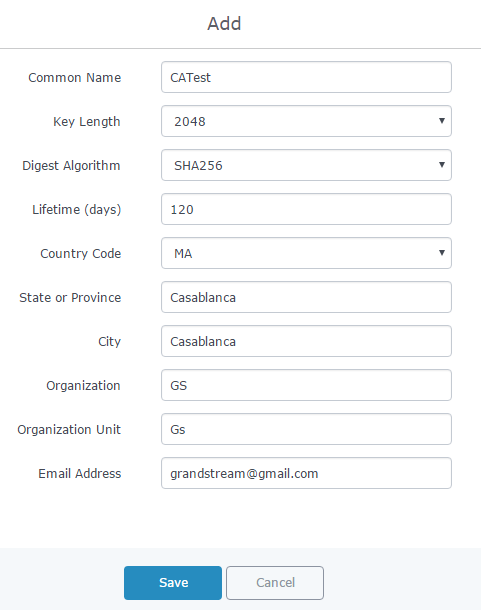
|
Field |
Description |
|
Common Name |
Enter the common name for the CA. It could be any name to identify this certificate. Example: “CATest”. |
|
Key Length |
Choose the key length for generating the CA certificate. Following values are available:
|
|
Digest Algorithm |
Choose the digest algorithm:
|
|
Lifetime (days) |
Enter the validity date for the CA certificate in days. In our example, set to “120”. |
|
Country Code |
Select a country code from the dropdown list. Example: “MA”. |
|
State or Province |
Enter a state name or province. Example: “Casablanca”. |
|
City |
Enter a city name. Example: “Casablanca”. |
|
Organization |
Enter the organization name. Example: “GS”. |
|
Organization Unit |
Enter the organization unit name. Example: “Gs”. |
|
Email Address |
Enter an email address. Example: “grandstream@gmail.com” |
- Click on
button after completing all the fields for the CA certificate.
- Click on
button to export the CA to local computer. The CA file has extension “.crt”.

Generate Server/Client Certificates
Create both server and client certificates for encrypted communication between clients and GWN7000 acting as an OpenVPN® server.
Creating Server Certificate
To create server certificate, follow below steps:
- Navigate to “System Settings🡪Cert. Manager🡪Certificates”.
- Click on
button. A popup window will appear.
Refer to below figure showing an example of configuration and below table showing all available options with their respective description.

|
Field |
Description |
|
Common Name |
Enter the common name for the server certificate. It could be any name to identify this certificate. Example: “ServerCertificate”. |
|
CA Certificate |
Select CA certificate previously generated from the drop-down list. Example: “CATest”. |
|
Certificate Type |
Choose the certificate type from the drop-down list. It can be either a client or a server certificate. Choose “Server” to generate server certificate. |
|
Key Length |
Choose the key length for generating the server certificate. Following values are available:
|
|
Digest Algorithm |
Choose the digest algorithm:
|
|
Lifetime (days) |
Enter the validity date for the server certificate in days. In our example, set to “120”. |
|
Country Code |
Select a country code from the dropdown list. Example: “MA”. |
|
State or Province |
Enter a state name or province. Example: “Casablanca”. |
|
City |
Enter a city name. Example: “Casablanca”. |
|
Organization |
Enter the organization name. Example: “GS”. |
|
Email Address |
Enter an email address. Example: “Cert@grandstream.com”. |
- Click on
button after completing all the fields for the server certificate.
Click on button to export the server certificate file in “.crt” format.
Click on button to export the server key file in “. key” format.
Click on button to revoke the server certificate if no longer needed.
Creating Client Certificate
To create client certificate, follow below steps:
- Create Users
- Navigate to “System Settings🡪User Manager”.
- Click on
button. The following window will pop up.
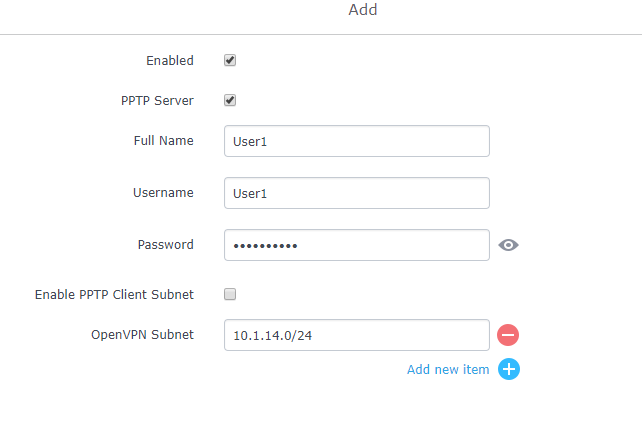
- Enter User information based on below descriptions.
|
Field |
Description |
|
Enabled |
Check to enable the user. |
|
PPTP Server |
Enable this option when using the account for PPTP client connection. |
|
Full Name |
Choose full name to identify the users. |
|
Username |
Choose username to distinguish client’s certificate. |
|
Password |
Enter user password for each username. |
|
Enable PPTP Client Subnet |
Enable this option to configure the remote subnet reachable through the PPTP client. |
|
Client Subnet |
Enter the Subnet that exists behind the connected PPTP client. |
|
OpenVPN Subnet |
Used to indicate which networks are located behind the remote device when the user account is used by an OpenVPN client router to establish a site-to-site VPN. |
- Repeat above steps for each user.
2. Create Client Certificate
- Navigate under “System Settings🡪Cert. Manager🡪Certificates”.
- Click on
button. The following window will pop up.
- Enter client certificate information based on below descriptions.
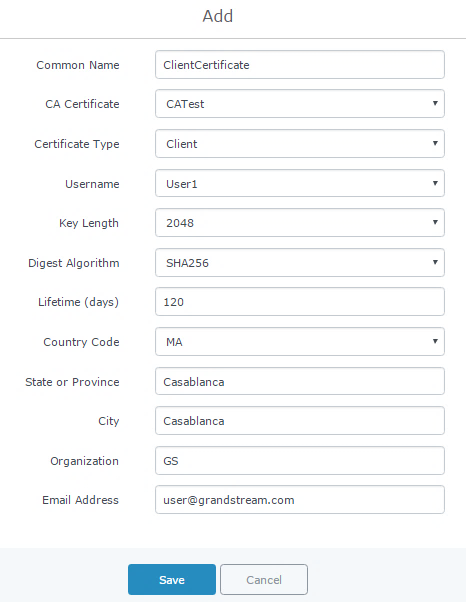
|
Field |
Description |
|
Common Name |
Enter the common name for the client certificate. It could be any name to identify this certificate. Example: “ClientCertificate”. |
|
CA Certificate |
Select the generated CA certificate from the drop-down list. |
|
Certificate Type |
Choose the certificate type from the drop-down list. It can be either a client or server certificate. |
|
Username |
Select created user to generate his certificate. |
|
Key Length |
Choose the key length for generating the client certificate. Following values are available:
|
|
Digest Algorithm |
Choose the digest algorithm:
|
|
Lifetime (days) |
Enter the validity date for the client certificate in days. Example: “120”. |
|
Country Code |
Select a country code from the dropdown list. Example: “MA”. |
|
State or Province |
Enter a state name or province. Example: “Casablanca”. |
|
City |
Enter a city name. Example: “Casablanca”. |
|
Organization |
Enter the organization name. Example: “GS”. |
|
Email Address |
Enter an email address. Example: “user@grandstream.com”. |
- Click on
after completing all the fields for the client certificate.
- Click on
to export the client certificate file in “.crt” format.
- Click on
to export the client key file in “.key” format.
Click on to revoke the client certificate if no longer needed.
The client certificates (“.crt” and “.key”) will be used by clients connected to the GWN7000 in order to establish TLS handshake.
Create OpenVPN® Server
Once client and server certificates are successfully created, you can create a new server, so that clients can be connected to it, by navigating under “VPN🡪OpenVPN®🡪Server”.
To create a new VPN server, follow below steps:
- Click on
and the following window will pop up.

|
Field |
Description |
|
Enable |
Click on the checkbox to enable the OpenVPN® server feature. |
|
VPN Name |
Enter a name for the OpenVPN® server. |
|
Server Mode |
Choose the server mode the OpenVPN® server will operate with. 4 modes are available:
Less secure as it relies on a shared TLS key plus only something the user knows (Username/password).
Most secure as there are multiple factors of authentication (TLS Key and Certificate that the user has, and the username/password they know). |
|
Protocol |
Choose the Transport protocol from the dropdown list, either TCP or UDP. The default protocol is UDP. |
|
Bind to Local Interface |
Select the interface used to connect the GWN7000 to the uplink, either WAN1, WAN2, LAN or All. |
|
Local Port |
Configure the listening port for OpenVPN® server. The default value is 1194. |
|
Traffic Routing Policy |
Select which routing policy to assign to the traffic from this VPN network. See Policy Routing section in the GWN7000 usermanual. |
|
Destination |
Choose to which destination group or WAN to allow traffic from the VPN, this will generate automatically a forwarding rule under the menu Firewall 🡪 Traffic Rules 🡪 Forward. |
|
Encryption Algorithm |
Choose the encryption algorithm from the dropdown list to encrypt data so that the receiver can decrypt it using same algorithm. |
|
Digest Algorithm |
Choose digest algorithm from the dropdown list, which will uniquely identify the data to provide data integrity and ensure that the receiver has an unmodified data from the one sent by the original host. |
|
TLS Authentication |
This option uses a static Pre-Shared Key (PSK) that must be generated in advance and shared among all peers. This feature adds extra protection to the TLS channel by requiring that incoming packets have a valid signature generated using the PSK key. |
|
TLS Pre-Shared Key |
Enter the generated TLS Pre-Shared Key when using TLS Authentication. |
|
Certificate Authority |
Select a generated CA from the dropdown list. |
|
Server Certificate |
Select a generated Server Certificate from the dropdown list. |
|
IPv4 Tunnel Network |
Enter the network range that the GWN7000 will be serving from to the OpenVPN® client. Note: The network format should be the following 10.0.10.0/16. The mask should be at least 16 bits. |
|
Redirect Gateway |
When redirect-gateway is used, OpenVPN® clients will route DNS queries through the VPN, and the VPN server will need to handle them. |
|
Automatic Firewall Rule |
Enable automatic firewall rule. |
|
Push Route |
Specify route(s) to be pushed to all clients. Example: 10.0.0.1/8 |
|
LZO Compression |
Select whether to activate LZO compression or no, if set to “Adaptive”, the server will make the decision whether this option will be enabled or no. |
|
Allow Peer to Change IP |
Allow remote change the IP and/or Port, often applicable to the situation when the remote IP address changes frequently. |
- Click
after completing all the fields.
- Click
on top of the WebGUI in order to apply changes.

OpenVPN® Client Configuration
There are two ways to use the GWN7000 as an OpenVPN® client:
- Upload client certificate created from an OpenVPN® server to GWN7000.
- Create client/server certificates on GWN7000 and upload server certificate to the OpenVPN® server.
Go to “VPN🡪OpenVPN®🡪Client” and follow steps below:
- Click on
and the following window will pop up.

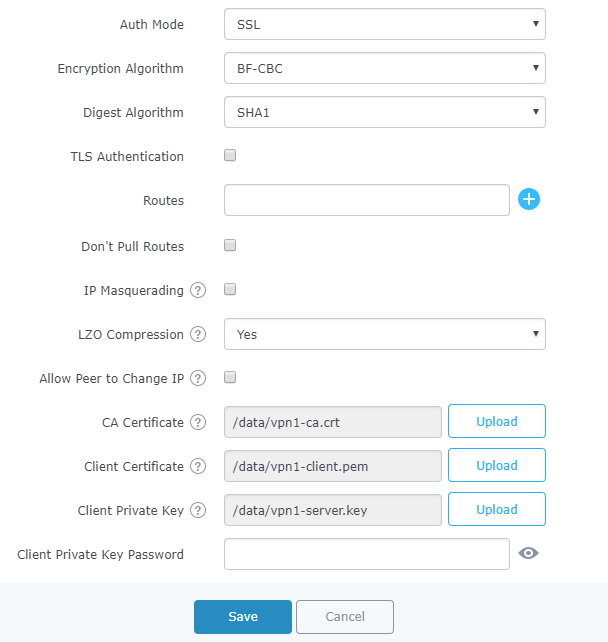
|
Field |
Description |
|
Enable |
Click on the checkbox to enable the OpenVPN® client feature. |
|
VPN Name |
Enter a name for the OpenVPN® client. |
|
Protocol |
Choose the Transport protocol from the dropdown list, either TCP or UDP. The default protocol is UDP. |
|
Bind to Local |
Select the interface used to connect the GWN7000 to the uplink, either WAN1, WAN2, LAN or All. |
|
Interface |
Select the interface used to connect the GWN7000 to the uplink, either WAN1, WAN2. |
|
Local Port |
Configure the listening port for OpenVPN® server. Default is 1194. |
|
Destination |
Choose to which destination group or WAN to allow traffic from the VPN, this will generate automatically a forwarding rule under the menu Firewall 🡪 Traffic Rules 🡪 Forward. |
|
Remote OpenVPN® Server |
Configure the remote OpenVPN® server IP address. |
|
Remote OpenVPN® Server Port |
Configure the remote OpenVPN® server port. |
|
Local TUN IP address |
Configures statically the local VPN tunnel IP address for the client. |
|
Remote TUN IP address |
Configures statically the local VPN tunnel IP address for the remote server. |
|
Auth Mode |
Choose the server mode the OpenVPN® server will operate with, 4 modes are available:
Less secure as it relies on a shared TLS key plus only something the user knows (Username/password).
Most secure, as there are multiple factors of authentication (TLS Key and Certificate that the user has, and the username/password they know). |
|
Encryption Algorithm |
Choose the encryption algorithm from the drop-down list, in order to encrypt data so that the receiver can decrypt it using the same algorithm. |
|
Digest Algorithm |
Choose the digest algorithm from the drop-down list, which will uniquely identify the data to provide data integrity and ensure that the receiver has an unmodified data from the one sent by the original host. |
|
TLS Authentication |
This option uses a static Pre-Shared Key (PSK) that must be generated in advance and shared among all peers. This feature adds extra protection to the TLS channel by requiring that incoming packets have a valid signature generated using the PSK key. |
|
TLS Pre-Shared Key |
Enter the generated TLS Pre-Shared Key when using TLS Authentication. |
|
Routes |
This feature allows specifying and adding custom routes. |
|
Don’t Pull Routes |
If enabled, client will ignore routes pushed by the server. |
|
IP Masquerading |
This feature is a form of network address translation (NAT) which allows internal computers with no known address outside their network, to communicate to the outside. It allows one machine to act on behalf of other machines. |
|
LZO Compression |
LZO encoding provides a very high compression ratio with good performance. LZO encoding works especially well for CHAR and VARCHAR columns that store very long character strings. |
|
Allow Peer to Change IP |
Allow remote change the IP and/or Port, often applicable to the situation when the remote IP address changes frequently. |
|
CA Certificate |
Click on “Upload” and select the “CA” certificate generated previously on this guide. |
|
Client Certificate |
Click on “Upload” and select the “Client Certificate” generated previously on this guide. |
|
Client Private Key |
Click on “Upload” and select the “Client Private Key” generated previously on this guide. |
|
Client Private Key Password |
Enter the client private key password |
- Click
after completing all the fields.
- Click
on top of the web GUI to apply changes.

L2TP/IPSEC Configuration
Layer 2 Tunneling Protocol (L2TP) is a tunneling protocol used to support virtual private networks (VPNs) or as part of the delivery of services by ISPs. It does not provide any encryption or confidentiality by itself. Rather, it relies on an encryption protocol that it passes within the tunnel to provide privacy.
GWN7000 L2TP/IPSec Client Configuration
To configure L2TP client on the GWN7000, navigate under “VPN🡪L2TP/IPSec” and set the following:
- Click on
and the following window will pop up.
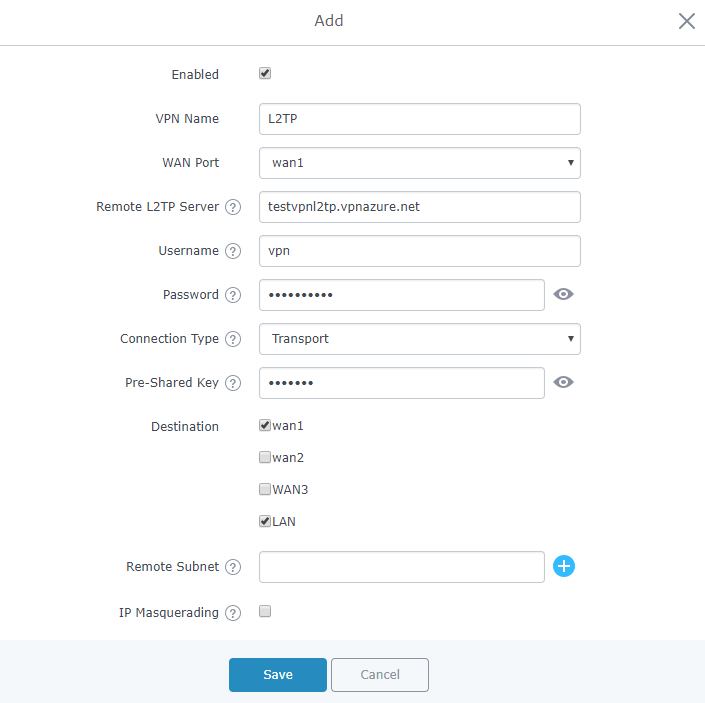
|
Field |
Description |
|
Enable |
Click on the checkbox in order to enable the L2TP client feature. |
|
VPN Name |
Enter a name for the L2TP client. |
|
WAN Port |
Select which WAN port is connected to the uplink, either WAN1 or WAN2. |
|
Remote L2TP Server |
Enter the IP/Domain of the remote L2TP Server. |
|
Username |
Enter the Username for authentication against the VPN Server. |
|
Password |
Enter the Password for authentication against the VPN Server. |
|
Connection Type |
Select either Transport mode or Tunnel mode:
|
|
Pre-Shared Key |
Enter the L2TP pre-shared key. |
|
Remote Subnet |
Configures the remote subnet for the VPN. The format should be “IP/Mask” where IP could be either IPv4 or IPv6 and mask is a number between 1 and 32. For example: 192.168.5.0/24 |
|
IP Masquerading |
This feature is a form of network address translation (NAT) which allows internal computers with no known address outside their network, to communicate to the outside. It allows one machine to act on behalf of other machines. |
|
Masq Source |
This option allows the user to configure the local subnets that needs to be masqueraded. |
|
Use DNS from Server |
Enable this option to retrieve DNS from the VPN server. |
|
Keepalive |
Specifies the keepalive failure value “n”. if ppp doesn’t receive LCP response from “n” LCP echo-request frames, then the connection to the peer will be terminated. If this option is set LCP echo-request will be sent to the peer for every 5 sec by default. |
|
Use Built-in IPv6 management |
Enable the IPv6 management for the VPN. |
|
Connection retries |
Configures the number of attempts to reconnect the L2TP client, if this number is exceeded, the client will be disconnected from the L2TP/IP Server. |
- Click
after completing all the fields.
- Click
on top of the web GUI to apply changes.

PPTP CONFIGURATION
A data-link layer protocol for wide area networks (WANs) based on the Point-to-Point Protocol (PPP) and developed by Microsoft that enables network traffic to be encapsulated and routed over an unsecured public network such as the Internet. Point-to-Point Tunneling Protocol (PPTP) allows the creation of virtual private networks (VPNs), which tunnel TCP/IP traffic through the Internet.
GWN7000 Client Configuration
To configure PPTP client on the GWN7000, navigate under “VPN🡪PPTP” and set the following:
- Click on
and the following window will pop up.
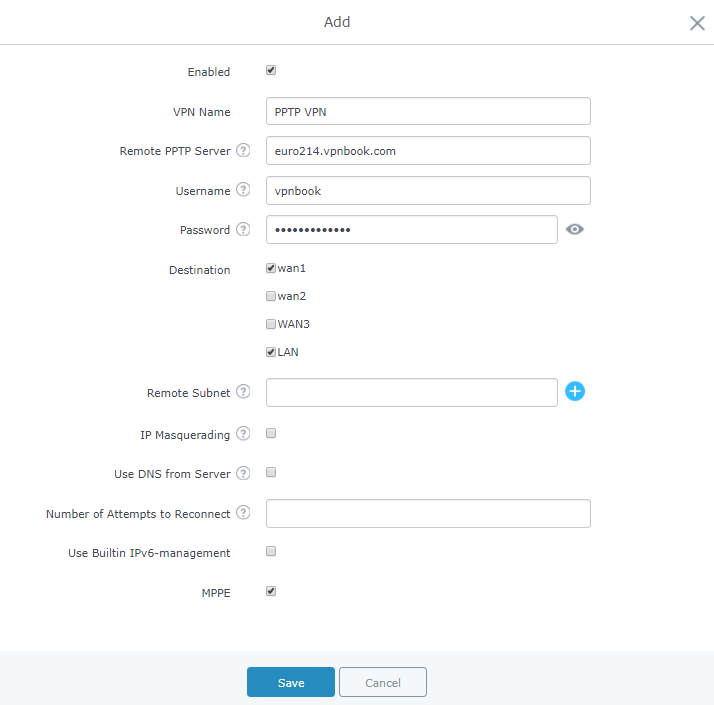
|
Field |
Description |
|
Enable |
Click on the checkbox to enable the PPTP VPN client feature. |
|
VPN Name |
Enter a name for the PPTP client. |
|
Remote PPTP Server |
Enter the IP/Domain of the remote PPTP Server. |
|
Username |
Enter the Username for authentication against the VPN Server. |
|
Password |
Enter the Password for authentication against the VPN Server. |
|
Destination |
Choose to which destination group or WAN to allow traffic from the VPN, this will generate automatically a forwarding rule under the menu Firewall 🡪 Traffic Rules 🡪 Forward. |
|
Remote Subnet |
Configures the remote subnet for the VPN. The format should be “IP/Mask” where IP could be either IPv4 or IPv6 and mask is a number between 1 and 32. For example: 192.168.5.0/24 |
|
IP Masquerading |
This feature is a form of network address translation (NAT) which allows internal computers with no known address outside their network, to communicate to the outside. It allows one machine to act on behalf of other machines. |
|
Use DNS from Server |
Enable this option to retrieve DNS from the VPN server. |
|
Number of Attempts to Reconnect |
Configures the number of attempts to reconnect the PPTP client, if this number is exceeded, the client will be disconnected from the PPTP Server. |
|
Use Built-in IPv6 management |
Enable the IPv6 management for the VPN. |
|
Enable / disable the MPPE for data encryption. By default, it’s disabled. |
- Click
after completing all the fields.
- Click
on top of the web UI to apply changes.

GWN7000 PPTP Server Configuration
To configure PPTP server on the GWN7000, go to “VPN🡪PPTP🡪Server” and set the following:
- Click on
and the following window will pop up.
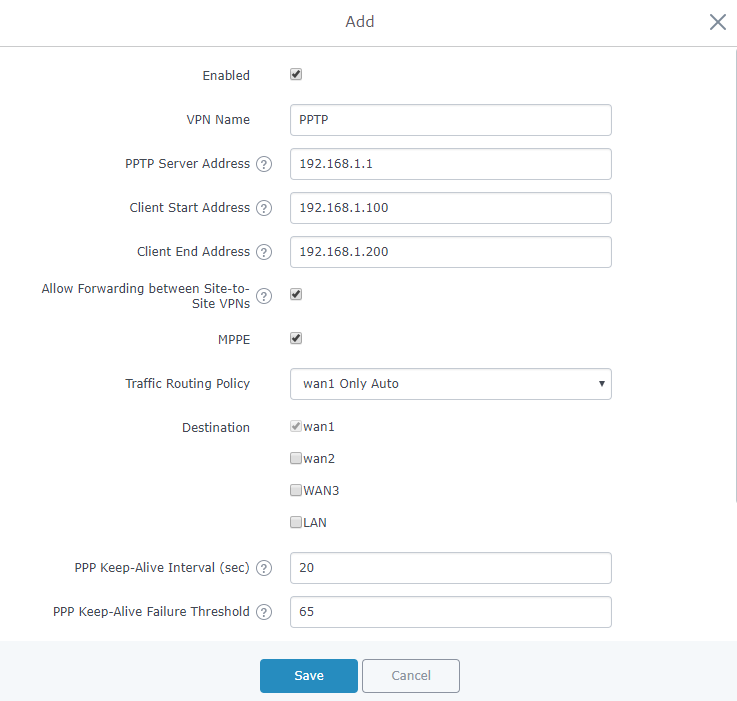
Table 32: PPTP Server Configuration Parameters
|
Field |
Description |
|
Enable |
Click on the checkbox to enable the PPTP VPN Server. |
|
VPN Name |
Enter a name for the PPTP Server. |
|
PPTP Server Address |
Configure the PPTP server local address (ex: 192.168.1.1). |
|
Client Start Address |
Configure the remote client IP start address. Note: this address should be in the same subnet as the end address and PPTP server address. |
|
Client End Address |
Configure the remote client IP end address. Note: this address should be in the same subnet as the start address and PPTP server address. |
|
Allow Forwarding between Site-To-Site VPNs |
This option allows forwarding between multiple site-to-site VPNs. i.e. if there are multiple PPTP users configured with client subnet enabled, then this option allows one PPTP client subnet to access another PPTP client subnet through the server. Note: for this option to work more than one PPTP users with client subnet must be enabled. |
|
MPPE |
Enable / disable the MPPE for data encryption. By default, it’s disabled. |
|
Traffic Routing Policy |
Select which routing policy to assign to the traffic from this VPN network. See Policy Routing section |
|
Destination |
Choose to which destination group or WAN to allow traffic from the VPN, this will generate automatically a forwarding rule under the menu Firewall 🡪 Traffic Rules 🡪 Forward. |
|
Interval in seconds for LCP echo-request frames to be sent. | |
|
PPP Keep-Alive Failure Threshold |
The PPTP server will consider a peer to be dead if N Echo-request frames aren’t replied to. The connection will be then terminated. A setting of 0 disables this function. |
|
PPP Adaptive Keep-Alive |
If the PPP keepalive failure settings is enabled, then echo-request frames will only be sent if no traffic has been received from the peers since the last echo-request was sent. |
|
Debug |
Enable debug logging to syslog. |
|
Specify the MTU, valid range (1280-1500 Bytes). | |
|
Specify the MRU, valid range (1280-1500 Bytes). |
- Click
after completing all the fields.
- Click
on top of the web GUI to apply changes.
After this step, you need to create user accounts under web GUI 🡪 System Settings 🡪 User Manager in order to connected to the configured PPTP server.
IPSec VPN Tunnel
Overview
Internet Security protocol- IPsec is mainly used to authenticate and encrypt packets of data sent over the network layer. In order to accomplish this, they use two security protocols – ESP (Encapsulation Security Payload) and AH (Authentication Header), the former provides both authentication as well as encryption whereas the latter provides only authentication for the data packets. Since both authentication and encryption are equally desirable, most of the implementations use ESP.
IPsec supports two different encryption modes, they are Tunnel (default) and the Transport mode. Tunnel mode is used to encrypt both payload as well as the header of an IP packet, which is considered to be more secure. Transport mode is used to encrypt only the payload of an IP packet, which is generally used in gateway or host implementations.
IPsec also involves IKE (Internet Key Exchange) protocol which is used to setup the Security Associations (SA). A Security Association establishes a set of shared security parameters between two network entities to provide a secure network layer communication. These security parameters may include: the cryptographic algorithm and mode, traffic encryption key and parameters for the network data to be sent over the connection. Currently there are two IKE versions available – IKEv1 and IKEv2. IKE works in two phases:
- Phase 1: ISAKMP operations will be performed after a secure channel is established between two network entities.
- Phase 2: Security Associations will be negotiated between two network entities.
IKE operates in three modes for exchanging of keying information and establishing security associations – Main, Aggressive and Quick mode.
- Main mode: is used to establish the phase 1 during the key exchange. It uses three two-way exchanges between the initiator and the receiver. In the first exchange, algorithms and hashes are exchanged. In the second exchange, shared keys are generated using Diffie-Hellman exchange. In the last exchange, verification of each other’s identities takes place.
- Aggressive mode: provides the same service as the main mode, but it uses two exchanges instead of three. It does not provide identity protection, which makes it vulnerable to hackers. Main mode is more secure than this.
- Quick mode: After establishing a secure channel using either main mode or aggressive mode, quick mode can be used to negotiate general IPsec security services and to generate newly keyed material. They are always encrypted under the secure channel and uses the hash payload that is used to authenticate the rest of the packet.
Configuring GWN7000 IPSec Tunnel
In order to build an IPSec secure tunnel between two devices located on different places on the Internet, we can use the sample scenario below:
Branch office router needs to connect to Headquarters office via an IPSec tunnel, on each side we have a GWN7000 router. Users can configure the two devices as following:
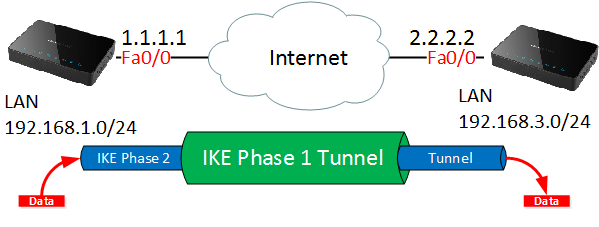
The branch office router runs a LAN subnet 192.168.1.0/24 and the HQ router runs a LAN subnet 192.168.3.0, the public IP of the branch office router is 1.1.1.1 and the IP of the HQ router is 2.2.2.2.
Configuration of Branch office router:
Go under VPN 🡪 IPSec then click on add and fill in the following information under phase 1 tab:
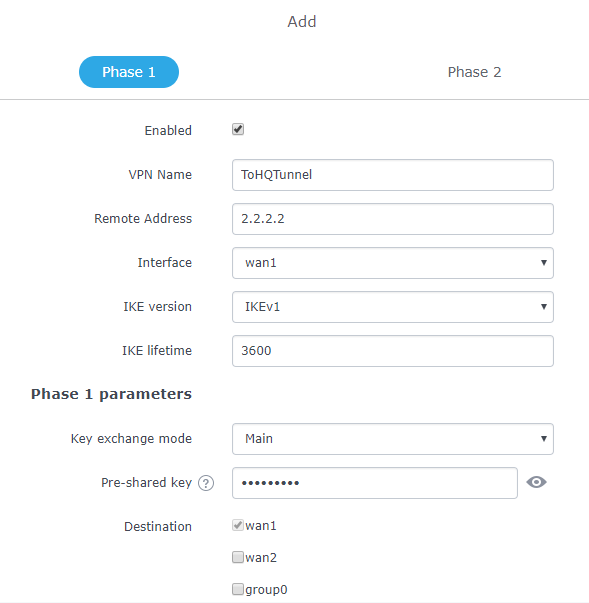
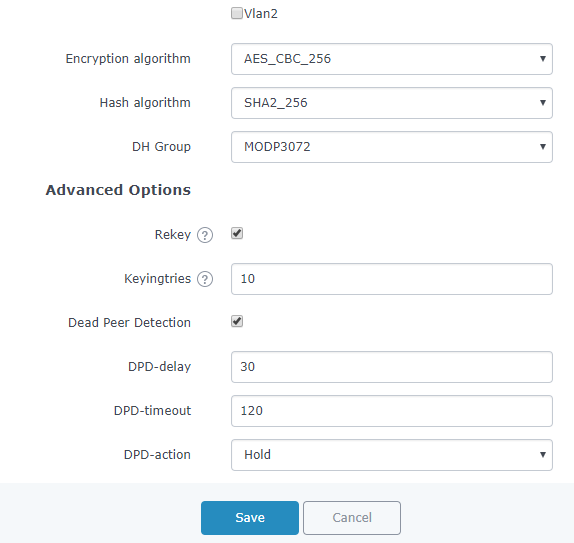
Table 33: IPSec Phase 1 Parameters
|
Field |
Description |
|
Enabled |
Enable or Disable the IPSec tunnel. |
|
VPN Name |
VPN Connection Name. |
|
Remote Address |
Enter the IP address of the remote side of the tunnel. |
|
Interface |
Select from which interface the router will try to build the VPN connection. |
|
IKE Version |
Allows the use to choose between using IKE version 1 or 2. Default value: IKEv1 |
|
IKE Lifetime |
Specifies in seconds the lifetime of the keying channel. Default: 3600 seconds. |
|
Key Exchange mode |
Select which mode to use for key exchange during the stage of channel establishment: Main mode or Aggressive mode. |
|
Pre-Shared key |
Enter the PSK password for authentication. |
|
Destination |
Choose to which destination group or WAN to allow traffic from the VPN, this will generate automatically a forwarding rule under the menu Firewall 🡪 Traffic Rules 🡪 Forward. |
|
Encryption algorithm |
Select the crypto to be used for data confidentiality:
|
|
Hash algorithm |
Select the hash to be used data integrity:
|
|
DH group |
Select the Diffie Hellman group to be used for the session:
|
|
Rekey |
This allows the user to decide whether a connection should be renegotiated when it is about to expire. if disabled it is necessary to make sure the other end also agrees on it. Otherwise it is ineffective. |
|
Keying tries |
This specifies the number of attempts to be made to negotiate a connection before giving up. By default, it is set to 10 and if set to 0 the router will keep trying forever. |
|
Dead Peer Detection |
Check the option to enable/disable DPD. |
|
DPD delay |
Configures the delay for DPD keepalive packets for the specific connection. |
|
DPD timeout |
Configures the length of time it will remain idle without receiving any response from the peer. |
|
DPD action |
This provides the user with a set of actions to perform if the peer is considered to be dead.
|
Press Save, then go to phase2 tab in order to configure the phase 2 parameters as folllow
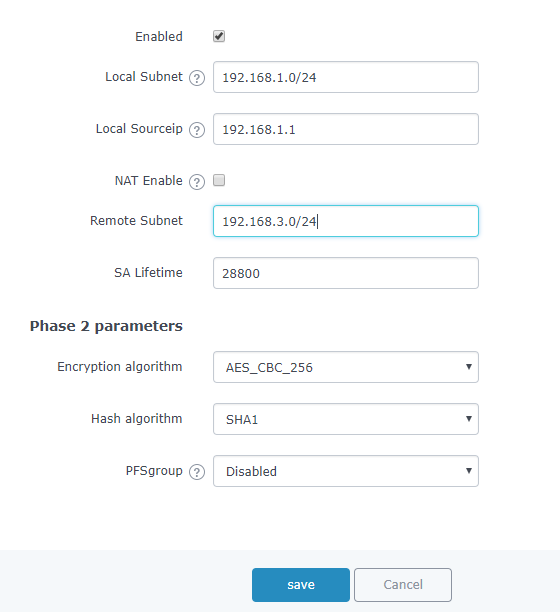
After this is done, press save and apply the settings, then configure same settings for phase 1 on the HQ router, as for phase 2 configuration parameters they should be as following:
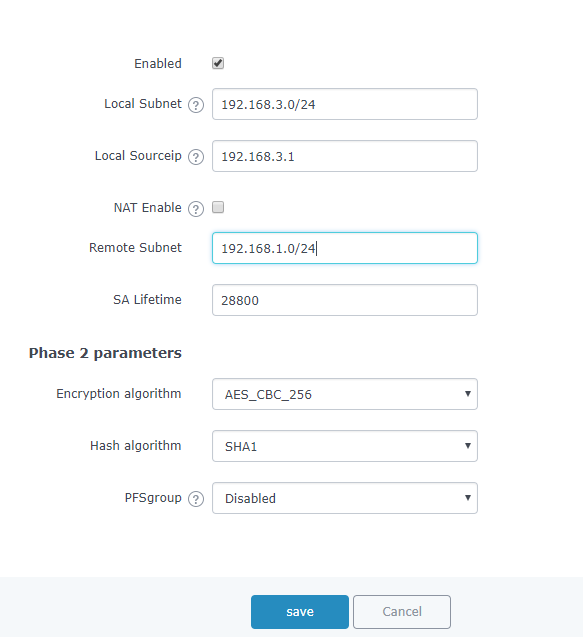
Once this is done, the two routers will build the tunnel and the necessary routing information in order to route traffic through the tunnel back and from the branch office to HQ network.
For reference, the table below gives the descriptions of the parameters used for phase 2 settings:
Table 34: IPSec Phase 2 Parameters
|
Field |
Description |
|
Local Subnet |
Configure the local subnet that will be included on the connection. |
|
Local Source IP |
Configures the source IP to be used when transmitting a packet to the other end of the connection. |
|
NAT Enable |
This option enables the user to masquerade the local LAN subnets. NAT translated subnet must be specified along with this option. |
|
Remote Subnet |
Specifies the remote subnet that can be reached through the tunnel connection. |
|
SA lifetime |
Sets the lifetime of a set of encryption/auth keys for a packet. |
|
Encryption algorithm |
Select the crypto to be used for data confidentiality:
|
|
Hash algorithm |
Select the hash to be used data integrity:
|
|
PFS group |
Select the Diffie Hellman group to be used for the session:
The default value is disabled, which indicates that the router will use the option configured on DH group under phase 1. |
FIREWALL
GWN7000 supports firewall feature to control incoming and outgoing traffic by restricting or rejecting specific traffic, as well as preventing attacks to the GWN7000 networks for enhanced security.
The Firewall feature includes 3 menus:
- Basic Settings: Used to enable SYN Flood, setup port forwarding, DMZ, inter-group traffic forwarding and UPnP.
- Traffic Rules: Used to control incoming/outgoing traffic in customized scheduled times, and taking actions for specified rules such as Accept; Reject and Drop.
- Advanced: Used to setup SNAT and DNAT.
Basic Settings
SYN Flood Protection is used to avoid DOS attacks.
SYN Flood Protection is enabled by default on GWN7000, you can edit the “SYN Flood Rate Limit”, “SYN Flood Burst Limit” and whether to drop or no the invalid packets as shown in the below screenshot
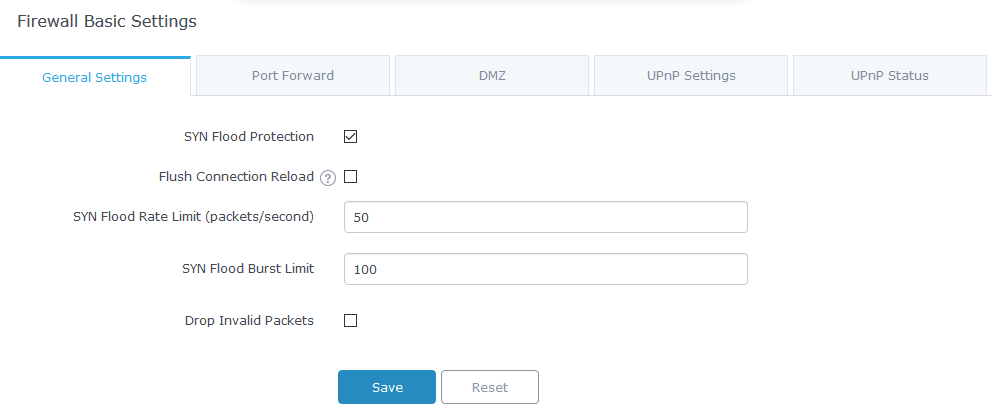
Flush Connection Reload: When this option is enabled, and a firewall configuration change is made, existing connections that had been permitted by the previous firewall rules will be terminated.
That way if the new firewall rules can’t permit a connection that had been previously established, it will be terminated and won’t be able to reconnect.
When this option is disabled, existing connections are allowed to continue until they do timeout, even if the new rules wouldn’t allow these connections to be established.
Port Forwarding
Port forwarding allows redirecting a communication request from one address and port number combination to another.
Below are different possible actions:
- To add a Port Forward rule, click on
.
- To edit a Port Forward rule, click on
.
- To delete a Port Forward rule, click on
.

Refer to following table for Port Forwarding option when editing or creating a port-forwarding rule:
|
Name |
Specify a name for the port forward rule. |
|
Enabled |
Check to enable this port forward rule. |
|
Protocol |
Select a protocol, users can select TCP, UDP or TCP/UDP. |
|
Source Group |
Select the WAN Interface. |
|
Source Port (s) |
Set a single or a range of Ports. |
|
Destination Group |
Select the LAN or VLAN group. |
|
Destination IP |
Set the destination IP address. |
|
Destination Port (s) |
Set a single or a range of Ports. |
DMZ
GWN7000 support DMZ, where it is possible to specify a LAN client to be put on the DMZ.
- To add an IP into the DMZ, click on
.
- To edit a DMZ entry, click on
.
- To delete a DMZ entry, click on
.

Refer to below table for DMZ fields:
|
Name |
Specify a name for the DMZ entry. |
|
Enabled |
Check to enable this DMZ entry. |
|
Source Group |
Select the WAN interface |
|
Destination Group |
Select the LAN group. |
|
Destination IP |
Set the destination IP address. |
UPnP
GWN7000 supports UPnP that enables programs running on a host to configure automatically port forwarding.
UPnP allows a program to make the GWN7000 to open necessary ports, without any intervention from the user, without making any check.
UPnP settings can be accessed from GWN7000 WebGUI🡪Firewall🡪Basic🡪UPnP Settings.
Refer to below Table for UPnP settings.
|
Enable Daemon |
Check to enable Daemon for UPnP. |
|
External Interface |
Select the WAN interface to allow external connection to resources that enables UPnP. |
|
Internal Interface |
Check the LAN network on which to activate UPnP. |
|
Enable UPnP |
Check to Enable UPnP for the LAN clients on selected LAN network. |
|
Enable NAT-PMP |
Check to enable automatic NAT Port Mapping (NAT-PMP). |
|
Secure Mode |
Check to activate secure mode for devices that activate UPnP. |
|
Logging to Syslog |
Choose whether to log activities for UPnP into Syslog. |
|
Download Speed |
Set the Download speed value in KB/s. Default is 2048 |
|
Upload Speed |
Set the Upload speed value in KB/s. Default is 1024. |
Users can check the UPnP status under the menu “Firewall 🡪 Basic 🡪 UPnP”.
Traffic Rules Settings
GWN7000 offers the possibility to fully control incoming/outgoing traffic for different protocols in customized scheduled times and taking actions for specified rules such as Accept; Reject and Drop.
Following actions are available to configure Input, output and forward rules for configured protocols
- To add new rule, Click on
.
- To edit a rule, Click on
.
- To delete a rule, Click on
.
Input
The GWN7000 allows to filter incoming traffic to networks group or port WAN1 or WAN2 and apply rules such as:
- Accept: To allow the traffic to go through.
- Reject: A reply will be sent to the remote side stating that the packet is rejected.
- Drop: The packet will be dropped without any notice to the remote side.
Following actions are available to configure Input rules on the GWN7000 under “Firewall > Traffic Riles > Input” for configured protocols.
To add new rule, Click on
To edit a rule, Click on
- To delete a rule, Click on
The following example rejects incoming ICMP request to WAN port 1, this means that whenever the GWN7000 receives and incoming ICMP request on WAN port 1 the destination IP address will receive a message stating that the destination IP address is unreachable.
Below screenshot shows configuration example:
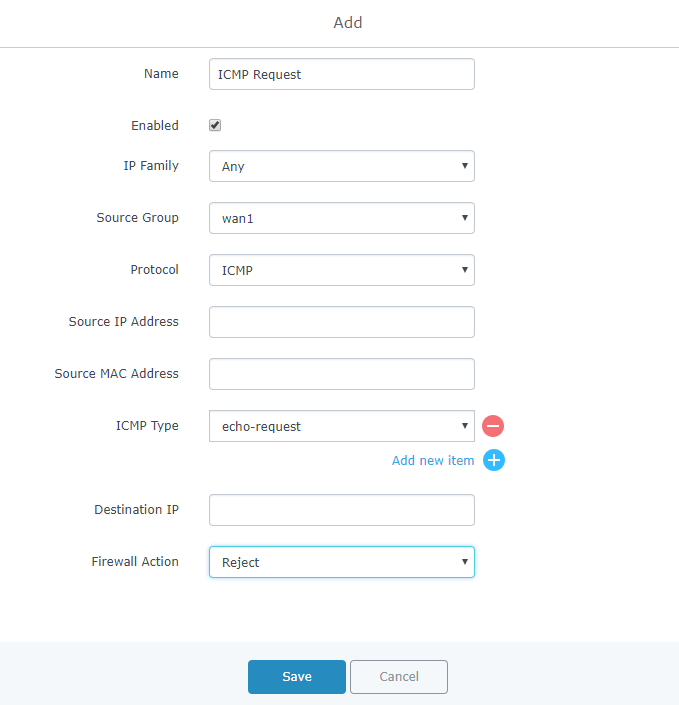
Output
The GWN7000 allows to filter outgoing traffic from the local LAN networks to outside networks and apply rules such as:
- Accept: To allow the traffic to go through.
- Reject: A reply will be sent to the remote side stating that the packet is rejected.
- Drop: The packet will be dropped without any notice to the remote side.
Following actions are available to configure Output rules on the GWN7000 under “Firewall 🡪 Traffic Rules 🡪 Output” for configured protocols.
To add new rule, Click on
To edit a rule, Click on
- To delete a rule, Click on
The following example will reject every outgoing ICMP request from GWN7000 to network Group1, this means that whenever the GWN7000 receives an ICMP “echo-request” from another network group or from WAN port 1 or 2 sent to LAN1 will be rejected.
Below screenshot shows configuration example:
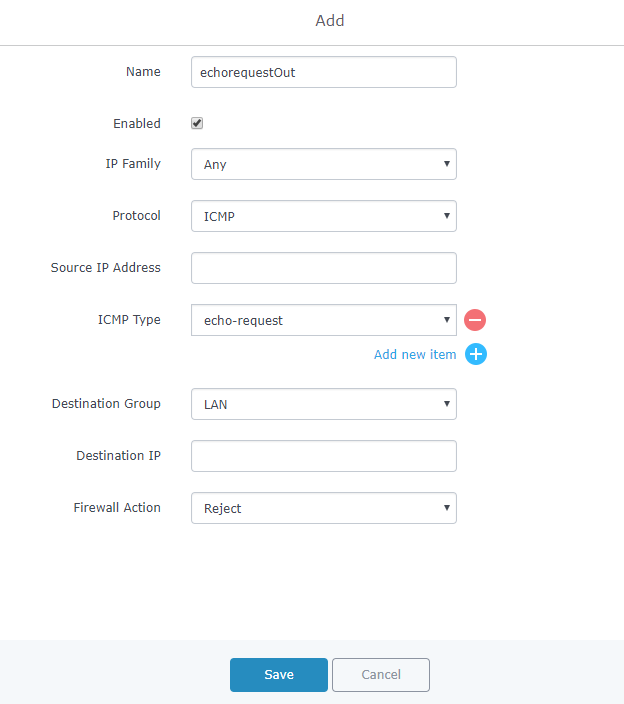
GWN7000 offers the possibility to allow traffic between different groups and interfaces.
Users can select to edit a source group and add to it other network groups and WAN interfaces to allow inter-group traffic between the selected members.
This will either use firewall rules or policy-based routing rules, if the action select is ACCEPT, DROP or REJECT then the firewall rule will apply, otherwise if users want to trigger the policy-based routing, then the action should be set to MATCH in order to match the traffic and apply the routing policy.
For further details, check the Policy Routing section.
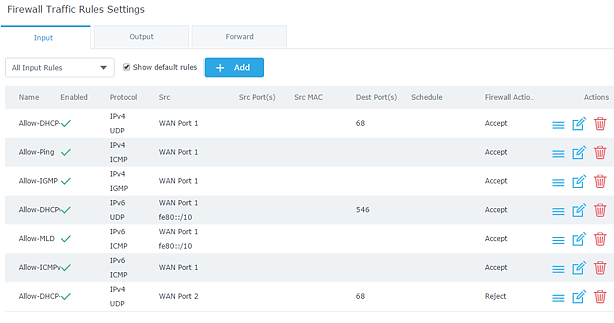
Refer to below table for each tab, when editing or creating a traffic rule:
Table 38: Firewall Traffic Rules
|
Name |
Specify a name for the traffic rule. |
|
Enabled |
Check to enable this rule. |
|
IP Family |
Select the IP version, three options are available: IPv4, IPv6 or Any. |
|
Source Group |
Select a WAN interface or a LAN group for Source Group, or select All. |
|
Protocol |
Select one of the protocols from dropdown list or All, available options are: UDP, TCP, TCP/UCP, UDP-Lite, ICMP, AH, SCTP, IGMP and All. |
|
Source IP Address |
Set the Source IP address, it can be an IPv4 or IPv6 address. |
|
Source Port(s) |
Set the source port number. Or port range. |
|
Source MAC address |
Set the Source MAC address. |
|
Set the destination IP address, it can be an IPv4 or IPv6 address. | |
|
Destination Port(s) |
Set the destination’s port(s). |
|
Firewall Action |
Select which action to perform for the given traffic rule, 3 options are available: Accept, Reject or Drop. |
Firewall Advanced Settings
Firewall Advanced Settings page provides the ability to setup input/output policies for each WAN interface and LAN groups; as well as setting configuration for Static and Dynamic NAT.
 General Settings
General Settings
Click on next to a WAN interface or Network group to edit its input and output policies.
Refer to below table for general settings options:
Table 39: Firewall-General Settings
|
Input Policy |
Select which action to apply to all incoming traffic to this interface/LAN group, 3 actions are available: Accept, Reject and Drop. |
|
Output Policy |
Select which action to apply to all outgoing traffic from this interface/LAN group, 3 actions are available: Accept, Reject and Drop. |
|
IP Masquerading |
Check to enable IP Masquerading, this will allow internal computers with no known address outside their network, to communicate to the outside. It allows one machine to act on behalf of other machines. |
|
MSS Clamping |
Check to enable MSS Clamping. This will provide a method to prevent fragmentation when the MTU value on the communication path is lower than the MSS value. |
|
Log Dropped and Reject Traffic to Syslog |
Check to send all rejected and dropped traffic logs to configured Syslog Server. |
|
Limit for Dropped and Rejected Traffic |
Specify the limit for dropped and reject traffic. The value format is N/unit, where N is a digit number, and unit can either be in second, minute, hour or day. |
SNAT
Following actions are available for SNAT.
To add new SNAT entry, click on .
To edit a SNAT entry, click on .
- To delete a SNAT rule, click on .
Refer to below table when creating or editing an SNAT entry:
|
Name |
Specify a name for the SNAT entry |
|
Enabled |
Check to enable this SNAT entry. |
|
IP Family |
Select the IP version, three options are available: IPv4, IPv6 or Any. |
|
Source Group |
Select a WAN interface or a LAN group for Source Group, or select All. |
|
Destination Group |
Select a WAN interface or a LAN group for Destination Group, or select All. Make sure that destination and source groups are different to avoid conflict. |
|
Protocol |
Select one of the protocols from dropdown list or All, available options are: UDP, TCP, TCP/UCP and All. |
|
Source IP |
Set the Source IP address. |
|
Rewrite IP |
Set the Rewrite IP. The source IP address of the data package from the source group will be updated to this configured IP. |
|
Destination IP |
Set the Destination IP address. |
|
Schedule Start Date |
Click on |
|
Schedule End Date |
Click on |
|
Schedule Start Time |
Click on |
|
Schedule End Time |
Click on |
|
Schedule Weekdays List of Weekdays |
Select the days, on which the SNAT entry will be applied, the unselected days will ignore this rule. |
|
Schedule Days of the Month |
Enter the days of the months (separated by space) on which the SNAT entry will be applied. This will be applied only on 5th, 10th and 15th day monthly. |
|
Treat Time Values as UTC Instead of Local Time |
Check to use UTC as time zone for the specified times, instead of using GWN7000’s local time. |
DNAT
Following actions are available for DNAT:
To add new DNAT entry, click on
To edit a DNAT entry, click on
- To delete a DNAT rule, click on
Refer to below table when creating or editing a DNAT entry:
|
Name |
Specify a name for the DNAT entry |
|
Enabled |
Check to enable this DNAT entry. |
|
IP Family |
Select the IP version, three options are available: IPv4, IPv6 or Any. |
|
Source Group |
Select a WAN interface or a LAN group for Source Group, or select All. |
|
Destination Group |
Select a WAN interface or a LAN group for Destination Group, or select All. Make sure that destination and source groups are different to avoid conflict. |
|
Protocol |
Select one of the protocols from dropdown list or All, available options are: UDP, TCP, TCP/UCP and All. |
|
Source IP |
Set the Source IP address. |
|
Destination IP |
Set the Destination IP address. |
|
Rewrite IP |
Set the Rewrite IP. The source IP address of the data package from the source group will be updated to this configured IP. |
|
Enable NAT Reflection |
Check to enable NAT Reflection for this DNAT entry to allow the access of a service via the public IP address from inside the local network. |
CAPTIVE PORTAL
Captive Portal feature on GWN76XX AP helps to define a Landing Page (Web page) that will be displayed on Wi-Fi clients’ browsers when attempting to access Internet. Once connected to a GWN76XX AP, Wi-Fi clients will be forced to view and interact with that landing page before Internet access is granted.
The Captive Portal feature can be configured from the GWN7000 Web page under “Captive Portal”.
The page contains three tabs: Policy, Files and Clients.
Guest
This section lists the clients connected or trying to connect to Wi-Fi via Captive Portal.

Users can press button to customize items to display on the page. Following items are supported:

Policy List
Users can customize a portal policy in this page.

- Click on
to edit the policy.
- Click on
to delete the policy.
- Click on
to add a policy.
The policy configuration page allows adding multiple captive portal policies which will be applied to SSIDs and contains options for different authentication types a splash page that can be easily configured as shown on the next section.
Administrator can use an internal or external splash page.
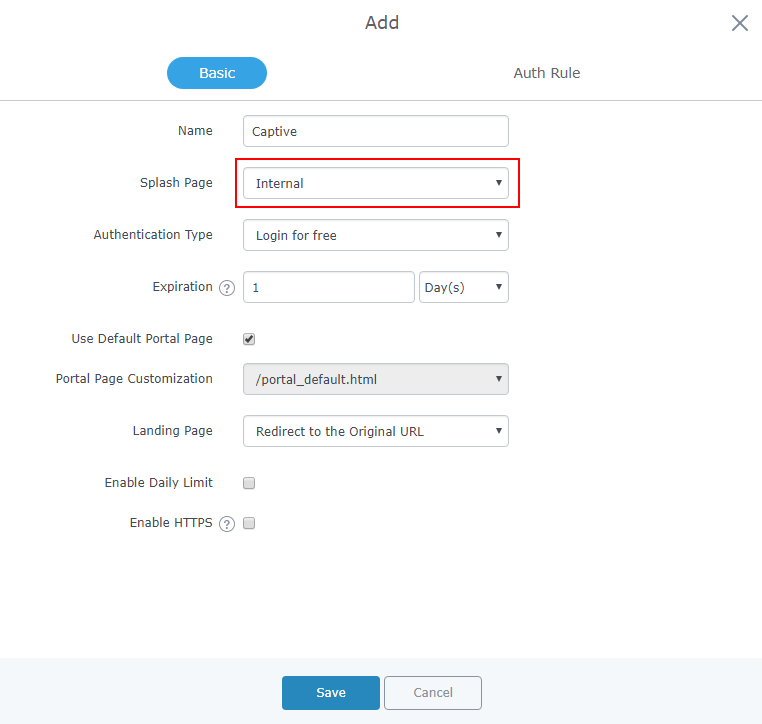
Internal Splash Page
Below table lists the items policy add page configures.
Table 42: Captive Portal – Policy List – Splash Page is “Internal”
|
Field |
Description |
|
Name |
Enter the name of the Captive Portal policy |
|
Splash Page |
Select Splash Page type, Internal or External. |
|
Following types of authentication are available:
| |
|
Expiration |
Configures the period of validity, after the valid period, the client will be re-authenticated again. |
|
If Authentication Type is set to “RADIUS Authentication” | |
|
RADIUS Server Address |
Fill in the IP address of the RADIUS server. |
|
RADIUS Server Port |
Set the RADIUS server port, the default value is 1812. |
|
RADIUS Server Secret |
Fill in the key of the RADIUS server. |
|
RADIUS Authentication Method |
Select the RADIUS authentication method, 3 methods are available: PAP, CHAP and MS-CHAP. |
|
If Authentication Type is set to “Social Login Authentication” | |
|
|
Check to enable/disable WeChat Authentication |
|
Shop ID |
Fill in the Shop ID that offers WeChat Authentication. |
|
APP ID |
Fill in the APP ID provided by the WeChat in its web registration page |
|
Secret Key |
Set the key for the portal, once clients want to connect to the Wi-Fi, they should enter this key. |
|
|
Check to enable/disable Facebook Authentication |
|
Facebook App ID |
Fill in the Facebook App ID. |
|
Facebook APP Key |
Set the key for the portal, once clients want to connect to the Wi-Fi___33, they should enter this key. |
|
|
Check this box to enable Twitter Authentication. |
|
If checked, users need to Follow owner before been authenticated. | |
|
Owner |
Enter the app Owner to use Twitter Login API. This field appears only when Force to Follow is checked. |
|
Consumer Key |
Enter the app Key to use Twitter Login API. |
|
Consumer Secret |
Enter the app secret to use Twitter Login API. |
|
For all Authentication Types | |
|
Use Default Portal Page |
If checked, the users will be redirected to the default portal page once connected to the GWN. If unchecked, users can manually select which Portal Page to use from Portal Page Customization drop-down list. |
|
Select the customized portal page (if “Use Default Portal Page” is unchecked).
| |
|
Choose the landing page, 2 options are available:
| |
|
Redirect External Page URL Address |
Once the landing page is set to redirect to external page, user should set the URL address for redirecting. This field appears only when Landing Page is set to “Redirect to an External Page”. |
|
If enabled, captive portal will limit user connection by times of one day. | |
|
If checked, AP will grant access to STA if AP can’t reach to external authentication server. This option is available only when Authentication Type is set to “RADIUS Server” or “Vouchers”. | |
|
Enable HTTPS |
Check to enable/disable HTTPS service. |
External Splash Page
Table 43: Captive Portal – Policy List – Splash Page is “External”
|
Field |
Description |
|
Name |
Enter the name of the Captive Portal policy |
|
Select to either use Internal or External Splash Page. | |
|
Select which external captive portal platform to use:
| |
|
Enter the External Splash Page URL, and make sure to enter the pre-authentication rules request by the external portal platform in the pre-authentication configuration option. | |
|
Fill in the IP address of the RADIUS server. | |
|
Set the RADIUS server port, the default value is 1812. | |
|
Fill in the key of the RADIUS server. | |
|
Configures the address for the RADIUS accounting server. | |
|
Configures RADIUS accounting server listening port (default is 1813). | |
|
Enter the secret password for client authentication with RADIUS accounting server. | |
|
Enter Update Interval for RADIUS Accounting Server. The interval unit can be set by seconds, minutes, hours or days. | |
|
Enter RADIUS NAS ID. This field appears only when Platform is set to “Linkyfi Platform” or “Universal Platform”. | |
|
Specify URL where to redirect clients after authentication. |
In case social media authentication is used, the user needs to allow some traffic between the AP and social medial platforms (Facebook API as example) to send authentication credentials and receive reply, this traffic can be allowed using the Authentication rules which are explained below.
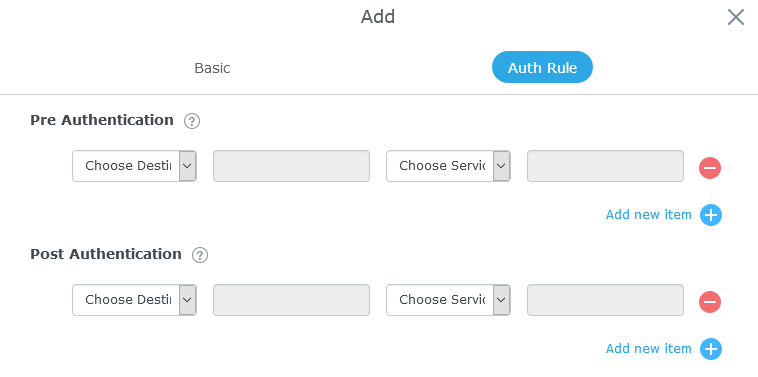
Using this option, users can set rules to match traffic that will be allowed for connected Wi-Fi users before authentication process. This can be needed for example to setup Facebook authentication where some traffic should be allowed to Facebook server(s) to process the user’s authentication. Or simply to be used to allow some type of traffic for unauthenticated users.
On the other hand, post authentication rules are used to match traffic that will be banned for Wi-Fi clients after authentication. As an example, if you want to disallow connected Wi-Fi clients to issue Telnet or SSH traffic after authentication then you can set post authentication rules to match that traffic and once a connected client passes the authentication process they will be banned from issuing telnet and SSH connections.
Splash Page
Files configuration page allows users to view and upload HTML pages and related files (images…).
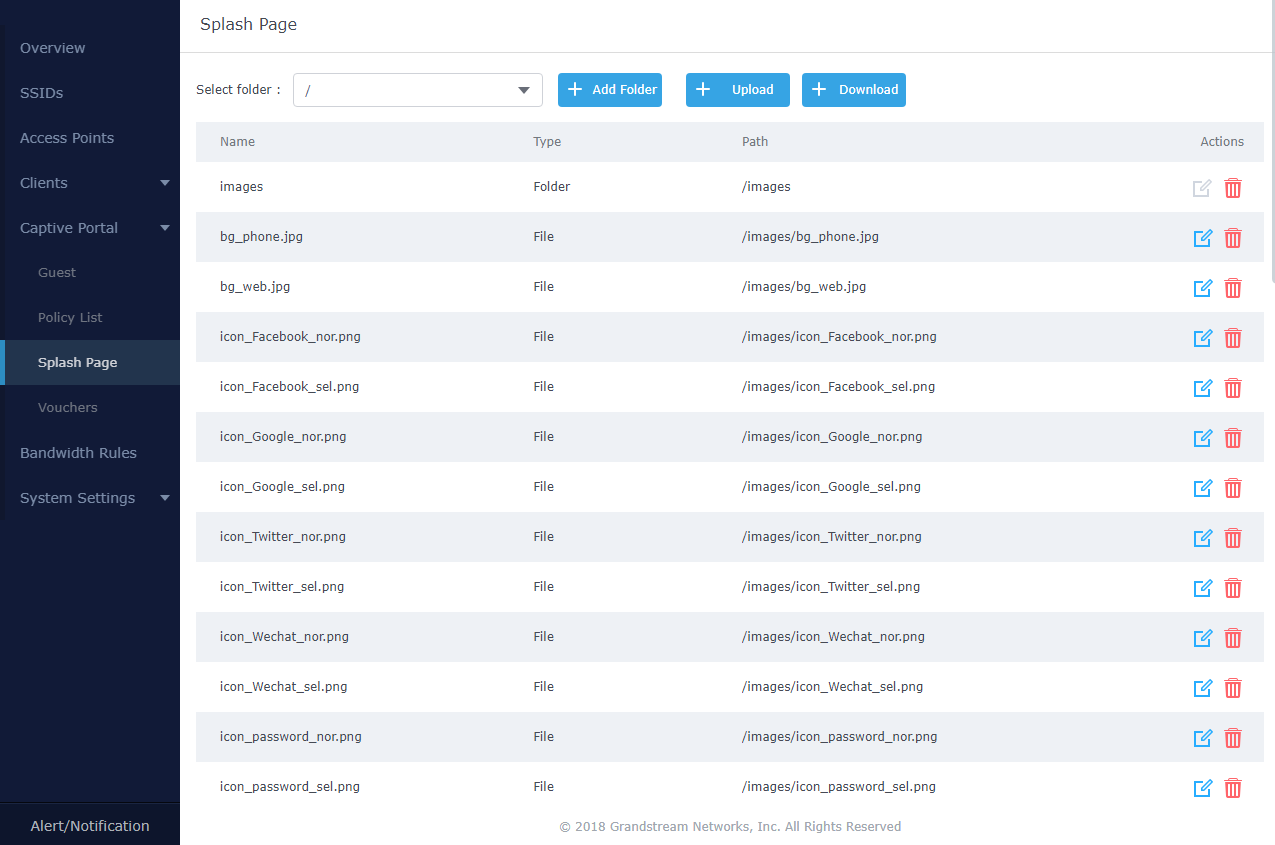
User can add folder in corresponding folder by selecting the folder and click on .
- Click on
to upload a file from local device.
- Click on
to download the files in Captive Portal folder.
- Click on
to edit the corresponding file, in another word, to replace the file with a new one.
- Click on
to delete the file.
Vouchers
Voucher Feature Description
Voucher feature will allow clients to have internet access for a limited duration using a code that is randomly generated from GWN controller.
As an example, a coffee shop could offer internet access to customers via Wi-Fi using voucher codes that can be delivered on each command. Once the voucher expires the client can no longer connect to the internet.
Note that multiple users can use a single voucher for connection with expiration duration of the voucher that starts counting after first successful connection from one of the users that are allowed.
Another interesting feature is that the admin can set data bandwidth limitation on each created voucher depending on the current load on the network, users’ profile (VIP customers get more speed than regular ones…etc.) and the internet connection available (fiber, DSL or cable…etc.) to avoid connection congestion and slowness of the service.
Each created voucher can be printed and served to the customers for usage, and the limit is 1000 vouchers.
The usage of voucher feature needs to be combined with captive portal that is explained after this section, in order to have the portal page requesting clients to enter voucher code for authentication.
Voucher Configuration
To configure/create vouchers for clients to use, follow below steps:
- On controller web GUI, navigate under “Captive Portal 🡪 Vouchers”
- Click on
button in order to add a new voucher.
- Enter voucher details which are explained on the next table.
- Press save to create the voucher(s).
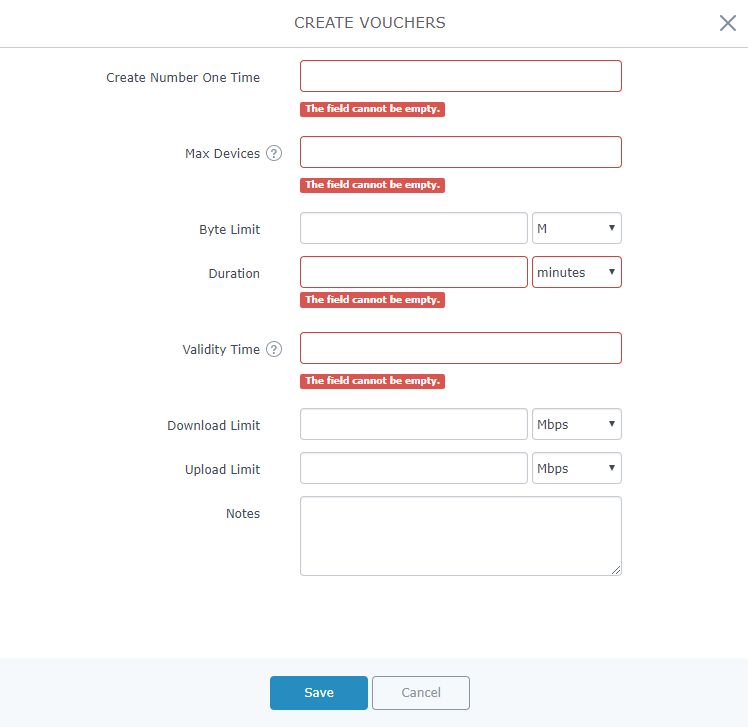
The below figure shows the status of the vouchers after GWN randomly generates the code for each one.
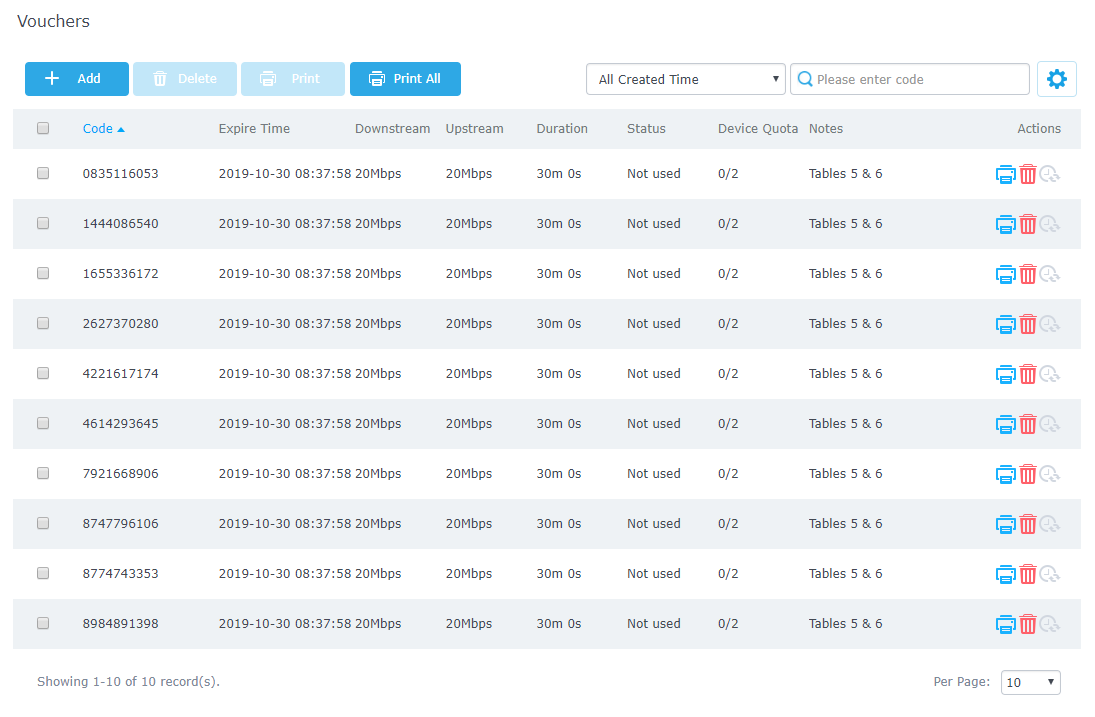
Users can click on buttons and
to delete and print multiple vouchers or click
button to print all vouchers at once.
Also, users can use the drop-down list filter to filter the vouchers that where created at specific date-time.
The following table summarizes description for voucher configuration parameters:
|
Field |
Description |
|
Create Number One Time |
Specify how many vouchers to generate which will have same profile/settings (duration, bandwidth and number of users). Valid range: 1 – 1000. |
|
Max Devices |
Specify how many users can use same voucher. Valid range: 1 – 5. |
|
Duration |
Specify the duration after which the voucher will expire, and clients will be disconnected from internet. Note: in case or multiple users, the duration will start counting after first user starts using the voucher. |
|
Validity Time |
Set the validity period of credentials, limited to 1-365 integer. The unit is day. |
|
Download Limit |
Set the downstream bandwidth speed limit (in Kbps or Mbps). |
|
Upload Limit |
Set the upstream bandwidth speed limit (in Kbps or Mbps). |
|
Notes |
Notes for the admin when checking the list of vouchers. |
Using Voucher with GWN Captive Portal
In order to successfully use the voucher feature, users will need to create a captive portal in order to request voucher authentication codes from users before allowing them access to internet. More details about captive portal will be covered on next section but for voucher configuration please follow below steps.
- Go under “Captive Portal 🡪 Captive portal” menu.
- Press
in order to add new captive portal policy.
- Set the following parameters as shown on the screenshot for basic setup then save and apply.
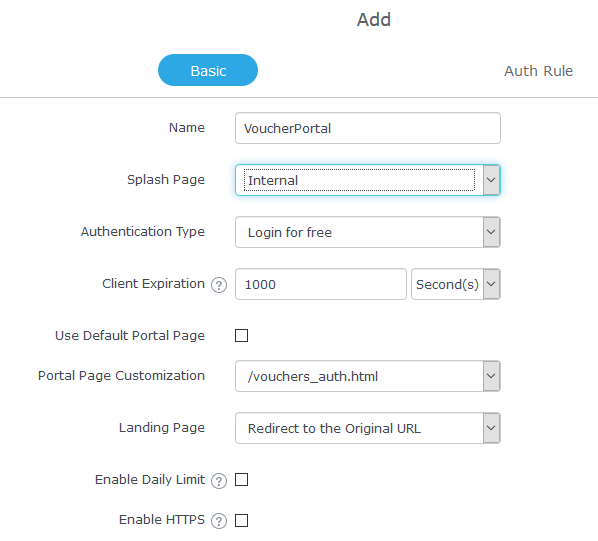
Then go under your SSID configuration page and enable the generated captive portal under Wi-Fi settings tab.
BANDWIDTH RULES
The bandwidth rule is a GWN7000 feature that allows users to limit bandwidth utilization per SSID or client (MAC address or IP address).
This option can be configured from the GWN7000 router web UI under “Bandwidth Rules”.
Click to add a new rule, the following table provides an explanation about different options for bandwidth rules.
The following figure shows an example of MAC address rule limitation.
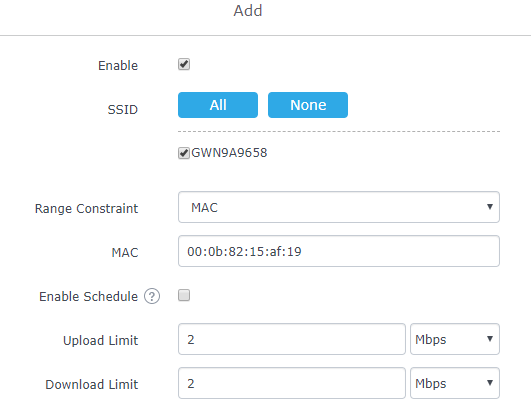
The following figure shows examples of bandwidth rules:

WEBSITE BLOCKING
Website blocking is a feature that allows the system administrator to download filter lists or create their own filter lists to block DNS queries to some domains. These lists can be used to block adware sites, malware sites, and can be used to block popular social media websites (Facebook, YouTube…etc).
The administrator is able to apply this feature to any combination of network groups or clients.
In order to configure website blocking policy follow the next steps:
Create Blackhole Policy
First, you need to create blocking policies on which you specify the list of domains to be blocked or allowed or specify URL from which download full list of unwanted bad domains such as malware domains.
To do so go under “System Settings 🡪 Website Blocking 🡪 Blackhole policy” and press to create a new policy.
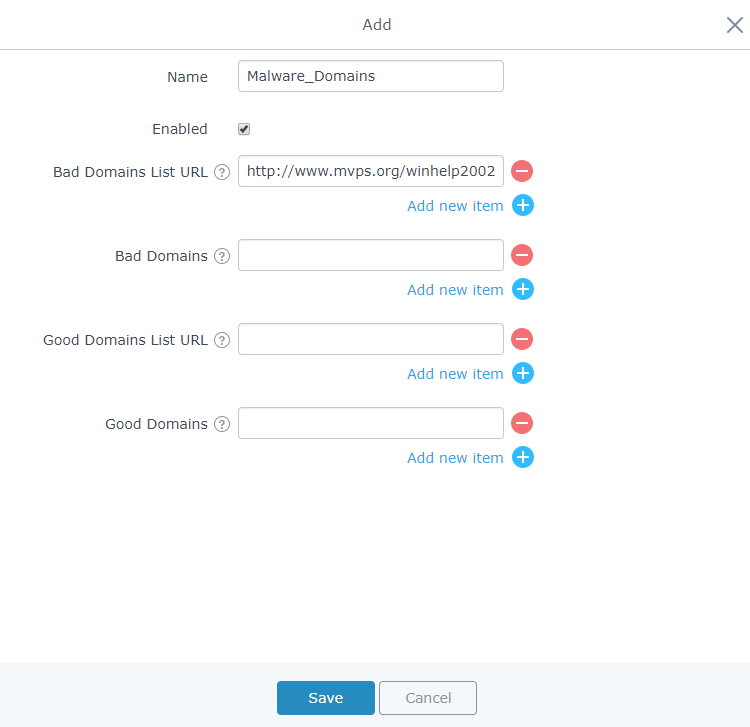
On the figure above, we set the link from which the GWN will go and fetch all domain names that would be considered as bad domains and blocked.
After this, save and apply the changes and the new policy will be displayed along the existing ones.
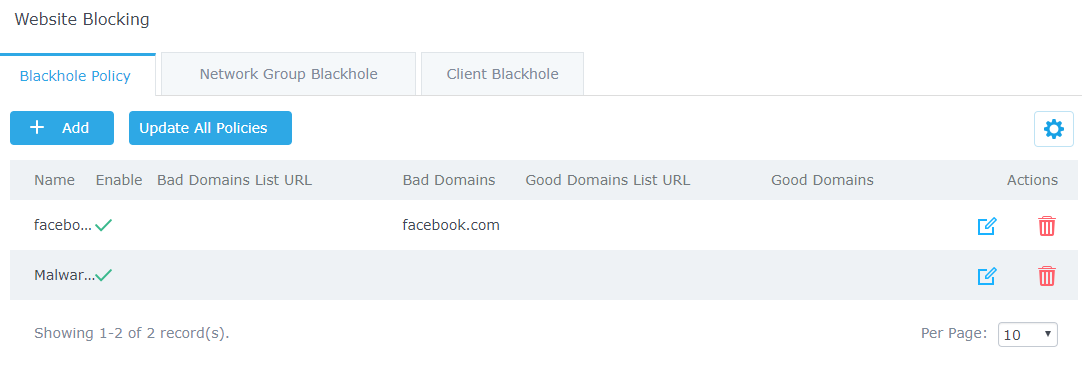
Assign Blackhole Policy to Network Groups
Now, that we have created a policy. It’s time to assign it to a network group or client. To assign a blocking policy to a network group go under “System Settings 🡪 Website Blocking 🡪 Network Group Blackhole” and press add .
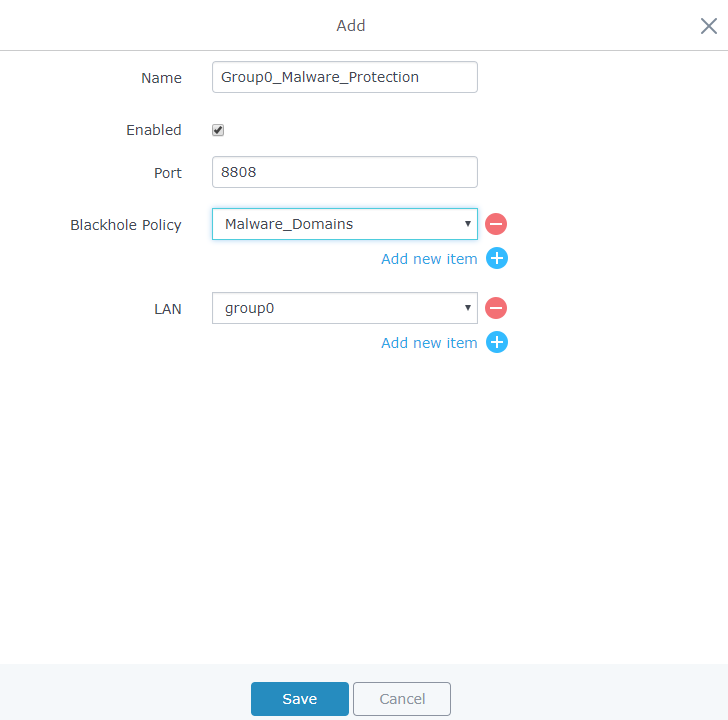
Give the network group blackhole a name, then check the box to enable it, after that set a binding port for the blackhole (range valid from 1025 to 65535) and select which policy(s) to apply to which network group(s).
Note: A network group can be assigned to only one network group blackhole, thus you need to apply all required blocking policies to a specific network group to its network group blackhole policy.
Press save and apply and the changes, and now all clients within network group0 are banned (protected) from malware websites.
Assign Blackhole Policy to Clients
Another possibility, it to create client based blackhole(s) on which the policy will apply to specific client(s) defined by a CACL (Client Access Control List) and on this case, the admin is left with the choice to either force the network group policy on this client along with its specific policy or ignore the network group definition and keep only the client-based policy.
For example, with the configuration above and while maintaining the blocking of malware websites on group0, we want to block Facebook access from some specific clients defined on access list 1.
We assume that we have already created a blocking policy under “System Settings 🡪 Website blocking 🡪 Blackhole Policy” to set Facebook.com as bad domain.
Next, go under “Clients 🡪 Client Access” to define the list of clients to whom the policy will apply.

Finally, and in order realize the scenario above, go under “System Settings 🡪 Website Blocking 🡪 Client Blackhole” and click on .
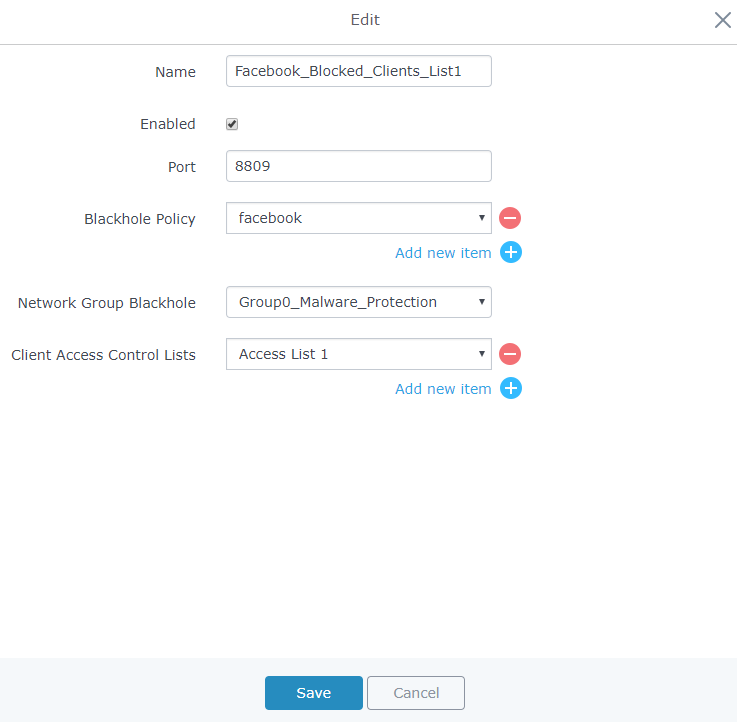
On this case, we can either force the network group policy that was created for the full group0 along with the new blackhole policy (Facebook) or ignore it and assign only the Facebook blocking policy to the clients specified on list1.
MAINTENANCE AND TROUBLESHOOTING
GWN7000 offers multiple tools and options for maintenance and debugging to help further troubleshooting and monitoring the GWN7000 resources.
Maintenance
Maintenance page can be accessed from GWN7000 WebGUI🡪System Settings🡪Maintenance.
Maintenance page includes different tabs: Basic, Upgrade, Access, Syslog and Logserver.
Basic
|
Anti-domain name hijacking protection. If enabled, when the address returned by the superior DNS is a private LAN address, it will be regarded as a domain name hijacking, thus discarding the analytical result. If disabled, the analytical result will not be discarded. | |
|
Enable the web WAN access. By default, it’s disabled | |
|
Enable the web HTTP Access. By default, it’s disabled. | |
|
Specifies the HTTPS port. By default, is 443. | |
|
Country |
Select the country from the drop-down list. |
|
Time Zone |
Configure time zone for the GWN7000. Please reboot the device to take effect. |
|
NTP Server |
Configure the IP address or URL of the NTP server, the device will obtain the date and time from the configured server. |
|
Date Display Format |
Change the Date Display Format, three options are possible YYYY/MM/DD, MM/DD/YYYY and DD/MM/YYYY |
|
Reboot Schedule |
Select the pre-configured schedule (System Settings 🡪 Schedule), once a schedule is selected, then the network will not be working for a while (reboot duration during the scheduled reboot duration. |
Upgrade
Table 47: Maintenance – Upgrade
|
Authenticate Config File |
Authenticate configuration file before acceptance. Default is disabled. |
|
XML Config File Password |
Enter the password for encrypting the XML configuration file using OpenSSL. The password is used to decrypt the XML configuration file if it is encrypted. |
|
Upgrade Via |
Specify uploading method for firmware and configuration. 3 options are available: HTTP, HTTPS and TFTP. |
|
Firmware Server |
Configure the IP address or URL for the firmware upgrade server. |
|
Config Server |
Configure the IP address or URL for the configuration file server. |
|
Check Update on Boot |
Choose whether to enable or disable automatic upgrade and provisioning after reboot. Default is disabled. |
|
Automatic Upgrade Check Interval(m) |
Specify the time period to check for firmware upgrade (in minutes). |
|
Reboot |
Click on Reboot button to reboot the device |
|
Download Configuration |
Click on Download to download the device’s configuration file. |
|
Upgrade Now |
Click on Upgrade, to launch firmware/config file provisioning. Please make sure to Save and Apply changes before clicking on Upgrade. |
|
Factory Reset |
Click on Reset to restore the GWN7000 as well as all online GWN76xx units to factory default settings |
Access
Table 48: Maintenance – Access
|
Current Administrator Password |
Enter the current administrator password |
|
New Administrator Password |
Change the current password. This field is case sensitive with a maximum length of 32 characters. |
|
Confirm New Administrator Password |
Enter the new administrator password one more time to confirm. |
|
User Password |
Configure the password for user-level Web GUI access. This field is case sensitive with a maximum length of 32 characters. |
|
User Password Confirmation |
Enter the new User password again to confirm. |
Syslog
Table 49: Maintenance – Syslog
|
Syslog Server |
Enter the IP address or URL of Syslog server. Please reboot the GWN7000 to take effect. |
|
Syslog Level |
Select the level of Syslog, 5 levels are available: None, Emergency, Alert, Critical, Error, Warning, Notice, Information and Debug. Please reboot the GWN7000 to take effect. |
Logserver
The logserver page allows the user to configure syslog server on GWN7000 in order to save log messages on connected external USB drive.
First connect a USB drive to the Access point, then configure the parameters and make sure to start the server in order to collect messages from devices sending syslog to GWN.
Following table gives description for configuration parameters of GWN Logserver:
|
Option |
Description |
|
Enable WAN Firewall Rule |
Enable WAN Firewall rules to allow incoming syslog messages to the router. |
|
Logrotate File Size |
Select the size of file to trigger rotation, if left empty, then the router will use only the Logrotate frequency rules to trigger rotation. |
|
Logrotate File Count |
Select the Maximum number of rotates files to keep. Default is 56 files. |
|
Logrotate Mode |
Choose the time rotation frequency mode (default every 3 hours).
|
|
Hours |
Enter the number of hours period after which trigger file rotation. |
|
Minutes |
Enter the number of Minutes period after which trigger file rotation. |
|
Hour of the day |
Enter the hour of day at which trigger file rotation. |
|
Day of the week |
Enter Day of the week + hour of day, at which trigger file rotation. |
|
Devices |
Select the path (a USB partition) to store collected logs. Required. |
|
Enable Logserver |
Enables the logserver |
After setting up the logserver and saving the settings, users need to connect a USB external storage and press Start button in order to start collecting logs.
All log messages from all devices will be put on one single file, and the router will keep rotating and creating new files based on the configured rotation policy.
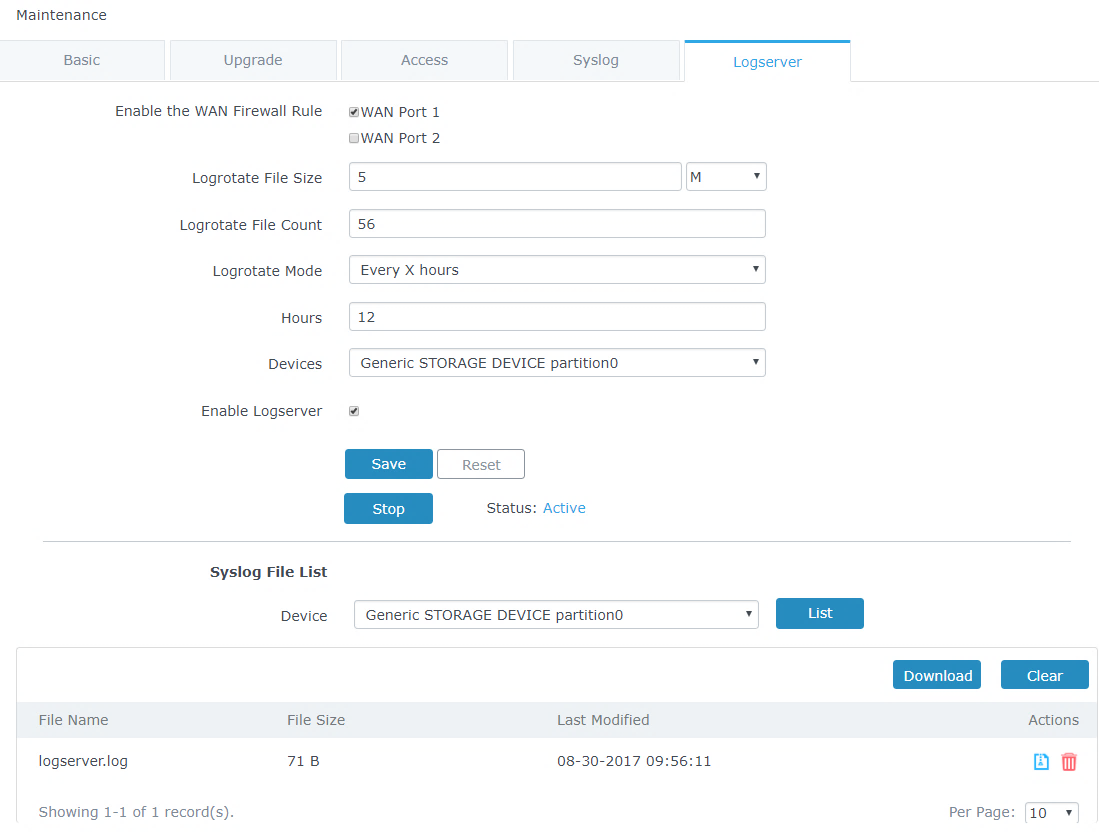
Debug
Many debugging tools are available on GWN7000’s WebGUI to check the status and troubleshoot GWN7000’s services and networks.
Debug page offers 4 tabs: Capture, Ping/Traceroute, Syslog and Connection Table.
Capture
This section is used to capture packet traces from the GWN7000 interfaces (WAN ports and network groups) for troubleshooting purpose or monitoring…
It is needed to plug an USB storage device to one of the USB ports on the back of the GWN7000.
- Click on
to start capturing on a certain device plugged to the USB port.
- Click on
to stop the capture.
- Click on
to show the captured files on a chosen device, and the capture files details will appear, click on
to delete all files, click on
next to a capture file to download it on a local folder, or click on
to delete it.

The below table will show different fields used on capture page
|
File Name |
Enter the name of the capture file that will be generated. |
|
Interface |
Choose an Interface (WAN port1 or 2, or a network group) from where to begin the capture. |
|
Device |
Choose a device plugged to USB port to save the capture once started. |
|
File Size |
Set a File size that the capture will not exceed (Optional field). |
|
Rotate Count |
Set a value for rotating captures (Optional Field). |
|
Direction |
Choose if you want to get all traffic or only outgoing or incoming to the choses interface. |
|
Source Port |
Set the Source Port to filter capture traffic coming from the defined source port. |
|
Destination Port |
Set the Destination Port to filter capture traffic coming from the defined port. |
|
Source IP |
Set the Source IP to filter capture traffic coming from the defined source IP. |
|
Destination IP |
Set the Destination IP to filter capture traffic coming from the defined destination IP. |
|
Protocol |
Choose ALL or a specific protocol to capture (IP, ARP, RARP, TCP, UDP, ICMP, IPv6) |
Ping/Traceroute
Ping and Traceroute are useful debugging tools to verify reachability with other clients across the network (WAN or LAN). The GWN7000 offers both Ping and Traceroute tools for IPv4 and IPv6 protocols.
To use these tools, go to GWN7000 WebGUI🡪System Settings🡪Debug and click on Ping/Traceroute.
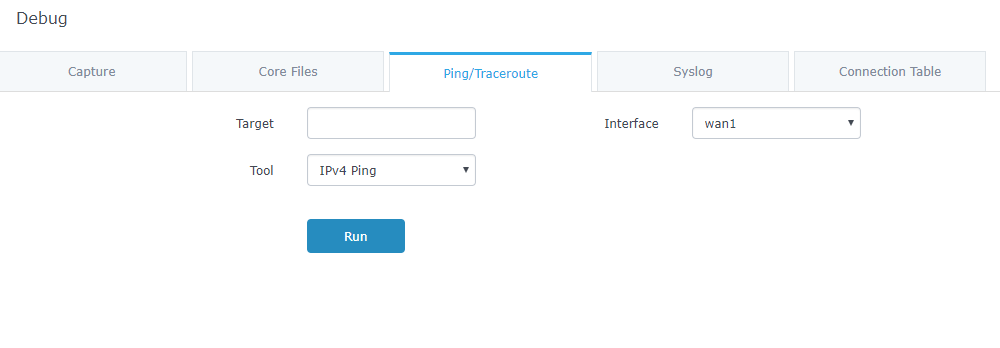
- Type in the destination’s IP address/domain name in Target field.
- Select from which interface to issue the Ping/Traceroute from Interface dropdown list.
- Next to Tool choose from the dropdown menu:
- IPv4 Ping for an IPv4 Ping test to Target
- IPv6 Ping for an IPv6 Ping test to Target
- IPv4 Traceroute for an IPv4 Traceroute to Target
- IPv6 Traceroute for an IPv6 Traceroute to Target
- Click on Run.
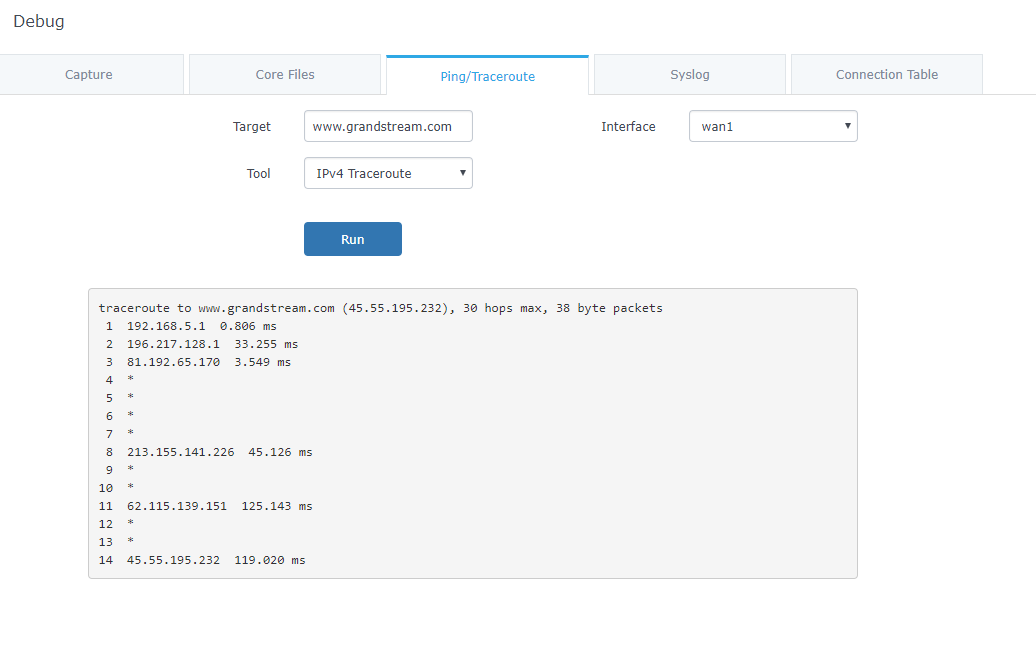
Syslog
GWN7000 supports dumping the syslog information to a remote server under Web GUI🡪System Settings🡪Maintenance🡪Syslog.
Enter the syslog server hostname or IP address and select the level for the syslog information. Five levels of syslog are available: None, Debug, Info, Warning, and Error.
Syslog messages are also displayed in real time under Web GUI🡪System Settings🡪Debug🡪Syslog.
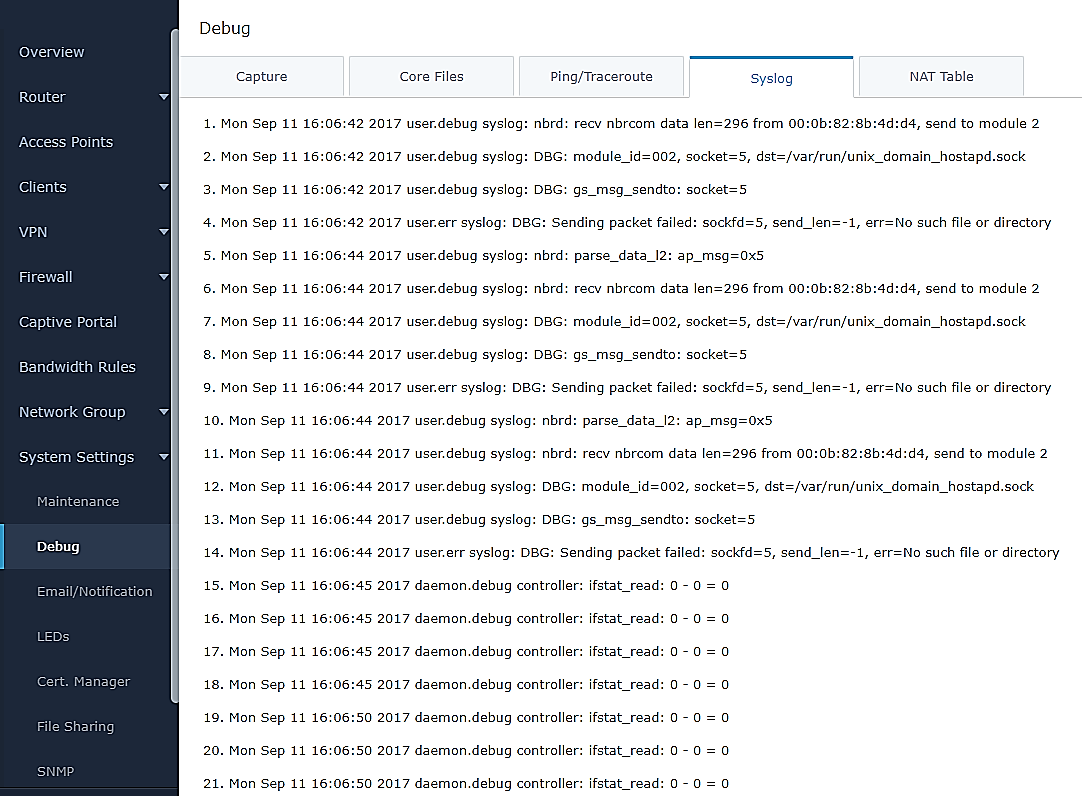
Connection Table
NAT table is updated dynamically on GWN7000’s WebGUI, to check the NAT table go to System Settings🡪Debug🡪Connection Table.
Users could press button to clear all entries.
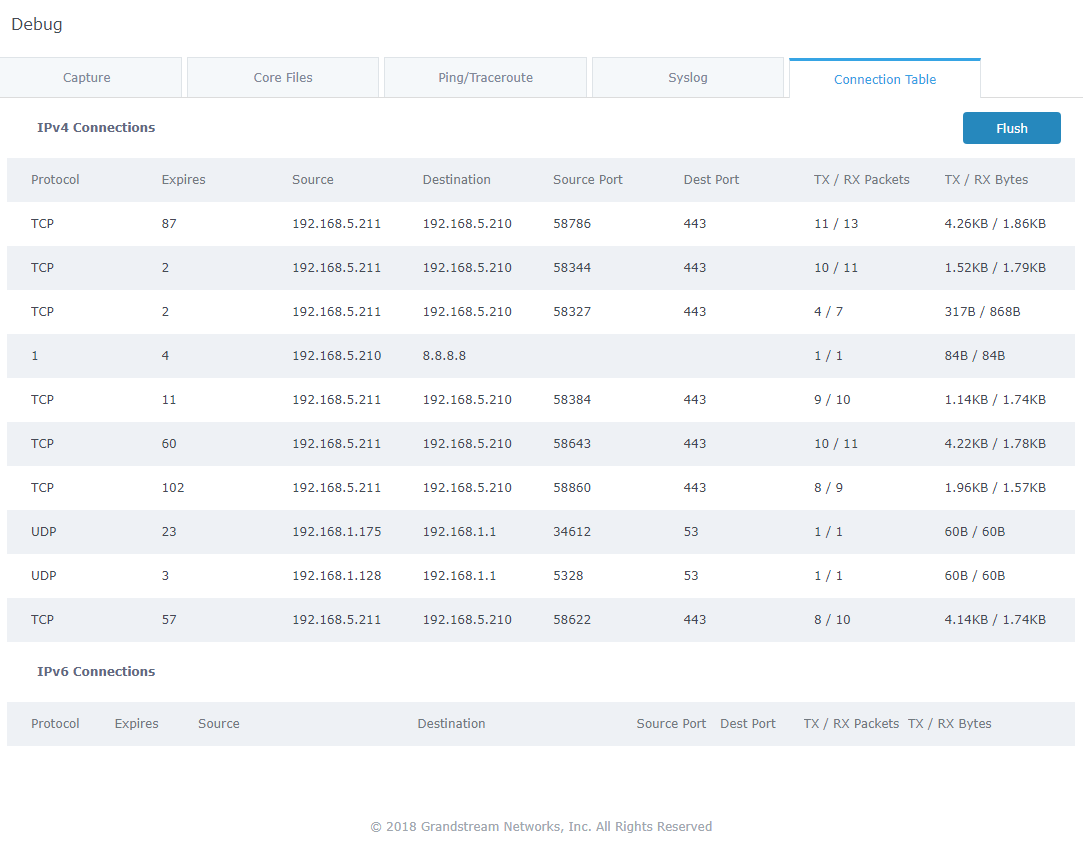
Email/Notification
The Email/Notification page allows the administrator to select a predefined set of system events and to send notifications upon the change of the set events.
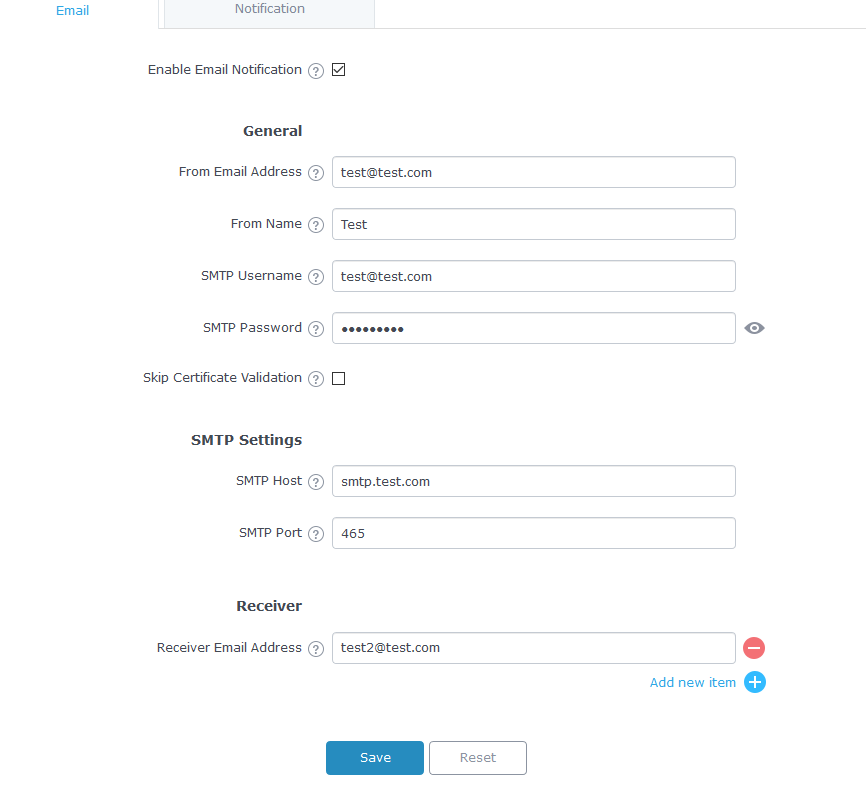
|
Filed |
Description |
|
Enable Email Notification |
Once enabled, AP will send related notification email to the the receivers. Note: if no event is specified in the Notification page, server will send an empty mail. |
|
General | |
|
From Email Address |
Specify the email address of the notification sender. If the address is not specified, AP will use the SMTP username as a sender. |
|
From Name |
Specifies the name of the notification sender. |
|
SMTP Username |
Specifies the username to login to the mail server |
|
Email Address |
Specifies the email address of the administer where to receive notifications. |
|
Skip Certificate Validation |
Check this box to skip the certificate validation |
|
SMTP Settings | |
|
SMTP Host |
Configures the SMTP Email Server IP or Domain Name. |
|
SMTP Port |
Specifies the Port number used by server to send email. |
|
Receiver Email Address |
Specifies the email addresses to receive notifications. |
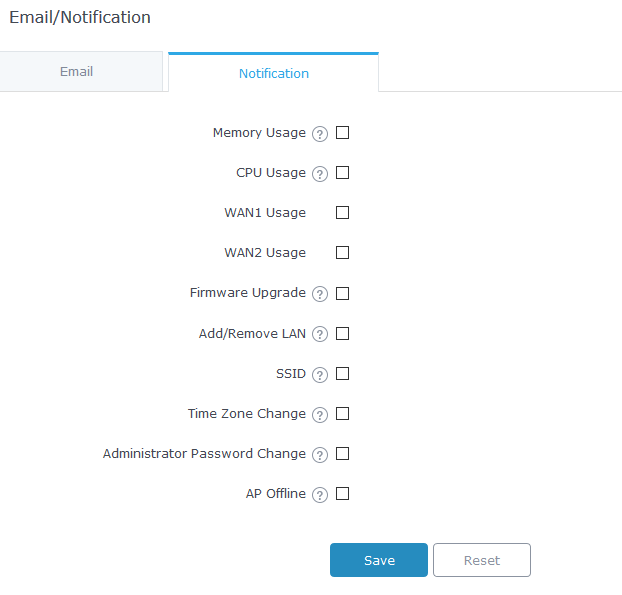
The following table describe the notifications configuration settings.
|
Filed |
Description |
|
Enabled |
Enable/disable the notification. By default, it’s disabled |
|
Memory Usage |
Configures whether to send notification if memory usage is greater than the configured threshold. By default, it’s disabled. |
|
Memory Usage Threshold (%) |
Specifies the Memory Usage Threshold (%). Must be integer between 1 and 100. |
|
CPU Usage |
Configures whether to send notification if CPU usage is greater than the configured threshold. By default, it’s disabled. |
|
CPU Usage Threshold (%) |
Specifies the CPU Usage Threshold (%). Must be integer between 1 and 100. |
|
WAN1 Usage |
Configures whether to send notification if WAN1 usage is greater than the configured threshold. By default, it’s disabled. |
|
WAN1 Usage Threshold (%) |
Specifies the WAN1 Usage Threshold (%). Must be integer between 1 and 100. |
|
WAN2 Usage |
Configures whether to send notification if WAN2 usage is greater than the configured threshold. By default, it’s disabled. |
|
WAN2 Usage Threshold (%) |
Specifies the WAN2 Usage Threshold (%). Must be integer between 1 and 100. |
|
Firmware upgrade |
Configures whether to send notification on firmware upgrade. Default is disabled. |
|
Add/Remove LAN |
Configures whether to send notification on LAN added or removed. Default is disabled. |
|
SSID |
Configures whether to send notification if any SSID is enabled. Default is disabled. |
|
Time Zone Change |
Configures whether to send notification on time zone change. Default is disabled. |
|
Administrator Password Change |
Configures whether to send notification on admin password change. Default is disabled. |
|
AP Offline |
Configures whether to send notification when AP going offline. Default is disabled. |
Schedule
Users can use the schedule configuration menu to set specific schedule for GWN features while giving the flexibility to specify the date and time to turn ON/OFF the selected feature.
The Schedule can be used for settings up specific time for Wi-Fi where the service will be active or for LED schedule or bandwidth rules …etc.
In order to configure a new schedule, follow below steps:
- Go under “Schedule” and click on Create New Schedule.
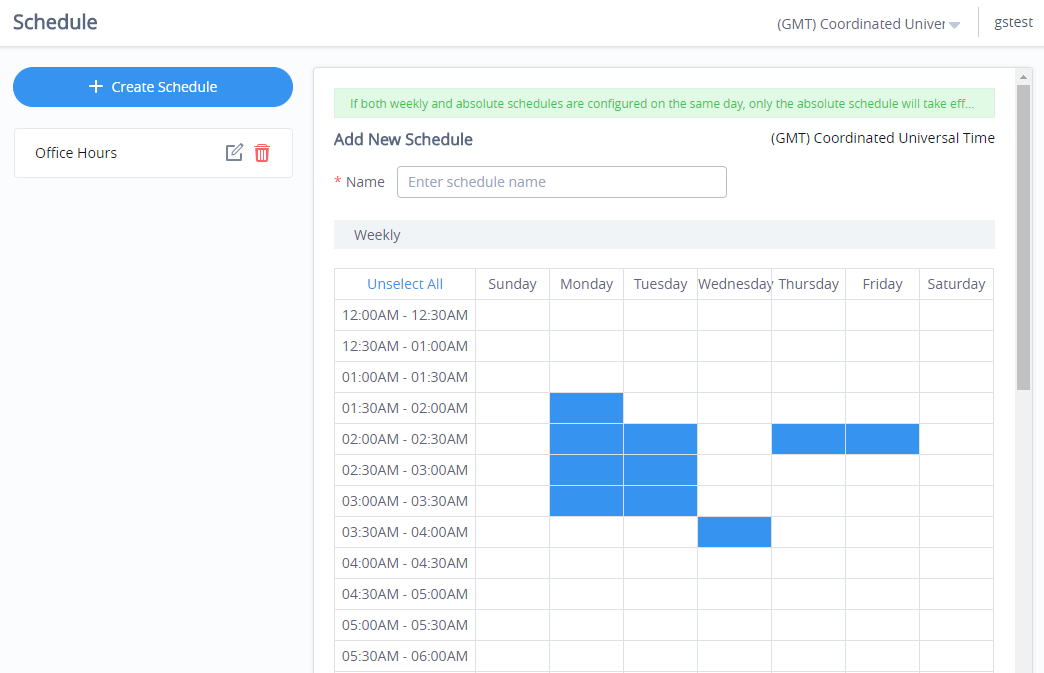
2. Select the periods on each day that will be included on the schedule and enter a name for the schedule (ex: office hours).
3. Users can choose to set weekly schedule or absolute schedule (for specific days for example), and if both weekly schedule and absolute schedules are configured on the same day then the absolute schedule will take effect and the weekly program will be cancelled for that specific date.
4. Once the schedule periods are selected, click on Save to save the schedule.
5. The list of created schedules will be displayed as shown on the figure below. With the possibility to edit or delete each schedule:
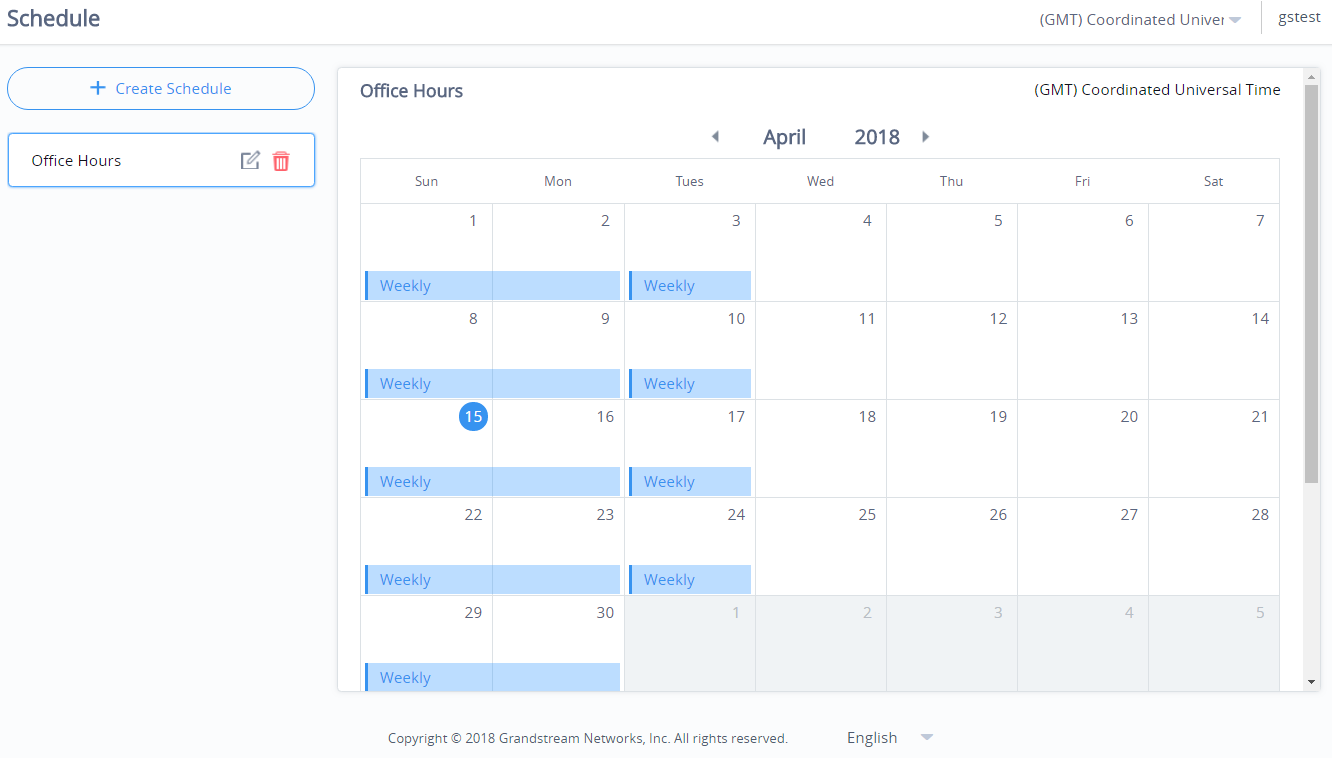
LED
GWN76xx Access Points series support also the LED schedule feature. This feature is used to set the timing when the LEDs are ON and when they will go OFF at customer’s convenience.
This can be useful for example when the LEDs become disturbing during some periods of the day, this way with the LED scheduler, you can set the timing so that the LEDs are off at night after specific hours and maintain the Wi-Fi service for other clients without shutting down the AP.
To configure LED schedule, on the GWN76xx AP WebGUI navigate to “System Settings🡪LEDs”.
Following options are available:
|
Field |
Description |
|
LEDs Always Off |
Configure whether to disable the AP LED dictator |
|
Schedule |
Please choose a schedule to assign to LEDs, users can configure schedules under the menu Schedule |
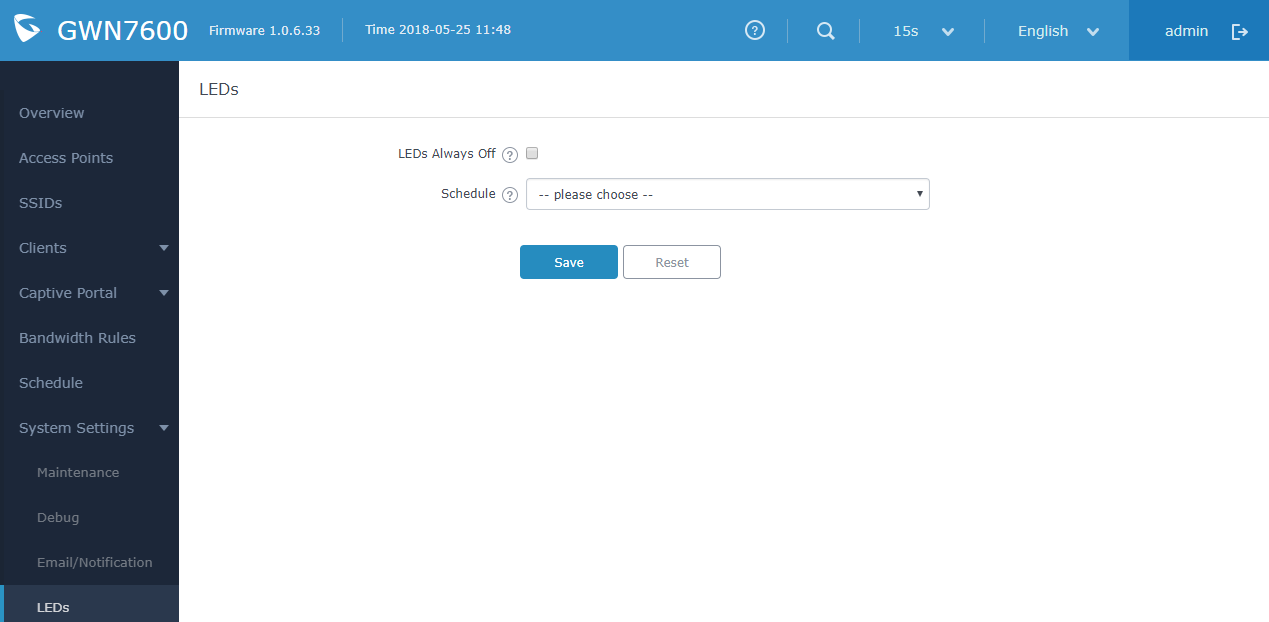
File Sharing
The GWN7000 has 2 USB ports that can be also used for file sharing, to enable file sharing on devices plugged on the USB ports, go to System Settings🡪File Sharing.
Click on to share a directory and its contents on a device connected to one of the USB ports of the GWN7000, the following figure will pop up.
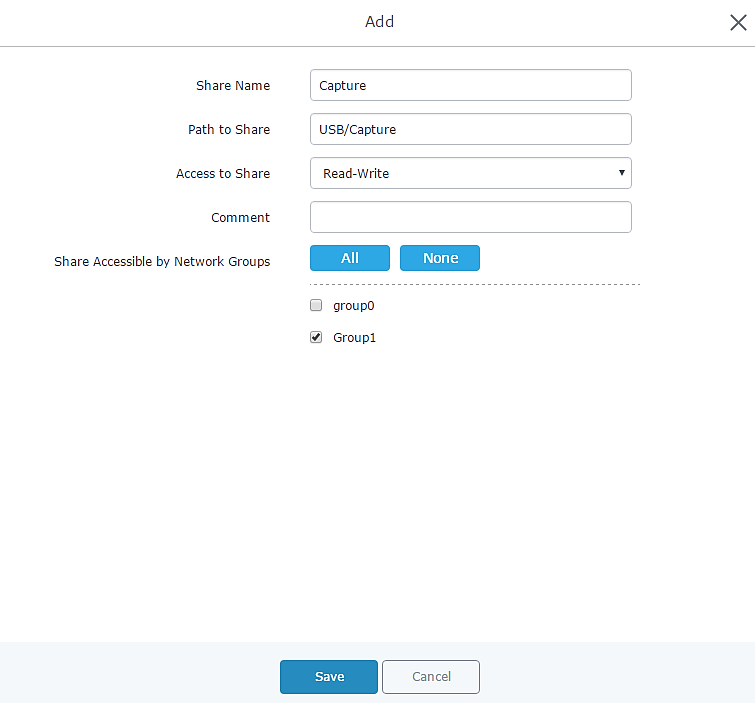
Table 54: Add a New File to Share
|
Share Name |
Enter the share name |
|
Path to Share |
Choose from the drop menu the path to share. |
|
Access to Share |
Choose whether to allow users to Read/Write or Read Only on the shared path. |
|
Comment |
Enter a comment for the added shared file. |
|
Share Accessible by LAN |
Choose whether to allow All LANs to access the shared path, restrict access by selecting only some groups or None. |
Edit a Shared Folder by clicking on or delete it by clicking on
.

A device connected to one of the allowed network groups to the shared files can use the following path for access: \\GWN_Address\Share_Name\ Where GWN_Address is the GWN7000 IP address, and Share_Name is the Share Name created for the File Share. It is also possible to map a network drive on Windows, or use a Samba client on Linux machine.
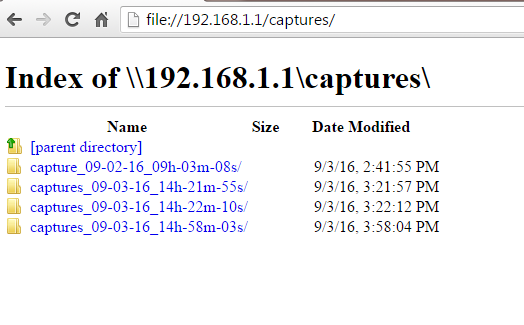
SNMP
GWN7000 supports SNMP (Simple Network Management Protocol) which is widely used in network management for network monitoring for collecting information about monitored devices.
To configure SNMP settings, go to GWN7000 Web GUI🡪System Settings🡪SNMP, this page has two tabs: Basic and Advanced, refer to the below tables for each tab.
|
System Location |
Set the System Location information, for example: SNMP-Server Lobby GWN. |
|
System Contact |
Set the System Contact information, for example: Contact Supervisor_GWN via extension is 1000. |
|
System Name |
Set the System Name information, for example: Supervisor_GWN. |
|
Read-Only Community for IPv4 |
Gives the permission for the set community to access and read only to devices in management information base via IPv4 Protocol. |
|
Read-Write Community for IPv4 |
Gives the permission for the set community to access and read/write to devices in management information base via IPv4 Protocol. |
|
Read-Only Community for IPv6 |
Gives the permission for the set community to access and read only to devices in management information base via IPv6 Protocol. |
|
Read-Write Community for IPv6 |
Gives the permission for the set community to access and read/write to devices in management information base via IPv6 Protocol. |
|
Trap Type |
Choose the Trap Type from drop-down menu, 4 options are available: None, SNMPv1, SNMPv2c and SNMPv2cInforms. |
|
Monitoring Host |
Enter the Monitoring Host’s IP/Domain Name (Network Management System “NMS”) |
|
Monitoring Host Port |
Enter the Monitoring Host’s Port (Network Management System “NMS”) |
|
Trap Community |
Enter the Trap Community string to authenticate the client against the server. |
|
SNMP Service Listening on |
Click on
|
|
SNMPv3 Users |
Click on
|
User Manager
Under this section, administrator can generate or create user accounts that will be used for VPN connection authentication, click on in order to create a new user account.
The following table summarizes the configuration parameters:
|
Option |
Description |
|
Enabled |
Check this option to enable/disable the user account. |
|
PPTP Server |
Check this option to enable the user connection to the PPTP server. |
|
Full Name |
Enter user full name. When using PPTP it defaults to pptpd. |
|
Username |
Enter user Username. |
|
Password |
Enter user password. |
|
IPSec Pre-Shared Key |
Set user pre-shared key for authentication. |
|
Enabled PPTP Client Subnet |
Check this option when using PPTP, and enter the client subnet. |
|
Client Subnet |
Configured to which subnet this client belongs to (ex: 192.168.1.0/24). |
|
OpenVPN Subnet |
Configures OpenVPN user subnet (ex: 192.168.1.0/24). |
UPGRADING AND PROVISIONING
Upgrading Firmware
The GWN7000 can be upgraded to a new firmware version remotely or locally. This section describes how to upgrade your GWN7000.
Upgrading via WEB GUI
The GWN7000 can be upgraded via TFTP/HTTP/HTTPS by configuring the URL/IP Address for the TFTP/HTTP/HTTPS server and selecting a download method. Configure a valid URL for TFTP, HTTP or HTTPS; the server name can be FQDN or IP address.
Examples of valid URLs:
firmware.grandstream.com/BETA
192.168.5.87
The upgrading configuration can be accessed via Web GUI🡪Router🡪Maintenance🡪Upgrade.
Table 58: Network Upgrade Configuration
|
Upgrade Via |
Choose the firmware upgrade method: TFTP, HTTP or HTTPS. |
|
Firmware Server |
Define the server path for the firmware server. |
|
Check/Download New Firmware and Config at Boot |
Allows the device to check if there is a firmware from the configured firmware server at boot. |
|
Configure whether to allow DHCP options 66 and 43 to override upgrade and provisioning settings. | |
|
Automatic Upgrade |
Specify the time to check for firmware upgrade (in minutes). |
|
Upgrade Now |
Click on |
Service providers should maintain their own firmware upgrade servers. For users who do not have TFTP/HTTP/HTTPS server, some free windows version TFTP servers are available for download from
http://www.solarwinds.com/products/freetools/free_tftp_server.aspx
Please check our website at http://www.grandstream.com/support/firmware for latest firmware.
Instructions for local firmware upgrade via TFTP:
- Unzip the firmware files and put all of them in the root directory of the TFTP server;
- Connect the PC running the TFTP server and the GWN7000 to the same LAN segment;
- Launch the TFTP server and go to the File menu🡪Configure🡪Security to change the TFTP server’s default setting from “Receive Only” to “Transmit Only” for the firmware upgrade;
- Start the TFTP server and configure the TFTP server in the GWN7000 web configuration interface;
- Configure the Firmware Server to the IP address of the PC;
- Update the changes and reboot the GWN7000.
End users can also choose to download a free HTTP server from http://httpd.apache.org/ or us Microsoft IIS web server.
Provisioning and backup
The GWN7000 configuration can be backed up locally or via network. The backup file will be used to restore the configuration on GWN7000 when necessary.
Download Configuration
Download the GWN7000 configurations for restore purpose under Web GUI 🡪 Router 🡪 Maintenance 🡪 Upgrade
Click on to download locally the configuration file.
Configuration Server
Configuration Server Page allows to provision the GWN7000 by putting the config file on a TFTP/HTTP or HTTPS server, and set Config Server to the TFTP/HTTP or HTTPS server used in order for the GWN7000 to be provisioned with that config server file.
Reset and Reboot
Used to reboot and reset the device to factory functions under Web GUI🡪 Router🡪 Maintenance 🡪 Upgrade by clicking on button.
Will restore all the online GWN76xx as well as well as the GWN7000 itself to factory settings.
EXPERIENCING THE GWN7000 ENTERPRISE ROUTER
Please visit our website: http://www.grandstream.com to receive the most up- to-date updates on firmware releases, additional features, FAQs, documentation and news on new products.
We encourage you to browse our product related documentation, FAQs and User and Developer Forum for answers to your general questions. If you have purchased our products through a Grandstream Certified Partner or Reseller, please contact them directly for immediate support.
Our technical support staff is trained and ready to answer all of your questions. Contact a technical support member or submit a trouble ticket online to receive in-depth support.
Thank you again for purchasing Grandstream GWN7000 Enterprise Multi-WAN Gigabit VPN Router, it will be sure to bring convenience and color to both your business and personal life
© 2002-2018 OpenVPN Technologies, Inc.
OpenVPN is a registered trademark of OpenVPN Technologies, Inc.
CHANGE LOG
This section documents significant changes from previous versions of the GWN7000 user manuals. Only major new features or major document updates are listed here. Minor updates for corrections or editing are not documented here.
- No major change.
- Added support for TLS 1.2.
- Updated the Email/Notification configuration page. [Email/Notification]
- Updated the Mesh Configuration page. [Mesh Network]
- Added configuration support of External Captive Portal Support as Linkyfi, Purple, and Universal Platform. [External Splash Page]
- Enhanced Wi-Fi Service by adding configurable options of [Beacon Interval], [DTIM Period], and [Multicast to Unicast].
- Enhanced Bandwidth Rules by adding option to limit bandwidth Per-Client. [Range Constraint]
- Added support of ARP Proxy. [ARP Proxy]
- Enhanced Client Information. [CLIENTS CONFIGURATION]
- Enhanced Captive Portal features. [Failsafe Mode] [Enable Daily Limit] [Force to Follow]
- Important security fix applied.
- Added support for static DHCP binding. [Static DHCP]
- Added date time display on Overview Page. [Overview Page]
- Added Support for custom port mapping in port mirroring. [Switch]
- Added support for policy routing. [Policy Routing]
- Split Network Group configuration into VLAN and SSID. [LAN][SSIDs]
- Added ability to select wan ports on static routes. [Static Routes]
- Added Support for Mesh Network. [Mesh Network]
- Added support for scheduling feature. [Schedule]
- Improved Schedule settings. [Schedule]
- Enhanced QoS features (ACC). [QoS]
- Added support for Vouchers feature. [Vouchers]
- Added possibility to print/delete multiple vouchers. [Vouchers]
- Added expiration period to vouchers. [Vouchers]
- Added support for Transfer AP. [Transfer AP]
- Added support for new methods of authentication in captive portal. [CAPTIVE PORTAL]
- Added support for post/pre-authentication rules on captive portal. [CAPTIVE PORTAL]
- Added option to select from which interface issue the ping/traceroute utilities. [Ping/Traceroute]
- Added option to notify admin if the wan port is down.
- Added support for IPsec VPN tunnels. [IPSec VPN Tunnel]
- Added Support for MTU configuration on WAN ports. [MTU]
- Added Support for sequential Upgrade [Sequential Upgrade]
- Added support for GRE Tunnels. [Tunnel]
- Added PPP Keep Alive option for PPTP VPN Server. [PPP Keep-Alive Interval]
- Added option to set MTU/MRU for PPTP VPN Server. [MTU] [MRU]
- Added “Flush Connection Reload” option under Firewall settings. [Flush Connection Reload]
- Added support for more syslog levels configuration. [Syslog]
- Added option to set NET port as WAN port [NET Port]
- Added support for additional WAN ports. [Additional WAN Port]
- Added DNS rebind attack protection. [Rebind Protection]
- Added support for enable/disable MPPE in both PPTP server and client. [MPPE]
- Added support for Additional Routed Subnets. [Additional IPv4 Addresses][Destination IP]
- Added support for Timed Client Disconnect and Enhanced Client Blocking. [Clients Access]
- Added support for Client Bridge (GWN76xx Access Point is required for this feature.). [Client Bridge]
- Added support for OpenApp ID for Deep Packet Inspection. [DPI]
- Added support for Syslog Server. [Logserver]
- Added support for PPTP Server. [PPTP CONFIGURATION]
- Added support for Smart Queue QoS. [QoS]
- Added support for Configurable web UI access port.[Web WAN Access][Web HTTP Access][Web HTTPS Port]
- Added support for E-mail notifications. [Email/Notification]
- Added support for Captive Portal [CAPTIVE PORTAL]
- Added support for Bandwidth Rules [BANDWIDTH RULES]
- Added support for Select Band per SSID [SSID Band]
- Added support for selectively enable 802.11b/g/n [Mode]
- Added option to enable/disable support for 802.11b devices [Allow Legacy Device(802.11b)]
- Added support for custom wireless power [Custom Wireless Power(dBm)]
- Added support for AP location using blinking LED [Access Point Location]
- Added support for limit client count per SSID. [SSIDs]
- Added support for better roaming decision [SSIDs]
- Added support for LEDs schedule [LED]
- Added support for Wi-Fi schedule [SSIDs]
- Added option to enable/disable DHCP option 66 & 43 override [Allow DHCP options 66 and 43 override]